


•
•
•
• Seasonal
•
•
• Flexible connectivity












•
•
•
• Seasonal
•
•
• Flexible connectivity








With respect to interactions with members/customers or those applying to be members/customers, the IFEA will not cause or allow conditions, proce dures, or decisions which are unsafe, undignified, unnecessarily intrusive, or which fail to provide appropriate confidentiality or privacy. If you believe that you have not been accorded a reasonable interpretation of your rights under this policy, please contact the IFEA office at +1-208-433-0950 ext. 8180.
Publisher & Editor
Steven Wood Schmader, CFEE, President & CEO
Nia Hovde, CFEE, Vice President Director of Marketing & Communications
Advertising
Kaye Campbell, CFEE, Director of Partnerships & Programs
Art Director Craig Sarton, Creative Director
Robert Baird, Alison Baringer, CFEE, Jason Bradshaw, Dave Bullard, CFEE, Bruce L. Erley, APR, CFEE, Jasmine Freeman, Annie Frisoli, M.S., CFEE, Joe Goldblatt, Laura Grunfeld, Laurie Guest, Jill Johnson, Holly Leiferman, Eduardo Lopez, Gail Lowney Alofsin, Florence May, TRS, Ira Rosen, Kim Skildum Reid, Susanne Tedrick, Robert Wilson
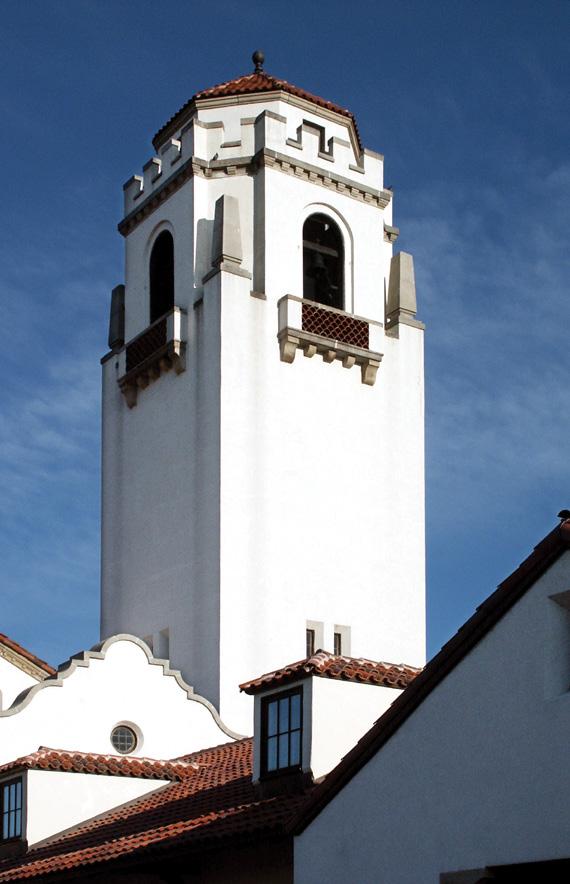
Photography
Alexzander Ellenbogen, Unsplash
For association or publication information:
IFEA World Headquarters 10400 Overland Rd. #356 Boise, ID 83709, U.S.A. +1.208.433.0950 Fax +1.208.433.9812 http://www.ifea.com
Festivals are always a fun time, but they do come with their own set of inherent risks. Be proactive and protect your event with Haas & Wilkerson Insurance.

Entertain the idea of insurance solutions for your festival including food, music and cultural heritage, art, agriculture, and more. Get traditional property and casualty insurance customized to your unique industry needs. With more than 80 years of experience and access to exceptional markets, we’re able to provide quality solutions that are cost-effective and event-specific.
hwins.com/GoodTimes


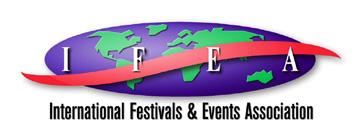
 BY STEVEN WOOD SCHMADER, CFEE
BY STEVEN WOOD SCHMADER, CFEE
We have received a number of requests to share my opening comments at our recent IFEA 65th Annual Convention, Expo & Retreat, presented by Haas & Wilkerson Insurance, last month in McAllen, Texas. As we all close out the unimaginable chapter of the last three years and look forward to the New Year, with all of its many hopes and possibilities, I am pleased to share them below:
Good morning and welcome! This is certainly the moment that we have all waited for, and looked forward to, for so long. The universe has aligned again and here we are!
Singer-songwriter Leonard Cohen may have expressed it most succinctly, with a simple ‘Hallelujah!’
He noted, in an interview before his passing in 2016, that the world is full of conflicts and things that cannot be reconciled. But there are moments when we can reconcile and embrace the whole mess, with others who understand, and that’s what he meant by ‘Hallelujah!’ So, with that definition in mind, by all means…‘Hallelujah!’
For the past three years we have all navigated a journey, together, that none of us could have predicted, nor imagined. A pathway filled with endless hurdles that have felt like some twisted video game, where the reward for successfully completing or mastering one level, simply sent us into a new and more complicated level. Moving faster; adding new parallel challenges; and testing our resolve at every step of the way.
We all went through a crash course in health and safety – from masks and vaccines, to hand sanitizing and safe distancing. We retrained ourselves to find, understand, and secure every short-term/ one-time government funding source, until we could begin to recapture more sustainable revenues again, and start refilling our depleted reserves. We maneuvered through supply chain, vendor and labor shortages. We imagined, mastered and created new virtual event frontiers that had not been a part of our toolkits until 2020. We met new challenges with our human resources (staffs and volunteers) and workforce management realities, as offices closed and we began to work from home. We worked to manage the expectations of our boards, our stakeholders, and ourselves, as we did our best to learn the rules of this new game.
We stressed over the rising costs on virtually every front and line item. We charted new courses through changing city and sponsor partnerships. We did our best to embrace pivotal location changes
and to understand fluctuating attendance trends. We watched as any possibility of festivals and celebrations were shut down by war in the Ukraine, with our professional peers in that country still working to provide any small semblance of hope for those who live there, in any safe space they can find. And we rode the waves and impacts of climate change, gun control, drug control, and other political issues/protests that continue to touch our events and communities, mixed with our far more positive diversity, equity, inclusion and accessibility desires and expectations that we would like to focus on. And we witnessed a far too quick return to the tragic risk management world that we thought and hoped we had left behind.
It has been a cycle that has tested (literally, figuratively and mentally) the health of our events; our partners; our communities; our countries; our world; our teams; and each of us, individually.
I have watched – from a front row seat – as we have taken our bumps and bruises and scrapes. I have watched in some instances, as doors have reluctantly closed, for good. I have watched as some remarkably talented professionals have made their decisions to move on. And I have, like all of you, come close to the wall on multiple occasions and voiced quietly to myself, “no more.”
The worst position that an event professional can find themselves in, is one where we do not control the circumstances. The last few years have placed us all in that untenable position, on multiple fronts, and none of our choosing. Off balance on our best days. We have survived by being constantly reactionary, with no history or ‘best practices’ to reference; embracing new learning curves that have often been straight up; and welcoming the invaluable support of our global peers as we all worked to make sense of the circumstances together. But despite the challenges, which continue to morph, like a Covid variant, into new and still uncertain ones, we, too, have all gone through our own metamorphosis – as individuals and organizations - and we are ready, once again, to be proactive vs. reactive; visionary vs. protectionary.
In Stephen Sondheim’s recently reopened, Tony Award-winning, Broadway musical ‘Into the Woods,’ the main characters share a wish that we can all relate to, more than ever before…a wish to go to the festival. And just as the musical itself is an analogy for life, it is fitting that a festival is used as the representative reward for many dreams and wishes.
To get to the festival, and to achieve all of their respective goals and desires, the characters must first go ‘into the woods’…a journey and place of uncertainties; danger; loss; life lessons; intertwined lives and relationships; and personal introspection…a place of wolves, and witches, and giants, and curses. A journey that brings them all to a point of pleading ‘no more;’…“no more giants; no more quests; no more witches; no more riddles; no more tests; no more curses… just no more.”
But through – and as a result of – their individual and collective challenges, and the new pathways that each chooses to follow, the characters go through their own metamorphosis. Some leaving – halfway through the woods; some thriving; but all changed for good.
In the three years since we last came together, we have all been ‘into the woods’…and we are not the same people who gathered together three years ago in Williamsburg, Virginia. The festivals and events industry…our events; our organizations; our host communities; our teams; our sponsors; our vendors and suppliers; our attendees; and each of us, as industry leaders and individuals… have gone through an unprecedented metamorphosis, not of our choosing. A metamorphosis that, while stressful (as metamorphosis can be in all of its forms) has arguably left us stronger; more creative; more resilient; more aware; more connected; and more important to our cities, states, provinces, countries and world, than ever before.
And now, this is our post-metamor phosis moment. Our first in-person gathering since 2019. A moment that we have waited for and looked forward to. A moment that all of us fought to be here for. A moment that I hope we all will seize and maximize. It is our moment. It is your moment.
As we reflect (not dwell) upon what we have been through, to better understand the uncertainties that continue in many spaces, in the days ahead, we will have a unique opportunity to continue our meta morphosis, but this time proactively vs. reactively – on our terms – with the friends and professional peers who can help us to re-energize; to reimagine our events; to reconnect with our communities; and to expand our reach and influence. To identify solutions vs. problems. To become the best version of ourselves – surer; smarter; more caring; more capable; more flexible; and better prepared - as we move into the future, together.
And as we gather here in McAllen (much like the Monarch butterflies do each year to start their new chapters) to take control of our destinies again - beyond the educational sessions, and the Affinity Groups, and the Expo negotiating - I would encourage all of you to embrace this moment from a different approach, for the mental health and motivation that we all need to protect along our journey.
I encourage you to:
• Re-find yourself. Remember the moment that you discovered the magic of this unique and special industry that we all get to be a part of and find a way to reinspire that part of who we all are. Don’t ever let that get lost or let yourself get too far away from those parts and pieces that drive your passion.
I encourage you to:
• Remember the many moments when all of your hard work, and stress, and frustrations, came together to provide unforgettable moments that families, and friends, and others in your respective ‘communities’ will treasure and cherish forever. That is why we do what we do and it is needed more today than ever before.
I encourage you to:
• Remember and celebrate the obstacles, challenges and hurdles that you (and your team) have made it through successfully. I am confident that there are many. And be thankful for the many IFEA friends and professional peers, from around the world, who have stood with us and shared with us and made the journey of the past few years beside us. With those friends…to steal another musical line from ‘Into the Woods’…“no one is alone”.
I encourage you to:
• Remember the lives that you have touched (directly and indirectly), and get to touch, every day through moments that you create.
Earlier this year, I was approached by my physical therapist and friend, who has a patient with an incurable disease that will slowly take away his ability to move and function normally. He shared his ‘bucket list’ with my friend; one of which was to attend the Indianapolis 500. I reached out to Bob Bryant, President & CEO of the 500 Festival, who graciously provided a special opportunity for him to do so, with VIP treatment at the 500 Festival Parade and events, and tickets to the Indy 500.
Immediately following his experience, my friend forwarded to me a text from
his patient that read “All I can say is this was an unbelievable, unmatchable experience!” After a phone call with his patient, my friend reported that “He is sooooooo appreciative for this experience! His voice…his stories…his enthusiasm…were palpable!”
Among Bob’s other event wins, he can safely include ‘life touched; milestone created.’ And we all have the power to do that every day.
Many miles away in Asia, an event management student in South Korea, who has befriended a number of us over the years, shared a copy of her impressive master’s thesis. And in her closing notations, she thanked us “for showing her a bigger world.” Never underestimate the power that your actions and friendships and kindness can have on others – often unseen. I hope that we can all create many more of these positive and lasting moments, as others go through their own (planned and unplanned) metamorphoses.
I encourage you to:
• Remember that our communities and our world need us - more than ever - to create more moments that will bond them closer together; remind them of and help them to celebrate who they are at their best; allow them to reflect on and deal with their own losses and chal lenges from the past three years… individually and collectively; and provide them with new and positive things to look forward to.
Grace, an avid festival-goer, told ‘The Conversation’ in a recent interview, “I don’t know what happens when you walk through the gates of festival…you leave behind your concerns and step into what feels like a more authentic version of yourself.” That is what we all provide…and how great is that? I would argue that we are all mental health providers in a badly divided world.
I encourage you to:
• Remember the moments when others have been there to support and encourage you, and make a point of being there to support and encourage others. Ernest Hemingway once wrote: “One person alone ain’t got no chance.” As an industry, let’s commit
ourselves to never letting that happen among our friends and peers.
I encourage you to:
• Be intentionally forward-looking and realistically optimistic. Our problems won’t all go away… we can’t control that. But how we handle them, and imagine them, is in our control.
I encourage you to:
• Learn something new; meet some one new; experience something new; and share something new… your time; an ear; or an idea; here at this convention and throughout the year…virtually and in-person. That active connectivity will change how you see the world…close to home and globally.
And I encourage you to:
• Strive purposely to dream new dreams that have yet to be imagined; for our events, our communities, our industry, our world…and for yourself. Dreams have a special magic that keep us inspired; motivated; energized; and make life – ours and others - meaningful.

The thing about metamorphosis, is that it is a cycle that never ends. Like life, it is continually changing, and often very hard. To be certain, we will all have to go back ‘into the woods’ at some point…to get to the festival…but when they beckon, or we must, even against our choice, we will be ready. And there will always be new witches and giants and unforeseen challenges there… but we will be ready, because everything we learned there, over the last three years, will help us when we must return there, as we clear new paths
and light the way for those who follow behind us. We may just have to be happy with ‘limited test group practices’ vs. ‘best practices’ for a while!
After a three-year Covid-induced hiatus, we are excited to welcome you, and your professional peers, to the 65th Annual IFEA Convention, Expo & Retreat, present ed by Haas & Wilkerson Insurance. A family reunion. A celebration. A leadership summit. An educational conference. And a united new reset for our global industry.
A metamorphosis, and a moment, that I am confident will change us all for the better.
On behalf of the IFEA World staff and team, including all of our volunteers, local hosts, speakers, sponsors, service provid ers, exhibitors, and boards, I welcome you to McAllen and the IFEA.
Wishing you all a safe, happy and healthy holiday season and a bright, hopeful and prosperous year ahead!
Steven Wood Schmader, CFEE President & CEOFeaturing participant discussion between some of the top professionals in our industry today, IFEA’s Virtual Affin ity Groups provide an online platform on ZOOM* to keep the connections, brainstorming and networking going. Join us to participate-in these valuable discussion groups and network with your peers. Be sure to come with questions and professional experiences to these valuable open-topic dialogue sessions taking place each month as we’ll be discussing current trends, issues, challenges and opportunities.
IFEA SPONSORSHIP VIRTUAL AFFINITY GROUP
Meets at 12:00 p.m. – 1:00 p.m. MT
Moderated by: Patrick Merna Vice President of Strategic Partnerships 500 Festival, Indianapolis, IN
Moderated by: Josh Reichart Senior Manager, Partner Activation 500 Festival, Indianapolis, IN
IFEA ART EVENTS VIRTUAL AFFINITY GROUP Meets at 2:00 p.m. – 3:00 p.m. MT Moderated by: Stephen King, CFEE IFEA World Board Member Executive Director of Des Moines Arts Festival

IFEA CITIES, CVB’S & TOURISM VIRTUAL AFFINITY GROUP
Meets at 12:00 p.m. – 1:00 p.m. MT
Moderated by: Mandy Watson Special Events Manager Dept of Parks, Recreation & Tourism City of Greenville
IFEA MARKETING & PR VIRTUAL AFFINITY GROUPS
Meets at 2:00 p.m. – 3:00 p.m. MT
Moderated by: Dave Bullard
IFEA Foundation Board Member Public Relations and Marketing Manager The Great New York State Fair
IFEA’s Virtual Affinity Groups are available to current IFEA Members as one of the many valuable benefits for being a member of the IFEA. If you’re interested in networking and brainstorming with your peers in the virtual networking Affinity Groups, we encourage you to join the IFEA to participate, in addition to receiving many more great benefits. LEARN

IFEA VOLUNTEER PROGRAMS VIRTUAL AFFINITY GROUP Meets at 12:00 p.m. – 1:00 p.m. MT Moderated by: Alex McNulty Manager, Member Services Pasadena Tournament of Roses


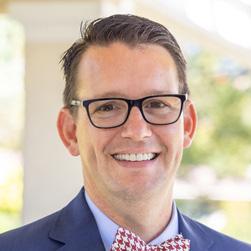
Moderated by: Erin Jackson Marketing & Events Specialist Gravina, Smith, Matte and Arnold Marketing & PR Firm
IFEA PARADES VIRTUAL AFFINITY GROUP
Meets at 2:00 p.m. – 3:00 p.m. MT
Moderated by: Ed Bautista, CFEE Chief Creative and Strategic Officer Bautista Event Specialists Team


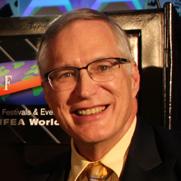

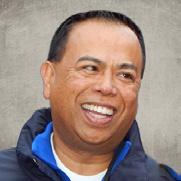
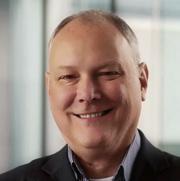
IFEA DIVERSITY, EQUITY & INCLUSION (DEI) VIRTUAL AFFINITY GROUP Meets at 10:00 a.m. – 11:00 a.m. MT Moderated by: Steve Schmader, CFEE President / CEO International Festivals & Events Association

IFEA OPERATIONS VIRTUAL AFFINITY GROUP Meets at 12:00 p.m. – 1:00 p.m. MT

Moderated by: Becky Genoways, CFEE President
Genoways Event Management
Moderated by: Ira Rosen, CFEE
IFEA Foundation Board Member Associate Professor / Director of the Event Leadership Executive Certificate Program Temple University
IFEA CEO VIRTUAL AFFINITY GROUP Meets at 2:00 p.m. – 3:00 p.m. MT
Moderated by: Jazelle Jones IFEA World Board Member Deputy Managing Director / Director of Operation City of Philadelphia Office of Special Events
 BY DIANA MAYHEW, CFEE
BY DIANA MAYHEW, CFEE
It was wonderful to see so many IFEA members back in-person at the 65th Annual IFEA Convention, Expo & Retreat, presented by Haas & Wilkerson Insurance, as we were enthusiastically and warmly welcomed in McAl len, Texas by Mayor Javier Villalobos; our good friend, Joe Vera; and the entire city of McAllen. The tastes, sounds and spirit of McAllen were woven through the entire week. Inspirational speakers from the opening event to the closing session brought this Convention to a new level. Thank you to IFEA President & CEO, Steve Schmader, CFEE and the entire IFEA team for their hard work and dedication in the extensive planning and execution that brought us all together. It was such a pleasure to spend time with so many colleagues and engage in so many energizing conversations. The membership of this organization is truly the heart of IFEA and I am so grateful to have connected with so many of you and look forward to continued conversations throughout the coming year.
Thank you to IFEA Foundation Board Chair, Alison Barringer, CFEE, for her leadership, as well as the support of the entire IFEA Foundation Board. The Foundation Board worked throughout the year to present a fun and successful fundraising event that was a result of their dedication, creativity and hard work.

As we wrap up 2022, the IFEA World Board members would like to thank all IFEA members for your support and engagement throughout the year. We greatly appreciate your input and
participation as we all work together to strength en and build this industry Please remember not only to renew your membership, but I would like to encourage and challenge each and every one of you to reach out and bring one new member along with you for the coming year. The IFEA strives to invest in each one of their members and we hope you will continue to get involved and be a part of the growth and sustainability of the organization.
It has been my pleasure to serve as the IFEA World Board Chair this year. Thank you to all of our members who support this important organization and for many of who reached out to me during the year with input, feedback and contributions to IFEA. My hope is that the membership continues to be active and invests back in IFEA for the future.

In closing, I would like to welcome Karen Churchard, CFEE, Director of Tourism and Events for the City of Scottsdale, AZ, who is the incoming World Board Chair for 2023. We look forward to hearing more from Karen in the coming months.
Best wishes as you carry out your events this fall and plan and execute your events in 2023!
CFEE Diana Mayhew, IFEA World Board Chair President National Cherry Blossom Festival Washington, DC
D.C. dmayhew@ncbfdc.org

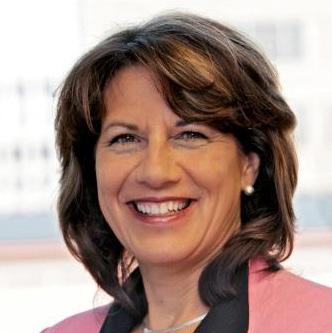
IMMEDIATE

DAVID
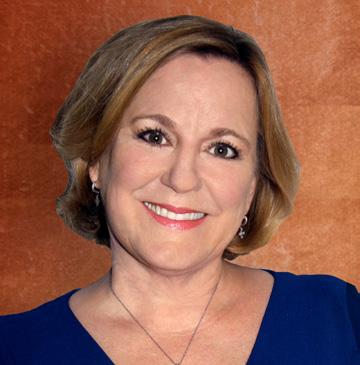
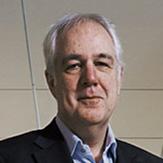

BOB BRYANT 500 Festival Indianapolis, IN bbryant@500festival.com

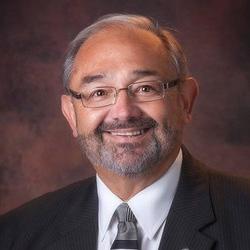

CINDY LERICK, CFEE Art of Events, LLC. Fort Myers, FL cindy@artofeventsllc.com
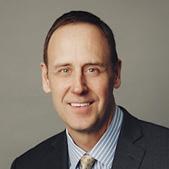
STEPHEN
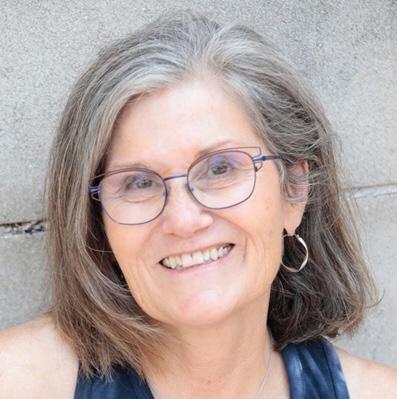
JOE
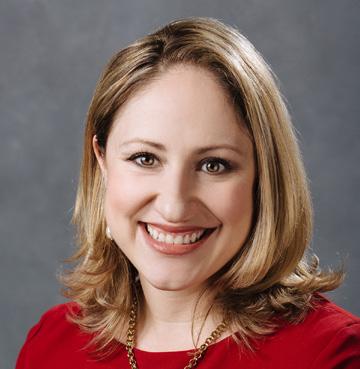
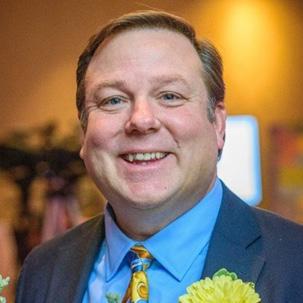
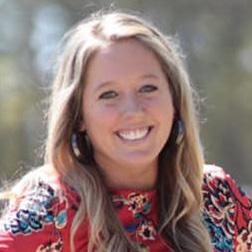


KELI O’NEILL WENZEL, CFEE O’Neill Marketing and Event Management Kansas City, MO keli@oneillevents.com
The IFEA World Board of Directors is an elected, non-compensated body of industry professionals respon sible for overseeing the successful operations of the IFEA. In addition to approving policy and direction, Board members serve as an active and involved industry leadership advisory source to the President & CEO. Members proactively support IFEA programs and visions through their input, use of their professional networks on behalf of the association, and personal participation in association programs and activities.
DIANA MAYHEW, CFEE National Cherry Blossom Festival Washington, KAREN CHURCHARD, CFEE City of Scottsdale Scottsdale, AZ kchurchard@scottsdaleaz.gov EADS Pasadena Tournament of Roses Pasadena, CA deads@tournamentofroses.com JOHAN MOERMAN Rotterdam, The Netherlands johan@johanmoerman.eu JAZELLE JONES City of Philadelphia Office of Special Events Philadelphia, PA Jazelle.Jones@phila.gov WARWICK HALL, CFEE Safety Set Consulting Section 646 Taupo, New Zealand contact@s646.com STEVEN WOOD SCHMADER, CFEE IFEA World Boise, ID schmader@ifea.com PAST CHAIR TED BAROODY, CFEE Norfolk Festevents Norfolk, VA BaroodyT@festevents.org KING, CFEE Des Moines Arts Festival Des Moines, IA sking@desmoinesartsfestival.org VANESSA VAN DE PUTTE DFEST ® San Antonio, TX vanessa@dixieflag.com ALISON BARINGER, CFEE IFEA Foundation Board Chair North Carolina Azalea Festival Wilmington, NC alison@ncazaleafestival.org SAM LEMHENEY, CFEE Creative Event Solutions Philadelphia, PA sam@creativeeventsolutions.com VERA, CFEE City of McAllen McAllen, TX jvera@mcallen.netWell, we did it! After a long three-year hiatus, we finally came together in-person as an industry to swap pandemic stories, celebrate our successes, and hug our festival friends again! Thank you to all who showed up for the 65th Annual IFEA Convention, Expo & Retreat, presented by Haas & Wilkerson Insurance. The hospitality from McAllen, Texas was top-notch, the drinks from DFEST Hospitality Suite were ever-flowing, and the education and networking were next level. I enjoyed meeting new industry professionals, and hope many of you did too. Now would be a great time to pen a quick note to a new IFEA friend to say hello. Pro tip: cut through all the email spam chatter and send it via snail mail for more of an impact!
I want to give a huge personal THANK YOU to all who joined us at the IFEA Foundation Fiesta: Una Noche Magica! We had a great night under the stars raising funds to support our industry. Thank you to all who donated auction items, bid on auction items, bid on Ultimate Experiences, and bought 50/50 tickets. I am so proud to say, together, we raised more than $40,000!! These important funds will be used to provide education for the future “us” –providing speakers for the next convention, technology needs for the IFEA and the Convention, and scholarship opportunities for future industry leaders.
Didn’t attend the Convention? You can still be a part of this group effort to support the IFEA and the continued education of its members. When pondering what your end-of-year giving should be, please consider a donation to the IFEA. The IFEA has played an instrumental role in spearheading, supporting, and sharing the transformation our industry has been through due to the pandemic. Over the past years the IFEA has organized Covid Task Forces, held virtual IFEA Days, increased industry Webinars and Affinity Groups, and broadened fundraising efforts. All of these were planned and executed to give you and your organizations tools to survive during such trying times. You can now pay it back by paying it forward and support future educational opportunities for us all.
As we approach the end of the year and the beginning of the next, I encourage each of you to take time to think about your own growth mindset. What can you do personally and professionally to “level up” in 2023? What extra education or networking can you do? Take a moment to look at the opportunities IFEA provides that can assist in your growth. Have you looked into the CFEE Certification? The CFEE (Certified Festival & Event Executive) Certification states to other industry leaders and peers that you have made all the efforts to be a top event professional. As a
 BY ALISON BARINGER, CFEE
BY ALISON BARINGER, CFEE
CFEE graduate, you will have taken core education classes in: Non-Sponsorship Revenue, Project Management, Operations/ Risk Management, Marketing & Media Relations, Administration & Management, and Sponsorship/Sponsor Service. You will have published a written publication and performed a speaking presentation. You will have the experience necessary to call yourself an industry leader! Did I mention you’ll share a bond with your classmates, making new friends and networking contacts along the way? I just graduated with my CFEE, and let me tell you, it was FUN standing up there on stage at the IFEA Convention with all my new friends, accepting our graduation certificates!
Also check out the IFEA Virtual Affinity groups. You can network and learn with other industry professionals in the categories of: Arts Events; CEO; Cities, CVB’s, and Tourism; Diversity, Equity, and Inclusion; Marketing & PR; Operations; Parades; Sponsorship; Volunteer Programs. There is no better place to troubleshoot on your troubles and share in your successes than in these groups.
As we close out 2022, from the bottom of my heart, I want to thank you for allowing me the opportunity to serve as the IFEA Foundation Chair. I also want to take this time to thank the IFEA Foundation Board of Directors and the IFEA staff. You all have made my time as Foundation Chair enjoyable and rewarding. Your determination, support, and willingness to serve allowed us to exceed our goals – and have fun doing it!
A huge kudos to Kevin Grothe, CFEE, past IFEA Foundation Chair, who served this organization for two years during the pandemic shutdown, and who also served as the live auctioneer for this year’s Foundation Fiesta Party. I’m not sure which role was more challenging – but you did both with humor, humility, and success!
Lastly, let’s all give Cassie Dispenza, your 2023 IFEA Foundation Chair, a huge welcome as she takes over the reins of the Foundation Board. I am confident she will continue to move the Foundation into a period of growth and sustainability. Congrats, Cassie – and best of luck!
 Alison Baringer, CFEE
IFEA Foundation Board Chair Executive Director
Alison Baringer, CFEE
IFEA Foundation Board Chair Executive Director
North Carolina Azalea Festival Wilmington, NC
ALISON
North Carolina Azalea Festival at Wilmington, Inc. Wilmington, NC alison@ncazaleafestival.org
CHAIR-ELECT CASSIE DISPENZA Saffire Austin, TX cassie@saffire.com

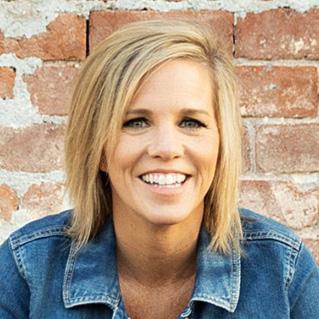
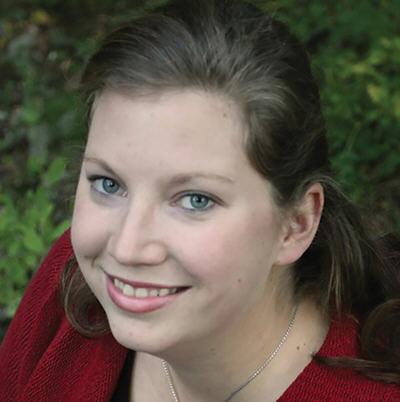


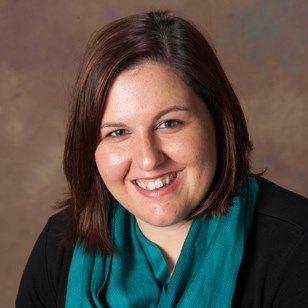
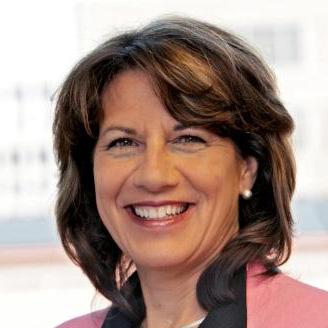
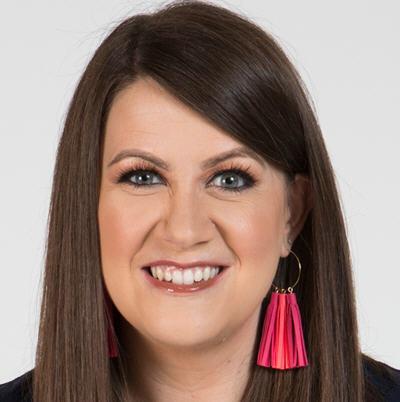
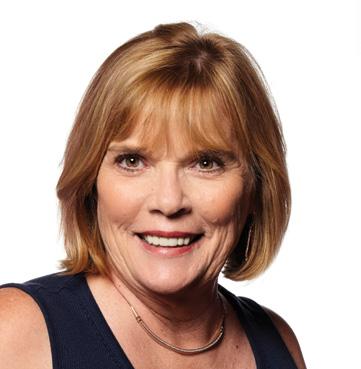
KAT PAYE, CFEE
National Cherry Festival Traverse City, MI kat@cherryfestival.org
LUANN CHAPMAN
The Gatts Group Grapevine, TX luchap@aol.com
ERIN FORTUNE, CFEE
Music for All Indianapolis, IN erin.f@musicforall.org

CURT MOSEL

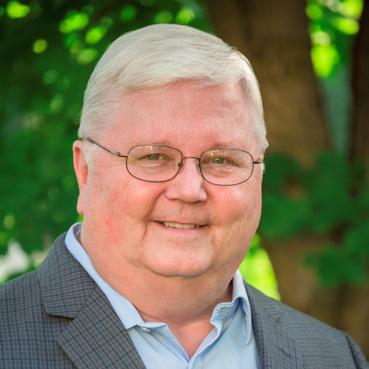
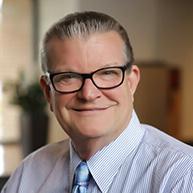
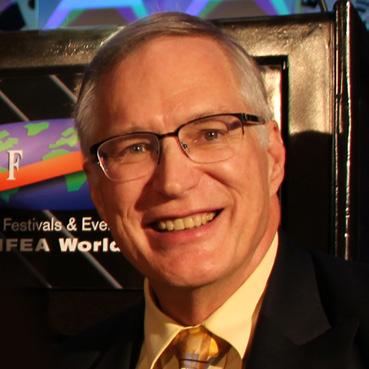
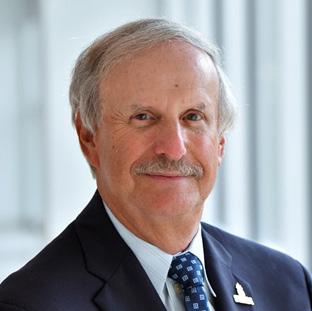
ArtsQuest Bethlehem, PA cmosel@artsquest.org
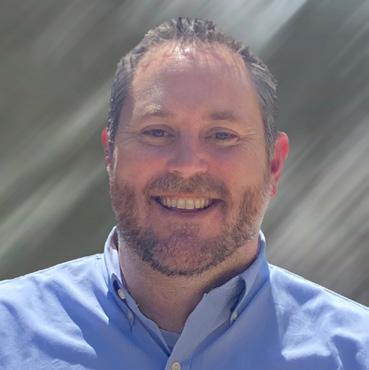
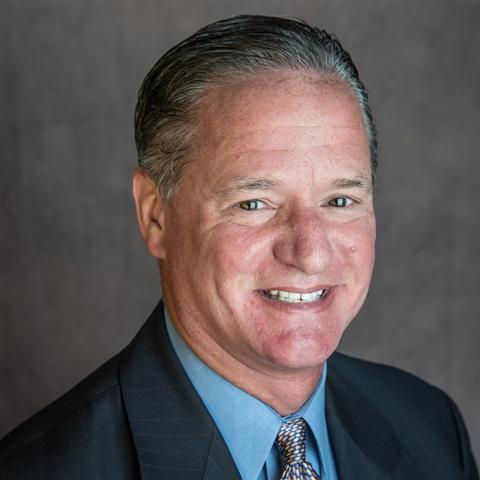
Des Moines Arts Festival Des Moines, IA cmurphy@desmoinesartsfestival.org
IRA
irosen@temple.edu
dave.bullard@agriculture.ny.gov
dknutson@santa-clarita.com
bas@kaliff.com
STEVEN WOOD SCHMADER, CFEE
IFEA World Boise, ID schmader@ifea.com
National
Festival Washington, D.C. dmayhew@ncbfdc.org
The IFEA Foundation Board of Directors is an elected, non-compensated body of industry professionals responsible for overseeing the successful oper ations of the IFEA Foundation. Members proactively work to raise and secure important funding that helps to support and protect the educational mission of IFEA World.

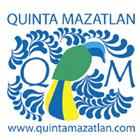


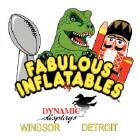


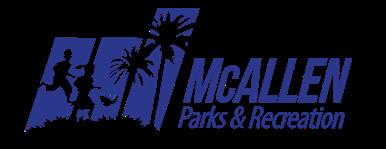
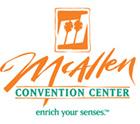



The 65th Annual IFEA Convention, Expo & Retreat presented by Haas & Wilkerson Insurance made a triumphant return this past September 19-21, 2022 in McAllen, TX, U.S.A.! And what a return it was! The IFEA would like to thank all who attended the Convention in addition to a special thank you to all who contributed their time, resourc es and efforts in making the Convention such a great success, especially the City of McAllen and their amazing team who went to great lengths to help make the Convention possible!
To view more convention photos and details, Click Here
We look forward to seeing you again in 2023 for the 66th Annual IFEA Convention & Expo which will be held in… Watch this space for more details! Exact Location and Date to be announced soon!
Thank you to all of the 65th Annual IFEA Convention, Expo & Retreat Sponsors
Presented by
 By Ira L. Rosen, MA, CFEE
By Ira L. Rosen, MA, CFEE
The theme of the recently completed 65th Annual IFEA Convention, Expo and Retreat, presented by Haas & Wilkerson Insurance was Metamorphosis. To paraphrase from IFEA President & CEO, Steve Schmader’s letter in the Convention program, “we have a unique opportunity to re-energize, to reimagine our events, reconnect with our communities and expand our reach and influence.” The general session entitled “Inspire the Industry – Crystal Ball … Proactively Preparing for the Future” certainly gave us the opportunity to capitalize on the theme of metamorphosis.
The premise behind this session was relatively simple: We all know what we have been through over the past few years. What key elements will our industry need to address as we emerge from what has happened and what will drive us forward into the future? The panel consisted of long-term industry experts reflecting a diverse group of constituen cies, large and small markets, low budget to high budget events, global diversity, etc. I was asked to moderate the panel, which consisted of the following people:
• Ted Baroody, CEO – Norfolk FestEvents, Norfolk, VA, USA
• Jasmine Freeman, CFEE, Senior Management Analyst – City of Las Vegas, NV, USA
• Matt Gibson, President & CEO –Kentucky Derby Festival, Louisville, KY, USA
• Jazelle Jones, Deputy Managing Director – City of Philadelphia Office of Special Events, PA, USA
• Keli O’Neill-Wenzel, CFEE, President & CEO – O’Neill Events, Kansas City, MO, USA
Johan Moerman, Consultant from Rotterdam, The Netherlands also participated in the planning process but was unable to be in attendance.
In initial meetings, the panel took a long list of challenges and consolidated them into 5 key themes. The themes were:
1. Health safety/security
2. Over Saturation/ Governmental
partnerships
3. Economics
4. Human resource issues
5. Environmental sustainability
The first part of the session consisted of a moderated discussion of the topics, while the second part consisted of small groups discussing the themes and developing potential paths forward.
This article is a summary of the conversations that took place during the sessions and an action list of what we should consider as actionable items for the future.
Health safety/security, including future potential pandemics, gun, and other weapon violence.
Prior to the pandemic, festivals and events were always concerned about the safety and security of their customers. This concern has only grown in the post pandemic era and in addition to all our past challenges, we now must add the concern over the literal physical health of our staff, our volunteers, our vendors and our customers. Clearly there is a renewed focus on the health, safety and security of our customers. Everyone agreed with the fact that if people do not feel relatively safe, they will not come to our events. None of us are first responders and where does our responsibility lie in terms of providing safe environments. What are some of the things that we can do to help
deal with these issues?
1. Control the space – consult with appropriate legal entities to determine what rights we must exercise in order to limit completely open access. Can we prohibit people from entering with weapons, for example. This issue is extremely contentious and subject to local, state and federal regulations. Recognize that most of us are not lawyers, but this is certainly a topic that we need to address with the appropriate legal authorities.
2. Be honest in your communica tions – Recognize that there are no 100% safe spaces in this day and age, but honestly communicate what your event is doing to mitigate risks to your customers. Most customers expect a level of security, so we need to promote our efforts through public relations methods. Secondly, we actually have to implement these measures, not just talk about them. One workshop participant used the phrase “security theater,” where we just put in “band-aid” measures without really addressing the issues. The consensus was that we need to avoid this at all costs.
3. Stay informed about legal issues – Laws and legal precedents are constantly changing. It is our obligation to stay current on relevant topics.
4. “You can’t get ready – you have to be ready.” This was a key comment from one of the panelists which really summarized the whole safety and risk conversation.
TOPIC 2:
Over Saturation/ Governmental partnerships, including how to work with governmental agencies in the current world of reduced staffing, lack of police, lack of staffing, etc. Additionally, are there too many events for communities to handle, from customers, to residents, to service providers?
There was a consensus that partnerships between event producers and governmental entities were essential prior to the pandemic, and that they have become even more important as we move forward. There were several comments about the topic of oversaturation – the belief that in some areas there are just too many events. Clearly, every participant in this discussion loves putting on events. However, with shrinking governmental resources, and ever tightening corporate sponsorship budgets, this is a potential
concern for the future. Although there is no concrete solution for this, there was some consensus that festivals should begin to emphasize quality over quantity and maybe instead of doing 45 events over the course of a two-week festival, perhaps we should reduce that number and emphasize the quality of what remains.
TOPIC 3:

Economics, including expense increases, revenue challenges, supply chain issues and other challenges to the bottom line.

There was a great deal of conversation, both among the panelists and the audi ence about the challenges that we have faced over the past two years regarding economics. Clearly, without governmental programs, many festivals and events would not have survived at all. But now
gone away, how do we move forward in the future? There was general agreement that this is not a short-term issue, and that the industry will be confronting financial challenges for the foreseeable future. Expenses have increased, and in some cases have doubled. These challenges have come from supply chain issues, labor shortages and increasing demand for limit ed resources, both in terms of equipment and people. At the same time, audiences in some cases are still hesitant to fully embrace the return to live events. Some festivals have seen crowds increase, but many others are experiencing significant shortfalls in terms of revenue.
As with all our challenges, there are no simple solutions to the economic issues that we are facing, but several key themes arose from the conversations.
1. We need to develop new partnerships with vendors, sponsors, governmental agencies, other events, etc. The need to “think outside the creative solutions to critical. The concept a group of smaller events collaborates resources. line-by-line expense
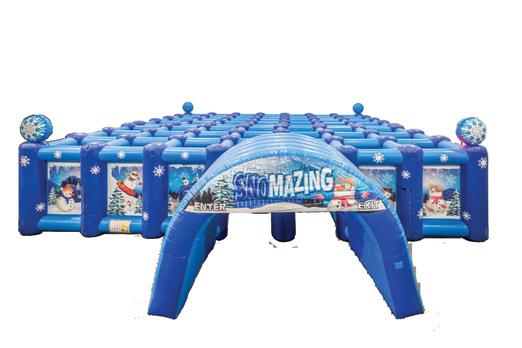


younger people interested in and engaged in the industry.
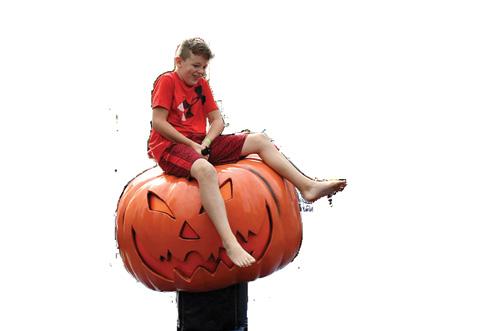
All our topics generated significant conversations, but the discussion of human resources produced several strong challenges, as well as some great oppor tunities. The recurring themes included the challenges of work/life balance, the issues and opportunities posed by diversity, equity and inclusion, the importance of emotional well-being and the generational differences between aging leaders and young staff/volunteers. One of the other challenges that presented itself was the dwindling volunteer base, as well as the fact that fewer young people want to commit to the intensity of the festival and event world, with its long hours and relatively low pay. Some of the potential solutions included the following:
1. Keep an eye on your team. Look for the signs of emotional and or physical burn out and recognize that the intensity of the event world can take a toll on both staff and volunteers.
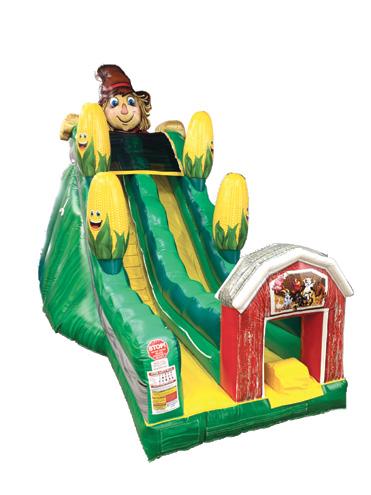

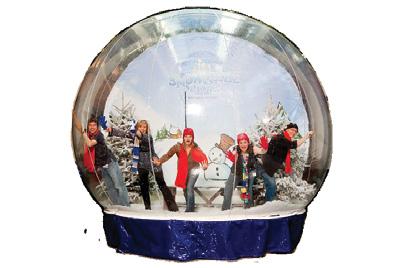
2. Compensate for the long hours. Although the group recognized that the intensity of the weeks leading up to your event can lead to a 24/7 work mode, recognize these long hours by giving staff additional personal time off, or look at 4-day work weeks in down times.
3. Take care of yourself. Self-care was a recurring discussion both from the moderators and from the workshop participants. Recognize that if the leaders of an organization are unwell, chances are pretty good that the rest of the team will recognize this and react accordingly. Take the time off, drink the wine, eat the donut!
Human Resource Issues, including
4. Set mutual expectations. If you expect staff, interns and/or volunteers to work seven days a week, let them know. These conversations need to begin during the first discussions you have with a potential employee or intern, not after that person has been hired. No one likes surprises and conflict arises in the workplace when people do not understand the expectations of the job.
mental health and time/life balance

and inclusion and we face in getting
5. Fully commit to diversity, equity and inclusion. Almost everyone in our industry recognizes the importance of DEI, but there are still surprisingly few organizations that have written DEI policies and procedures. This is a critical topic for the future and saying you are inclusive does not magically make you so. Develop a policy, develop procedures and truly commit to DEI.
“The world has changed, the audience has changed, the economics have changed, the laws have changed.”
6. Commit to professional development. So many of the conversations around human resources recognized the fact that the more resources we have, the more effective we can be. Many talked about the value of the IFEA Affinity groups and other IFEA resources that were made available during the pandemic and continue to be available today. This is an industry that requires lifelong learning and if organizational leadership commits to this concept and makes it important for their teams, we will be stronger festivals, events and human beings. As one participant said, “You never lose when you continue to educate the team”.
TOPIC 5: Environmental Sustainability, including the fact that festivals and events need to own a sense of responsibility to the planet.
The fifth and final topic also generated some interesting conversations. While everyone agreed that this is an issue which we need to address, there was a lot of discussion about the potential negative financial impact of our sustainability efforts. As an example, one of the panelists talked about the revenue loss when the decision was made to give away water at their festival vs selling it. This was certainly the right decision for sustainability efforts, but not necessarily an easy one, especially in the challenging economic times that we are facing. Some of the key takeaways from this conversation including the need to be creative in how we look at sustainability, take the opportunity to look at potential sustainability-related sponsorships and partnerships, and getting your team involved in the conversation. Also, recognize that sustainability cannot be an afterthought. If we truly want to improve our efforts, we need to think about this early in the planning stages. Some great ideas surfaced including repurposing programs where carpet used for the NFL draft was donated after the event to local recreation centers.
When the planning team began discuss ing this session, there was no expectation that we would develop earth shattering recommendations for the future, as the title
refers to a crystal ball, and none of us had a working model! Rather it was envisioned as a beginning, not an end – an opportunity to tap into the collective knowledge of the participants and to begin the journey towards developing mutual solutions as we continue to guide our industry through challenging times. Although not ground breaking, there were certainly several key recommendations and opportunities for growth which were discussed. These over-arching themes included the following key elements.
1. Recognize the ongoing importance of partnerships and relationships. These have always been critical to our industry success and the need for stronger, more creative and more varied partnerships was a recurring theme in most of our conversations.
2. Build quality over quantity. The festival model from ten years ago might just not work today. As many of us built our organizations, we believed that we needed to do more and more to satisfy our various stakeholders. This is not the case anymore and we really need to examine the model which attempts to be everything to everybody. Find your core successes and build on them.
3. Continue to educate yourself, your team and everyone around you. Professional development used to be an option for some. It is now a necessity for all. No one will ever know everything there is to know about this industry, so if we are not constantly learning, we are doing a disservice to ourselves and our communities. Utilize every resource available to you.
4. Promote value over price. Price sensitivity is an ongoing challenge, but if we are concentrating on quality and value, we can overcome these objec tions. One panelist made the comment that people will pay $15 for one piece of sushi but complain about spending $20 for a full day of festival entertainment!
5. Balance your work and life and pay attention to emotional wellbeing. This has always been a stressful indus try. If doing events were easy, everyone would be doing them! However, we can no longer ignore the emotional challenges our teams are facing. There are real mental health, emotional
wellbeing and work/life balances in our industry and ignoring them is not an option. There are also serious diversity, equity and inclusion issues and we need to be better at really addressing these challenges. Lastly, and perhaps most importantly, it is time to continue the conversation. This session, this convention, this opportunity for metamorphosis is not the end point. In order to thrive, our industry must recognize that going back to what we did prior to the pandemic is not acceptable. We need to grow, to change and to undergo a true metamorphosis. Change is not always easy, but it is necessary. To quote author William Arthur Ward, “The pessimist complains about the wind; the optimist expects it to change; the realist adjusts the sails.” Be a realist!
Ira Rosen, MA, CFEE is the Associ ate Professor of Event Management/ Program Director Event Certificate Program at Temple University’s School of Sport, Tourism and Hospitality Management in Philadelphia, PA. He teaches several event management courses and is the Program Director for the School’s award-winning Event Leadership Executive Certificate Pro gram. Additionally, for over thirty years he owned and operated Entertainment On Location, Inc. (EOL), a full-ser vice event production and consulting company based in New Jersey. Ira has done extensive work for major events and clients throughout the world. Prior to opening EOL, Ira worked for over seven years with Radio City Music Hall Productions. His production background includes the Super Bowl, multi-million-dollar parades, major corporate events around the world and tourism development projects for many different organizations. Ira has spoken at conferences and conven tions and has done training programs around the world. He has written and spoken extensively on key industry topics ranging from risk management to sponsorship to the financial and operational management of events. Ira holds Bachelor of Arts and Master of Arts degrees from Montclair State Uni versity in New Jersey and is a Certified Festival & Event Executive (CFEE). In 2005, he was inducted into the Inter national Festivals & Events Association Hall of Fame, becoming one of only 70 people in the world to hold this hon or. He has also received numerous awards and recognitions from Temple University, the International Live Events Association and many others.
“If you think we can just push the button, plug and play with our events, you are wrong.”
As we are all still coming down from the excitement of our time together at the 65th Annual IFEA Convention in McAl len, Texas this past September, I thought I would reflect a bit more on one of the topics that I had a GREAT time presenting on with all the beautiful IFEA humans!!
Being intentional leaders, we have heard the phrase…with great power, comes great responsibility. Well, the same is true of influence. Shockingly, though, it can be difficult for most people to discover and comprehend just how much influence potential they have in their workplace, at home, or even in a room full of strangers. Understanding our influence potential, though, is one of the best things we can do as leaders. Why? It allows us to grasp - and respect - the ability we have to impact others at work. And this impact shouldn’t be taken for granted! As leaders, we have an opportunity to shape and influence the way our employees and colleagues contribute to their projects and initiatives, and even connect with each other. While this might sound ideal for anyone looking to lead their teams to success, it’s important to remember that you have the power to both influence positively and negatively.
What really counts when it comes to influence is adaptability, and your inclination to adjust your approach depending on who you’re speaking to or collaborating with. Remaining nimble in these situations allows you to tailor your leadership style accord ingly, which goes much farther than simply being charming.

At the same time, it’s important to work at being approachable and clicking with colleagues. Creating this professional chemistry can lead to even more influence without overdoing it on the charm.
We are seeing many articles on leadership recognizing the importance of being a good listener. Listening is just one of the

many ways you can continue to build upon your opportunities to influence and generate more trust among others. When your team can rely on your ability to listen and respect them when they have something to say, you’ll in turn benefit from having their trust when it’s your turn to lead a conversation. Active listening skills go a long way when it comes to influence in the workplace and beyond.
You can also position yourself as influential by making it clear that you are committed to your own growth and professional development. When others recognize your efforts to better your own skills and abilities within your industry and as a leader, it reflects well on you. Prioritize continued development and growth if you hope to increase your influence.
At the end of the day, it’s important to both foster influence and recognize the power that it holds. Influence is what enables you to truly lead people, especially when things get tricky or troublesome. In times of high stress or a busy season, your people want to look to someone they can trust to right the ship while protecting their flock. Can you be that person?
Annie Frisoli is Founder & CEO of Creating Community, LLC. She hosts leadership workshops for individuals and organizations, staff retreats to build cohesive teams, and stra tegic planning sessions for teams and board members. She is a popular speaker and adds energy to any space she arrives. Annie (CFEE), is also a faculty member at the IFEA/NRPA Event Management School and serves on the IFEA Founda tion Board. For more information: www.anniefrisoli.com WITH ANNIE FRISOLI, CFEEListening is just one of the many ways you can continue to build upon your opportunities to influence and generate more trust among others.


It always begins the same way. Young people filled with enthusiasm for a fun night out with friends, put on their best party clothes and head toward the crowd ed streets. The joy of reuniting with friends following the desperate days of the Covid19 pandemic increase this enthusiasm to a level that judgement is suspended. And then, quickly, the euphoria of reuniting with friends becomes a tragic death trap due to poor planning by civic officials. And one thing is for certain, it will happen again, unless civic leaders resolve to try and prevent these catastrophes.
The recent crowd crush tragedy in Seoul Korea that saw over 153 people, mostly teenagers lose their lives due to suffocation from being crushed as they descended down a steep hill in a narrow street, was preventable. In fact, I believe that all crowd crush incidents are preventable.
India, one of the world’s most populated countries, has had the most documented notable human stampedes and crushes with 28 individual incidents. The deadliest human crush of all time, with an estimated 10,000 deaths, occurred during the First Jewish–Roman War in AD 66 and the most documented deaths, with 5,000, occurred at the Ponte das Barcas in Portugal in 1809. Since the early nineteenth century, over 200 crowd stampedes have been recorded resulting in thousands of deaths of mostly young people.
In the early part of this millennium, the Governor of the US State of Rhode Island appointed me to chair a committee inves tigating the impacts of the Station Night Club fire. In this deadly event, over 100 young adults died as they tried to escape a burning inferno that had been caused by the misuse of indoor pyrotechnics. The majority of the victims died from being trampled at the front door as they tried to escape from the same door where they had entered.
Recently, I conducted a tour in the city of Edinburgh, Scotland that was well publicised on social media. One post received 17,800 views. A few days
before the tour, I wondered what might happen if all the people who viewed the post, actually attended the tour without confirming their participation in advance? The propensity of promotion opportunities through social media should remind all event producers and civic leaders of the need to be cautious about over promoting future events that could lead to the Halloween nightmare recently experienced in Seoul.
How do we prevent these tragedies?
Over the past 100 years, very sophisti cated models have been developed for crowd assessment, analysis, planning, and control. Organisations such as the Inter national Festivals and Events Association and others, have led through their effective and well attended crowd management education programmes. However, unless our civic leaders who are ultimately responsible for applying this education and executing the plans they develop take radical action to prevent future incidents, they shall continue to recur. Therefore, I believe the following three tactics must be deployed immediately and universally to attempt to mitigate future tragedies.
Reduce the Size of Crowds
Firstly, we must reduce the size of crowds to a level that is manageable by local authorities. Therefore, those agencies responsible for issuing assembly permits must revise their maximum number of participants to a number that may be managed effectively by stewards and police. For example, if a public street cannot be dispersed and cleared by police on horseback in a few minutes time, the event should not be given permission to be conducted.
Secondly, we must provide well signed and easily accessible escape routes for crowds to ensure that in the case of over-crowding, there is always a safe and secure way to find the egress. These escape routes need to be clearly marked both above eye level and at ground level,
with symbolic signs in multiple languages so that even if individuals are forced to crawl, they can still be directed to the egress.
Thirdly, we must provide better education before and during the event for participants to help them understand the danger of being in a crowd and allow them to make the decision of whether or not to participate upon arrival. A simple announcement, both written and verbal, reminding participants that crowds may be dangerous and that they must decide whether or not to enter the crowded area, how to escape if necessary, and where to seek help if needed, is essential if we are to better protect our participants.
Throughout the world, people are now once again enthusiastically coming together to gather whilst celebrating their joys, sorrows, triumphs and other major milestones of human life. It is my view that it is the undisputed responsibility of civic leaders to insure that every person who assembles in their jurisdiction has the best possible opportunity to participate and return home safely from their events. Unless radical action is taken regarding human safety at future live events, the crowd crush episodes that we have experienced in the past century will most certainly be repeated. Whilst there is no guarantee that our participants will not be harmed at future events, we can confident ly assume, based upon past experience, that unless we are more vigilant, more young people will die from this horror being repeated again and again.
Professor Joe Goldblatt is
Professor of
at
University in Edinburgh, Scotland. He is the author, co – author and editor of over 40 books in the field of planned events. His views are his own. To learn more about his views visit www.joegoldblatt.scot
Emeritus Planned Events Queen Margaret
I spent a few days recently reading press releases, websites and social media posts from fantastic festivals large and small throughout the IFEA ecosystem, including my own. I found case after case, too many to count, of failing to put the customer first, including in my own.
Time after time, releases touted long lists of things that will take place during their events – concerts, displays, food, games, fireworks and special events. However, time after time, I also failed to find these features boiled down into reasons why people should choose your festival over going to someone else’s, or doing nothing at all.
This, friends, is the battle of features vs. benefits.
Our festivals are complicated events made up of hundreds of moving parts, all designed to lure people off their comfy couches. Each festival has its unique elements. So what? I’m here to tell you that the great bulk of people who come to your event translate your features into benefits that work for them.
“Wait. You mean that my great concerts, spectacular art, beautiful flowers and faithful historic recreations don’t really bring in the crowds?”
That’s not what I mean. I mean that the package of programming you offer needs to be boiled down to a simple and desirable benefit that will make people – and sponsors – more likely reach for their wallets.
For a great example, look no further than McDonald’s. It’s tricky for McDonald’s to tout the high quality of its food, and while they do that from time to time, they almost tend to ignore their food to sell other benefits. A new ad focused on a men’s kickball team called the Varsity Gay League. “We like to have fun,” the ad’s narrator says. “We go to McDonald’s after every game.” “The best thing about being here with you guys is just being ourselves,” another player says. They call it their “happy place.”
What did the fast-food giant just sell here? Chicken nuggets and soda? Or togetherness and love?
Another ad, squarely aimed at teens and young adults, urges them to buy a Big Mac, a fish sandwich and a chicken sandwich (helpfully sold as a combo) and put the chicken and fish into the Big Mac to make a menu hack called the Land, Sea and Air. Nowhere does it say this will be delicious.
McDonald’s spends millions on research and billions on ads and you can benefit from their work.
Here’s the opening paragraph of a press release, simulated but similar to hundreds you’ve seen and written:
“West Nowhere’s celebration of all things turnip, Rutapalooza, returns to the city’s Swamp City Park beginning Feb. 30. Rutapalooza features great live music on the Big ‘Baga, exciting childrens’ perform ers on the Tiny Turnip stage, fun root vegetable-themed games, unique art and delicious food, and much more. Admission is free.”
Okay, it’s got music, food, games and art. Like pretty much every festival on the planet, in varying amounts. We also have an extensive array of empty-calorie adjectives such as “great,” “exciting,” and “unique”. What has been said here that would make me want to go to Rutapalooza?
Not much.
Turning your features into benefits is harder. It means listening to your customers. It can mean doing some research. Here’s a way to
In one column, make a list of all your features. In the other, list the benefit your customers will derive from that feature. For example, my phone’s 12 megapixel camera (feature) lets me take crystal-clear photos and videos of my family and friends (benefit). My box from Hello Fresh has all the ingredients for dinner (feature) so I can spend less time and have less stress cooking (benefit). Now, try to articulate all of that into a single core benefit of attending the entire festival.
Almost all marketing appeals to one of three things that are import ant to us: Time, money and peace of mind. Does this product save me time or make more time in my life? Does it save me money or make me money? Does it give me peace of mind or prevent me from losing my peace of mind? (That last one, peace of mind, is a little harder to define than the others, but think about insurance. We buy it to ease our minds about what happens if we get hit by the proverbial bus.)

Then there’s Maslow’s Hierarchy of Needs – physiological needs such as food, shelter, safe air and water are at the base, with Safety next, then Love and Belonging, Esteem, and at the top, Self-Actualization, or becoming all you can become.
When we asked people why they came to our event, they mentioned food, music, rides, animals – everything you’d expect them to say. But one result stood out: 95% of the people who come to our event do not come alone. It’s a family outing, date night, a night with friends. Then we made word clouds of the open-ended responses in our surveys and it turns out many of the most-used words depict emotions, like love, fun, family, safe, tradition.
Which got us to our final benefit statement: The Fair is time well-spent with people you love. It’s a frame for our marketing and a dead-simple thing we can say on social media. Some of our social posts show people in groups, having a good time. Our TV spots showed happy families and fairgoers sharing a kiss.
Once you unlock the secret of the subconscious reasons people come to your event, your marketing language will improve and you’ll be able to leave wimpy adjectives in the dictionary where they belong.
Now it’s your turn. Go gett’em.
Dave Bullard is the Public Relations and Marketing Manager for The Great New York State Fair in Syracuse, the nation’s first and oldest state fair, dating to 1841. He has spent his entire life in and around media, spending many years in print, radio, TV and online media in addition to running a solo PR, marketing and video production business and founding one of the nation’s first online-only local news publications in 1999.
Dave is also the moderator for the IFEA PR and Marketing Virtual Affinity Group every 2nd Tuesday of the month and welcomes you to attend their monthly chat! Dave can be reached anytime at dave.bullard@agriculture.ny.gov and is here to support the great people and events of our industry. Don’t hesitate to drop him a note with suggestions, thoughts or counterarguments anytime.
YOU’VE GOT GREAT CONTENT.WITH DAVE BULLARD

Easy ordering, and quick set-up, ATOMIC Modular Systems’ award-winning arsenal of modular backdrops, columns, arches and walls are a “packs small, plays big” solution for any budget with flexibility for customization and branding.

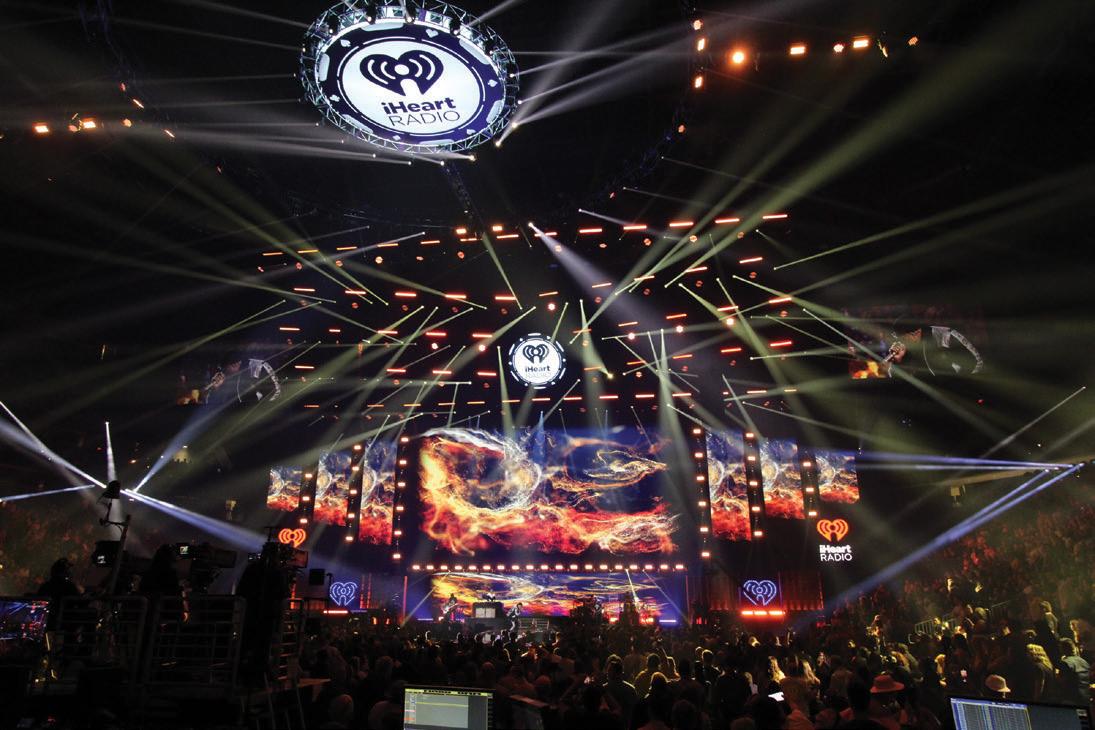
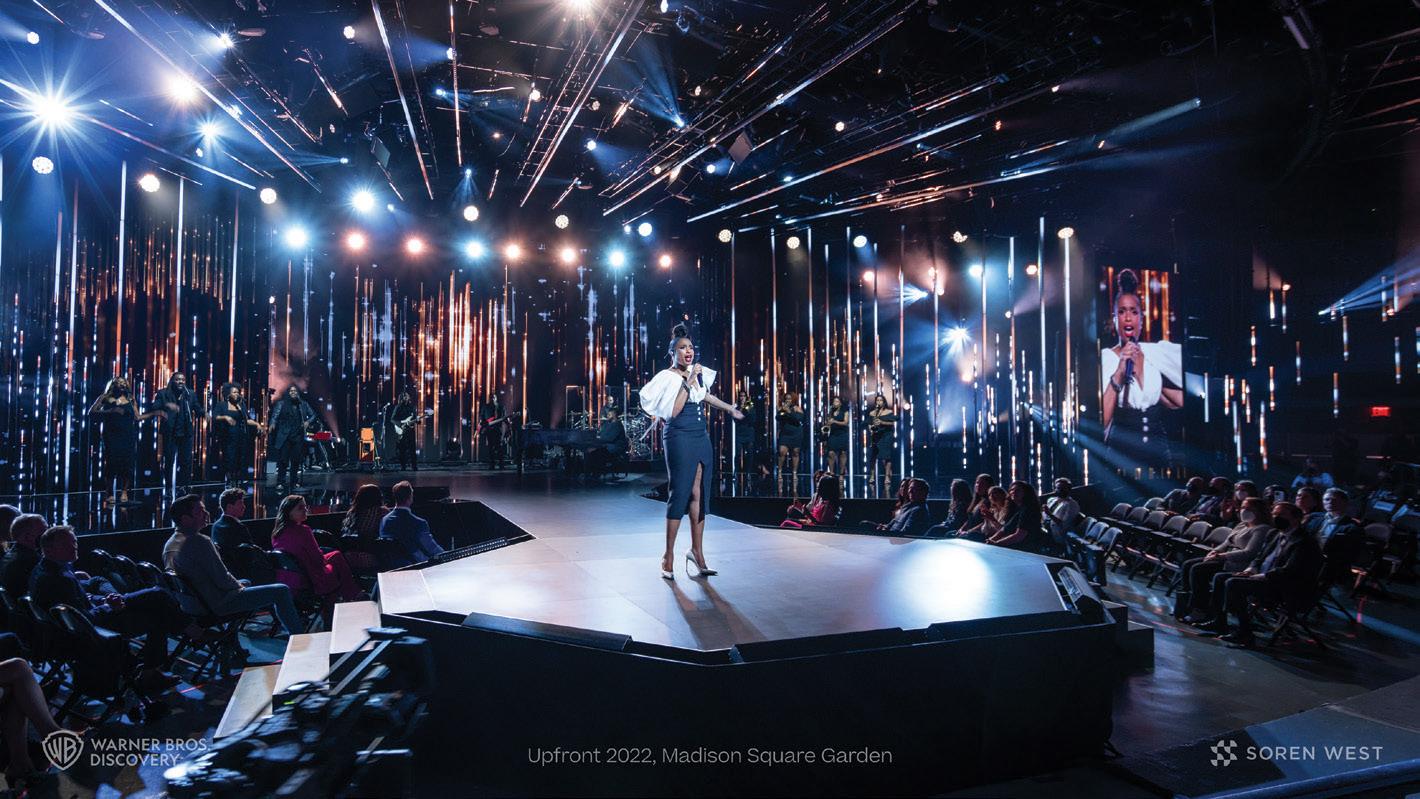

Using the latest design software, 3D visualization tools and decades of experience in the live event industry, we create stimulating visual designs that push boundaries.
From concept development to executing the smallest of details, our producers, creatives and innovators are versed in every aspect of your live event.
ATOMIC creates live environments that engage audiences and make a bold impression.
Proud to insure excellence in the festivals & events industry

Over the past few years, the festivals and events industry has been faced with challenges that we never could have imagined, let alone prepared for. Those unprecedented challenges called for unprecedented responses so we adapted, we ‘pivoted’, we went virtual, we postponed and sometimes, we had to cancel. Through it all though, the past few years have reminded us of the critical importance that festivals and events play in our communities, countries and across the globe and we are honored to recognize the outstanding accomplishments and top-quality creative, promotional, operational and community outreach programs and materials produced by festivals and events around the world, with the Haas & Wilkerson Pinnacle Awards Competition. This year’s winners represent not only Festivals and Events from 2022, but also those that took place in the latter part of 2019, and those that were able to find a way to take place in varying formats in 2020 and 2021. The IFEA and Haas & Wilkerson Insurance would like to congratulate not only the Grand Pinnacle Winners listed below, but all of the 2022 IFEA/Haas & Wilkerson Pinnacle Award Winners!
To view the complete list of 2022 IFEA/Haas & Wilkerson Pinnacle Award Winners and view the actual winning entries, Click Here.
Gold - Grand Pinnacle - Budget: Under $100,000
City of McAllen - McAllen Public Library - South Texas Book Festival – 2019 - McAllen, TX, United States

McAllen Book Festival was established in 2014 with thousands of attendees from all over South Texas and beyond. It is the region’s only festival for children, teens, and their families. Combining literacy promotion, regional & national authors, and children’s entertainment in a festive atmosphere, McAllen Public Library (MPL) promotes a lifelong habit of reading for pleasure and fun. For more information, Click Here
Gold - Grand Pinnacle - Budget: $100,000 to $750,000

Lubbock Arts Alliance - Lubbock Arts Festival – 2021 - Lubbock, TX, United States
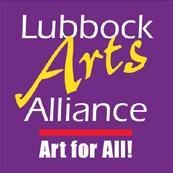
The Lubbock Arts Festival is the largest fine arts and crafts show in West Texas, and the marquee event of the Lubbock Arts Alliance. Given its “Out of This World” theme, special visual art exhibit, spectacular décor, exceptional programming, and variety of artists and performers, the 43rd Annual Lubbock Arts Festival in Lubbock, Texas creates an experience that educates, inspires, and delights all who attend – making it an event unlike any other in the galaxy! For more information, Click Here
Silver - Grand Pinnacle - Budget: $100,000 to $750,000
Macon, Georgia’s International Cherry Blossom Festival – 2022 - Macon, GA, United States
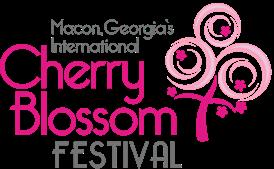
Macon, Georgia’s International Cherry Blossom Festival celebrated its 40th Festival as it showcased the best of Macon and Middle Georgia. For 10 days, guests from all around Georgia, the country and world celebrated the beauty of the Yoshino cherry trees in Macon, Georgia, a town referred to by Congressional Records as the Cherry Blossom Capital of the World. The community and visitors celebrated the 40th Festival by walking and driving the Cherry Blossom Trail, participating in cornerstone and community favorite events, and joining in the fun of new programming put on by the Festival and its umbrella, sanctioned events. With 80 percent of International Cherry Blossom Festival’s in-house, produced events free or at a nominal admission fee, all residents and visitors were able to put on their pink, join in the festivities, and celebrate “Love, Beauty, and International Friendship,” the Festival’s founding principles.
For more information, Click Here
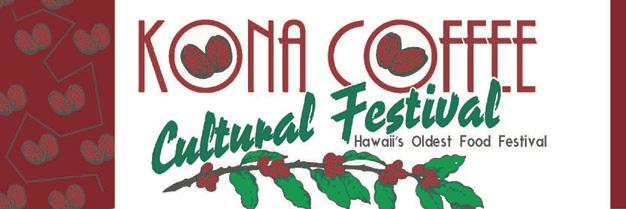
The Kona Coffee Cultural Festival is celebrated each November for 10 days with events that honors the unique cultural treasures behind nearly 200 years of Kona coffee history. The unique cultural heritage, built on the multi-generational tenant farmers, mainly of Japanese descent, established coffee plantations in the Kona District along with the native Hawaiian host culture who had earlier ties to growing coffee here in Kona. Kona coffee’s world-renown reputation along with the unique cultural heritage of the past tells the story of coffee traditions that produced this American legacy. For more information, Click Here.

City of McAllen - McAllen Parks & Recreation - McAllen Holiday Parade – 2021 - McAllen, TX, United
Over 265,000 people visited the official South Pole of Texas this December 4, 2021 for a new spin on the largest holiday and helium balloon parade in Texas, the McAllen Holiday Parade. The 2021 production featured host Mario Lopez, new celebrity appearances, 29 giant character balloons, 47+ illuminated floats, 11 marching bands and the “original” home of the Vuelta Zone. The Vuelta is a Texas Tradition that began at the McAllen Holiday parade. The phenomenon known as “Vuelta,” or “turn” in Spanish has become a McAllen tradition. This year, thousands of visitors celebrated in the new designated South Padre Island Vuelta Zone and chanted “Vuelta!” to cheer on hundreds of balloon handlers as they spun giant helium balloons. This tradition takes place in the zone and along the 1.5-mile parade route. The parade also celebrated the 2021 theme, “Rockin’ Around the South Pole” with a series of new giant illuminated floats handcrafted by the McAllen Float Studio. Thousands of hours go into creating these one-of-a-kind floats each year which were proudly on display in this year’s parade. In its eighth year, the event has been awarded the Best Parade in the World 4x and Best Parade in Texas 5x by the International and Texas Festival and Events Associations. For more information, Click Here
Silver - Grand Pinnacle - Budget: $750,000 to $2 Million

Des Moines Arts Festival® - 2021 - Des Moines, IA, United States
The Des Moines Arts Festival is Iowa’s largest and most prestigious arts and cultural event drawing over 200,000 people annually to downtown Des Moines the last weekend of June. The Festival featured 154 professional visual artists, their original artwork in a variety of mediums reflects the very best, having been juried from 1,000 applicants. Sponsors and Non-Profit organizations offered a variety of interactive arts activities designed to engage and enhance the experience for our guests. Live music, performing arts and strolling street theatre provided non-stop entertainment. Culinary offerings were provided by local and regional restaurants, breweries and mobile food vendors. For more information, Click Here.
Proud to insure excellence in the festivals & events industry
The IFEA/Haas & Wilkerson Pinnacle Awards are sponsored by Haas & Wilkerson Insurance. Haas & Wilkerson Insur ance has proudly supported the IFEA and festivals and events industry for more than nearly three decades. As the present ing sponsor of the Annual IFEA Convention, Expo & Retreat, and the title sponsor of the IFEA/Haas & Wilkerson Pinnacle Awards Program, they have helped to raise the quality and standards of excellence for festivals and events around the globe. With over 80 years of entertainment industry experi ence behind them, they provide insurance programs designed for each event’s specific needs and have a long list of clients that includes festivals, fairs, parades, carnivals and more. Learn more about them at www.hwins.com.

Scottsdale Arts - Canal Convergence – 2019 - Scottsdale, AZ, United States
Scottsdale Arts invites locals and visitors alike to come together at the Scottsdale Waterfront and experience 10 consecutive days of wonder at the annual, light-based public art event, Canal Conver gence | Water + Art + Light. This free event celebrates the vibrant arts and culture community in Scotts dale, drives economic impact for the city, and brings people from all over the world together in a sense of awe and inspiration through the beauty of light-based public art. In addition to the interactive artworks, the event features a variety of educational and family-oriented activities, guided bike rides, art-making workshops, and artist talks. Canal Convergence also offers a broad selection of live music, spoken word and dance performances, and a beer, wine, and food garden every night of the event. For more information, Click Here
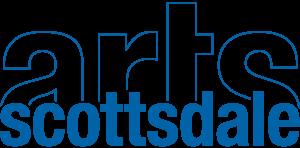
In 2021 the PHS Philadelphia Flower Show, a globally recognized indoor event, made a bold decision to change the format of the Show and move outdoors for the first time in its 193-year history in response to COVID-19 uncertainties and concerns. One of few major events to be produced in 2021, the location change allowed the Pennsylvania Horticul tural Society (the producers) a chance to re-imagine this beloved event in every way. Guests were invited to see the Flower Show in a whole new light and experience the beautiful vistas and rolling landscape of FDR Park, a historic landmark located in South Philadelphia, as the new outdoor home for the event. With more exhibits and activities than ever before, the 2021 PHS Philadelphia Flower Show proved to be a safe and enjoyable experience for guests of all ages. For more information, Click Here.
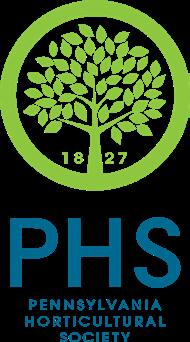
Destination NSW - Vivid Sydney – 2022 - The Rocks, NSW, Australia
Vivid Sydney is Australia’s largest event and the Southern Hemisphere’s largest festival of Light, Music and Ideas. The festival is owned, managed and produced by Destination NSW, the New South Wales Government’s tourism and major events agency. Vivid Sydney trans forms the Harbour City into an illuminating kaleidoscope of colour for 23 days and nights. Acknowledged by Forbes as “Australia’s most exciting festival”, this annual three week-long celebration of creativity, innovation, thought leadership and technology has become “an unmissable event for both locals and tourists alike”. This year, Destination NSW was utterly moved by the numbers of people who simply told us that Vivid Sydney 2022 helped them fall in love with our city all over again.
In 2022, for its 12th year, Vivid Sydney celebrated the ‘soul of our city’ by fusing art and ingenuity in collaboration with some of the most boundary-pushing artists, thinkers and musicians of our time. More than 200 events revealed the essence of Sydney’s soul – its diversity, beauty, resilience, First Nations culture, and vibrant creative community. For more information, Click Here.
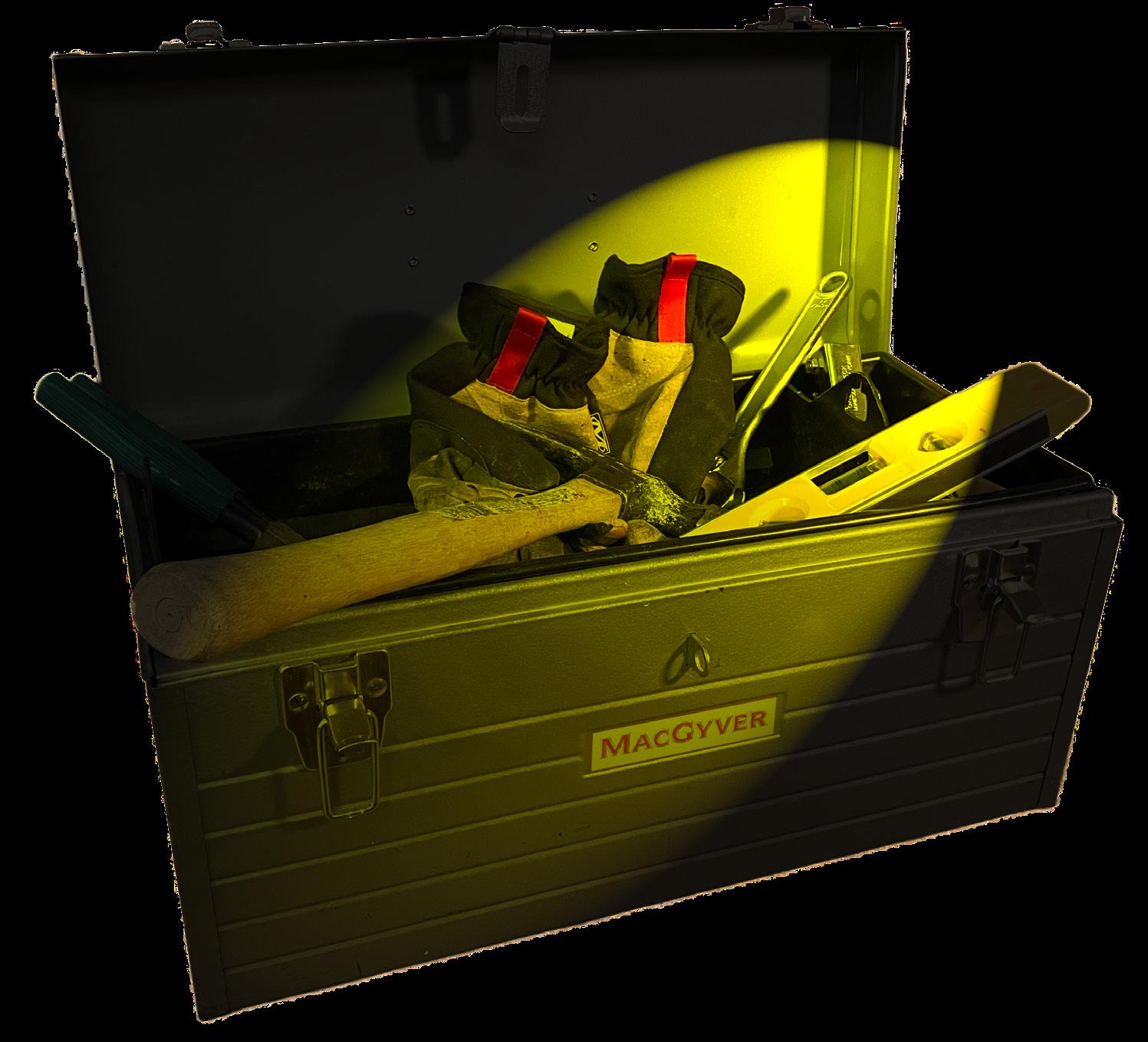
 By Holly Leiferman
By Holly Leiferman
When it comes to festivals and events, let’s face it, not everything goes according to plan. It does not matter if you are the most meticulous and organized event planner in town, there will always be things beyond your control. With endless last-minute changes, the best thing you can do, is be organized. You never know when you might need a zip tie and a flashlight to become a golfcart headlight or spray adhesive for a quick signage fix. For the sake of this article, I am going to refer to us (special event’s planners) as MacGyver! The mark of a good MacGyver is not only to be prepared for any situation but using common everyday items in unique versatile ways! We must be equipped to step in and save the day with MacGyver-like cleverness.
Every successful MacGyver style planner carries an event kit with items to handle just about any emergency. Even if you are planning your own event – large or small – it helps to have these things arranged, instead of wasting time looking for them when needed. An event kit is especially important if you are hosting at a venue away from your home or office. From handheld mics and backup flash
drives, power boxes to granola bars and comfortable shoes these common items can save the day (or at least a little bit of what’s left of your sanity by that point).
Also referred to as an Event Kit, Production Kit, Show Box, Event Toolbox, or Event Tool Kit. The event tool kit that is put together with the MacGyver style mindset is an absolute necessity when preparing for your event regardless of type or size. This trusty toolbox is filled with versatile tools of the trade and these supplies are proven to relieve stress.
It is best to take time to customize your tools for each individual event based on similar events and experiences you’ve had. For example, for an event that has significant lighting and production, I would bring extra portable lights, extension cords and power strips. Things that even the best teams forget to bring enough of or can be faulty. Some items are tried and true lifesavers and should be taken to each event. If there is an emergency like a medical injury that requires a first aid kit, or perhaps a missing golf cart key (we do
have extras believe it or not) and a rubber band to become a key ring holder, we need to be ready for whatever!
After determining what you need to bring, find an appropriate, easy-to-carry container. It can be as simple as a sturdy tote bag or covered plastic box. MacGyver style planners often use a canvas tool bag or professional makeup box, as well as an expandable folding cart or collapsible dolly. Whatever you choose, it will be on the move with you regularly, not only from venue to venue, but also up and down hills, possibly on dirt or sand and it will need to be lifted in and out of your car. If it’s not easy to carry, you’ll be less likely to have it by your side all day long and it won’t be available to you to help save the day! The more you add, the heavier the container.
Our special events team has several durable rolling toolkits that come with us to every event, and it truly has saved us on more than one occasion. Most of the items are organized in a plastic carrying case to make them not only easy to find but easy to load without worrying about things being lost or crushed. If you carry a clipboard, look for one with an attached
supply box to help keep your important forms and papers in order.
Labeling all your tools with a marker or adhesive labels saves time and money in the long run. It gets expensive to replenish even small items when they keep walking off. Restock your tool kit supplies as needed. The day you ignore that empty roll of tape will, of course, will be the day you have a rogue sign trying to fly across your event and you will need it.
The following, is a partial basic list because all MacGyver style planners know that every event has specific needs but there are some go-to items that are always useful! Use this list as a guide to draft your own event toolbox checklist. Review the items listed here and amend the list to suit your specific event or festival. It’s as easy as that.
Important Basics: Scissors; assorted rolls of tape (transparent, masking, no-res idue duct, gaffer) for easy fixes; cardstock paper, pen and/or permanent markers for quick signs; stapler; paper clips, binder clips and Post-Its; wire, twine or zip ties for quick attachments; safety pins; basic tools like a multi-head screwdriver, wrench and small hammer; assorted Command hooks; small flashlight; batteries; phone chargers; extension cord and surge strip; box cutter or pocket knife; glue gun; and measuring tape.
Personal Essentials can include moleskin bandages for blistered feet; pain relievers for headaches and sore muscles; antihistamine for allergic reactions; antacids for upset stomachs; hand sanitizer; stain stick; baby wipes, change of clothes and an extra pair of shoes. Bring bottled water, energy bars, nuts or other easy-to-eat snacks, and some hard candy in case of low blood sugar. For outdoor events, add sunscreen, bug spray and a sun visor. Dryer sheets also repel bees and wasps from an area. And don’t forget the rain gear.
Event Incident Response: First Aid Kit, Hazard/safety tape, torch, mini flashlights, Megaphone/loudspeaker, and whistle, High Viz vests and warden hats, No Entry/Danger/Slippery Floor signage, Safety cones or bollards, PPE (personal protective equipment) such as gloves and masks.
Another useful tidbit is, your event kit does not need full-size bottles or boxes of products; travel sizes are convenient or use sandwich bags to hold small amounts. Pre-cut strips of Velcro (this should be
a staple item on the list) in a Ziploc bag (another key item on my list) can help save the day. Even Goo be Gone can be found in a travel size and be enough to get you out of a sticky situation.
What’s in THE OG MacGyver Toolkit? Most event planner tool kits include the vital office supplies, personal items and first aids kits. But over the years my personal tool kit has evolved to include unique but helpful items. For example: I have used my pocketknife to start a golf cart, since all the keys were lost (we now have extra golf carts keys on hand). Spray adhesive to attach a chloroplast sign to a barricade, as all the zip ties and Velcro had been used at the event the week before. Goo be Gone to remove the signs from the barricade, wasp spray to remove numerous nests around a park pavilion or picnic table, a measuring wheel, and a rain poncho just to name a few. On the signa ture events I bring all the event paperwork, the management plan, event permit, staff, and volunteer manuals, contact lists, run sheet or production schedule, site plans, supplier booking orders, etc. And don’t forget business cards – there are always opportunities for networking!
Let’s Chat About a Weather Toolkit! Although we can’t control the weather, we should be prepared for all kinds of weather elements during our events. Personally, I bring at least a change of clothes, two pairs of shoes (or three) and couple of pairs of socks. I have been known to have an extra pair of jeans, shorts, three shirts, a ball cap, sweat resistant headband, mud boots, rain jacket, hoody, winter coat and gloves all at the same event. In April 2017, during our Bloomin’ Temple Festival it poured down with rain during the day for two hours then dropped about 20 degrees in the evening! “If you don’t like our weather in Texas, just wait a minute.”
Now, one crucial MacGyver item to consider is ordering a tactical chest fanny pack…yes, you read that right. In all my years of life, I would have never had to enter that into a search engine prior to becoming an event planner. All of us have probably experienced (more than we’d like to admit) un-hooking your walkie talkie, earpiece, and fanny pack in a 100-degree port-a-pot, praying we don’t drop anything into the abyss. Used by soldiers, police officers and now special event professionals on very important missions. This item wraps around both shoulders and along your back to evenly distribute the weight and not fall forward, leaving
nothing to unhook and your hands free! It has hooks for radios, keys and several pockets that fit a minimum of 2 phones and some MacGyver lifesaving goodies too! If you are fortunate to not be wired up to 3 types of communications systems, a regular fanny pack will do, however it can annoyingly bring down your shorts or pants throughout the day and that’s just an added stress we don’t need, am I right!?
Having a properly stocked toolkit and well trained and qualified MacGyver-like team on the job is critical to plan the event, coordinate the moving parts, and make sure everything on track.
Take it from me, it never hurts to be over-prepared. In our business, we go to an event assuming everyone there has forgotten everything, because most of the time…welp, they have. Making sure we have a mental or even physical list of all the possible event needs by using items that are inexpensive and versatile can be a life saver.
Remember, there isn’t one right way to compile an event emergency kit. It’s a little different for each person and for each kind of event. Every MacGyver style planner’s event tool kit will be different. It’s all about knowing the requirements of your specific event and thinking about what YOU might need to use at the event. The most import ant thing is to be creative, thinking outside the box on how one item can be used in multiple ways to solve the everyday problems or issues we encounter.
The mark of a good MacGyver style planner is one that is ready for any situation!
Holly Leiferman is an Oregon native but a true Texan at heart with a passion for events. She currently serves as the Senior Special Events Coordinator for the City of Temple, TX where she manages three of the city’s largest and most treasured events, to include the Bloomin’ Temple Festival, 4th of July Family Fun Fest & Fireworks Show, and the Annual Christmas Parade. She supervises a team of two staff that coordinate an additional ten plus events and a Food Truck Plaza as well as manages the outdoor event application process for the city as a whole. Holly is enthu siastic, outgoing and has a love for music, results-oriented Marketing, Promotions, and is an Event Manage ment Professional with over 25 years of industry experience. Holly can be reached at hleiferman@templetx.gov


Congratulations
Dr. Brianna Clark High Point University
Daphne Dickens Des Moines Arts Festival
Tammy Dooley Visit Granbury
Jasmine Freeman City of Las Vegas
Elizabeth
Jeremy Gross Town of Vail
Kevin Grothe Memphis in May Kassie Higert ArtsQuest
Eric Hjellming Drum Corp International
Nan Krushinski City of Delray Beach

Holly Leiferman City of Temple Parks & Recreation

Eduardo Lopez III City of McAllen
Julie Machon City of Montgomery, Ohio
Julie Myers
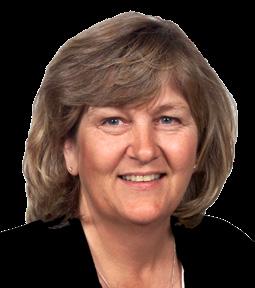
Greater Vallejo Recreation District
Brooke Spain Town of Parker

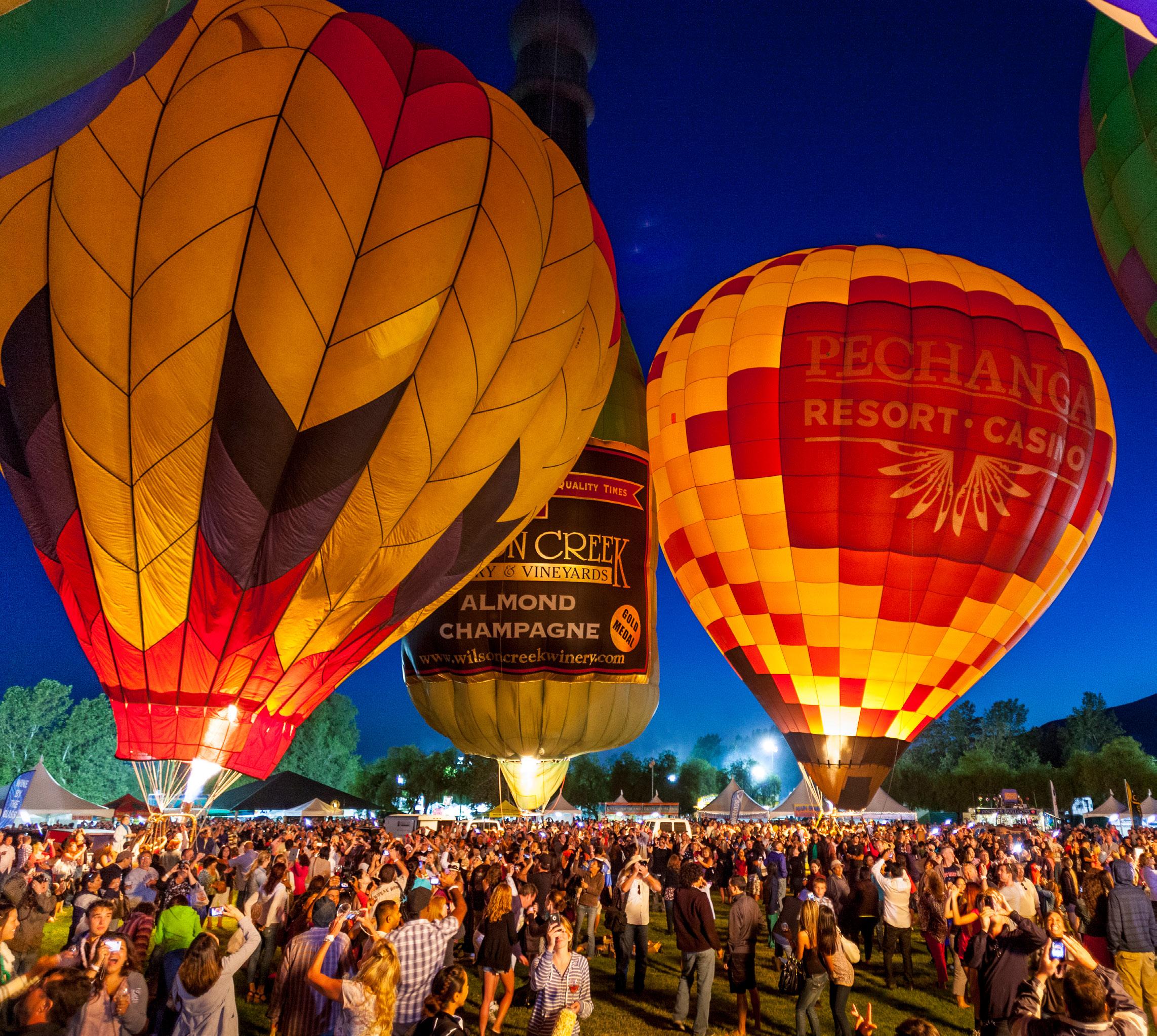
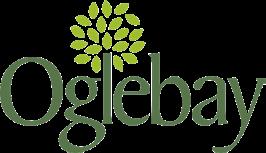
 Presented by a Partnership For Excellence in Event Education.
Presented by a Partnership For Excellence in Event Education.

Quality festivals and events are among the most successful tools available to communities, states, regions, and even countries to increase tourism, create powerful and memo rable branding and imaging opportunities, bond people together, encourage positive media coverage, enhance economic impact, and add to the quality of lives for those who live there. On the other hand, a poorly planned, managed and executed event can have a reciprocally opposite effect.
Over time, events themselves have changed; from often informal affairs to spectacular productions, requiring new sets of skills, experience, creativity, financing, planning and leadership. As a result, event management has evolved into a business and an industry, with new demands, challenges and expectations every day; from attendees / participants; sponsors; host communities and a plethora of other partners that the success of any event depends on.
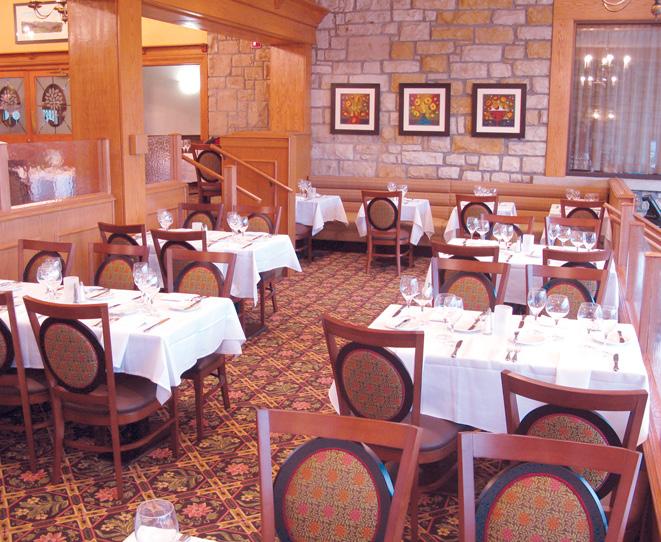
Presented by two of the most respected professional associations in our industry – the International Festivals & Events Association (IFEA) and the National Recreation and Park Association (NRPA) – the Event Management School at Oglebay National Training Center in West Virginia was designed around the concept of bringing new and mid-career industry professionals together with some of the most highly-respected and experienced professionals in the field, for a comprehensive educational and networking opportunity that will cover the critical basics of successful event management and then put students in an applied-knowledge project environment to test and further what they have learned.
 Bruce
Erley, CFEE, APR President & CEO Creative Strategies Group
Bruce
Erley, CFEE, APR President & CEO Creative Strategies Group
“No other investment is more important for the board of a festival or special event than to assure that their staff is growing in their professional development. The Event Management School at Oglebay provides our industry with one place for new and mid-management level professionals to receive intensive, comprehensive training in the core competencies of event management, con ducted by many top professionals in the field. It is the equivalent of a full-brain download for those who want to have a well-rounded, working understanding of our profession.”
L.
The Event Management School is designed as a two-year continuing education program. Students live on-site at the Oglebay Resort and National Training Center with their professional peers and instructors during the one-week institute each year, adding a unique one-on-one networking opportunity for ev eryone. Year One Students at the Event Man agement School follow an intensive, interac tive, classroom pathway through 24 hours of topical training, from a clear definition of event management as a profession through to the final and important evaluation phase of an event. Year Two Students take it up a notch in applied workshop settings and a unique hands-on, deadline-driven, event concept design, team project experience that com bines many critical event management skills, that can be transferred to multiple, real-life scenarios. Event-expert team advisors help to guide event teams through a week of market research, concept creation/design, budgeting reality checks, human resource challenges, and presentation stages of an all-new event concept, for a specially selected city, with a
limited-use “Client” contact. Teams will pres ent their completed plans/concepts to a panel of industry leaders and fellow-students on the last day, who will offer critiques, insights and accolades. Plans/Concepts approved by the expert panel will be shared with the selected city for consideration in their market.
The Event Management School will bestow an Event Management School Diploma to those successfully completing both years of this intensive continuing education program. For those needing CEU credits, the NRPA will provide 2.0 CEU’s for each completed year. Additionally, for those desiring to ‘raise the bar’ by registering for the IFEA’s professional certification program (separate registration required), successful completion of the twoyear Event Management School will earn you designation as a ‘Certified Festival & Event Associate’ (CFEA), the first phase toward future attainment of your ‘Certified Festival & Event Executive’ (CFEE) designation, which recognizes an industry-focused combination of
top-level experience and continued education. Additionally, all students enrolled in the program will receive one full year’s access to the IFEA’s professional education on-line Webinar series (a $1000 value). (Live Webinar presentations only.)
• Current mid-management event staff look ing to broaden their knowledge base while enhancing their professional networks.
• Parks and Recreation managers and staff who produce and/or work with local events.
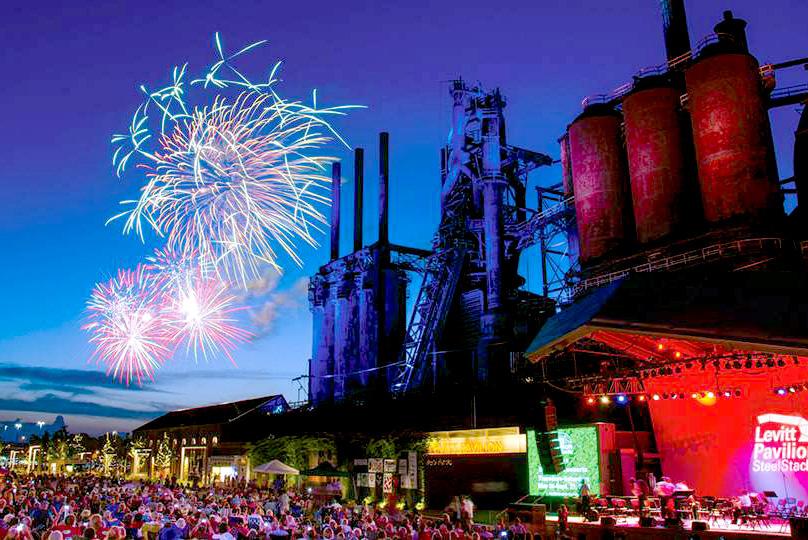
• Those new to the Event Management field.
• Event Management students looking to strengthen their professional resumes.
• Key event volunteers looking to expand their capabilities.
Event Management School instructors are selected by the International Festivals & Events Association (IFEA) from among the top event management professionals in our industry today.
“If you were applying to my organization for a job - and I knew that you had completed the IFEA / NRPA Event Management School program – your resume would rise to the top of the pile.”
Curt Mosel, CFEE, Chief Operating Officer ArtsQuest
The Event Management School first-year curriculum was created with the goal of providing a strong basic understanding and awareness of the multiple, critical components involved in event planning and management. The second-year curriculum builds upon that first-year knowledge-base by providing more applied workshop-styled opportunities in specific areas, together with a project-based opportunity to help bring the ‘real world’ a little closer to the classroom.
NOTE: The Event Management School curriculum is not targeted at the corporate meeting-planning niche of our industry, but rather the outdoor public event sector.

“The Event Management School at Oglebay has created a vital tool in developing festival and event industry professionals. As any event producer can attest, training new staff often amounts to a “sink or swim” option. To have a venue where person nel can learn, interact and network with industry leaders, instructors, and peers from other events and markets increases professionalism and output multiple-fold.”
Ted Baroody, CFEE, President, Norfolk FesteventsThe Covid-19 Pandemic took a large toll on the global festivals and events industry, throwing ‘Best Practices’ out the window and causing us all to reimagine the future in the midst of unimaginable challenges. And while recovery of the industry – collectively and individually – is still ongoing and will likely take a number of years, we all answered the call, together, by learning how to re-present our events in new formats; how to re-open safely as able; how to re-connect with our communities and stakehold ers; how to re-imagine the future of events in an extended or post-pandemic world; and how to re-structure our events to maintain our financial sustainability moving forward. These lessons and new ones, yet to come, as all of our vendors, sponsors, volunteers, host communities, staffs and attendees recover from and respond to their own specific challenges, will be addressed by our Event Management School instructors, as it pertains to each of their focus areas. Looking forward, our events have become more important than ever to bonding our commu nities and world together.
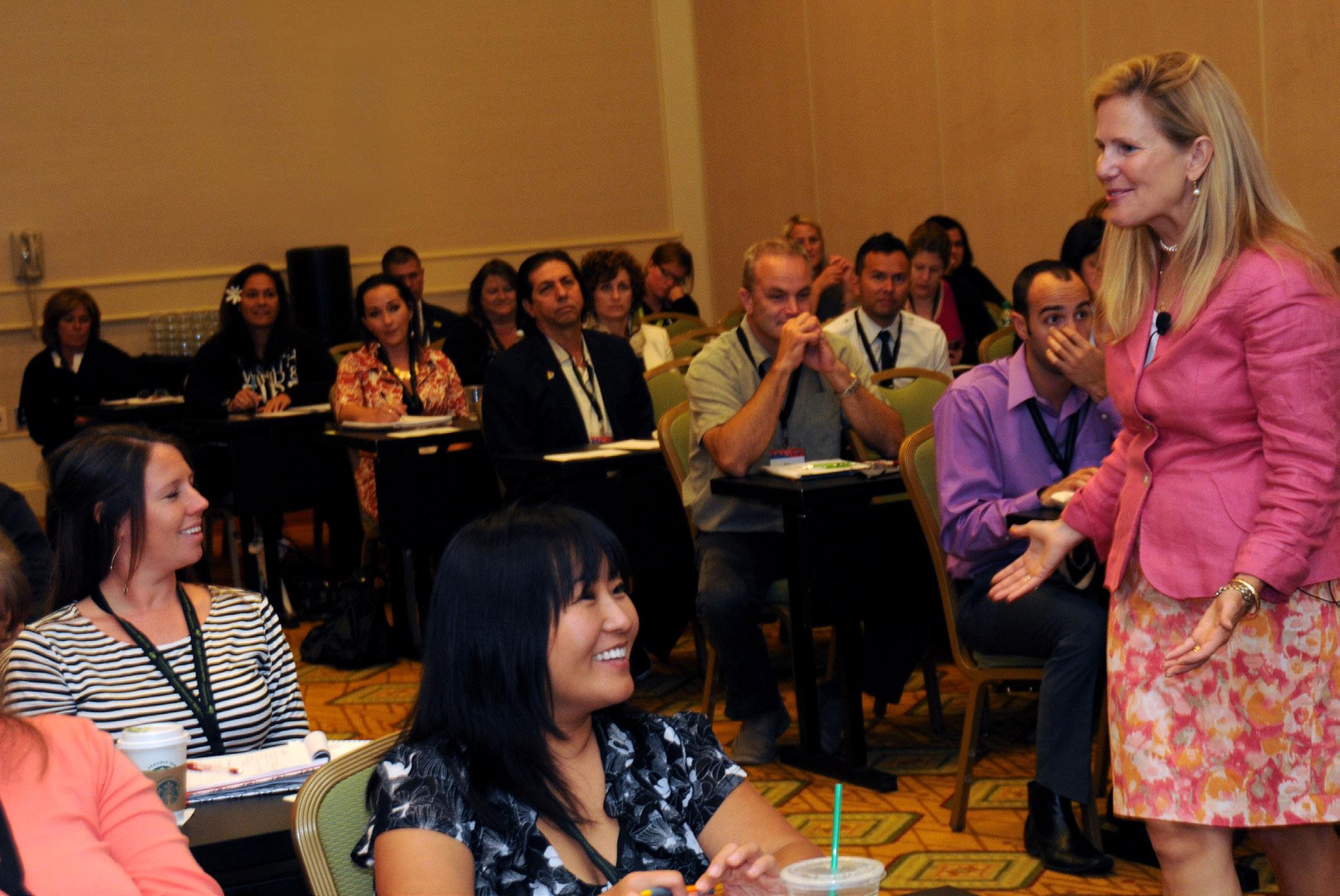
The success and sustainability of any event boils down to the commitment and passion of the leadership and team that make it all hap pen. We’ll take a moment to get us all off on the same foot, to clarify the multiple niches/spe cialties that make up our broader industry; the professional and personal returns that you can expect from working in event management; and the passionate leadership, dedication to quality and creativity, and professional skills that will help to ensure your success. This session will lay the foundation for the realities of our field and the training to follow in the week ahead.
A successful event doesn’t start with the fire works finale. Behind every exciting, fun-filled event is a well-run business, complete with paperwork, planning meetings, legal obliga tions to be met, and partnerships to be built. Reputations are often based far-more upon the business side of your event than on who your headline entertainers are. We’ll teach you what you need to be thinking about.
Every time there’s a good idea, someone brings up the budget! A realistic and informed
budget can set the stage for a less stressful and more profitable event. We’ll teach you how to create and use a budget to guide your success.
Putting the ‘Community’ in ‘Community Events’: Building a Successful Volunteer Program
Volunteers put the ‘community’ in ‘com munity events’ and some events have legions of dedicated workers who bring valued skills to the table while holding costs to a mini mum. This session will cover critical com ponents of a successful volunteer program, including recruiting, training, management, communications, retention and rewards.
Really? I have to think about that? Despite being a ‘fun’ industry, there are lots of be hind-the-scenes ‘t’s’ to be crossed and ‘i’s’ to be dotted; obligations to be met; risks to be avoided/protected against; staffs and boards to be managed and supported; services to be secured and contracts to be signed. We’ll do our best to help you understand them.
The expansive area of ‘Operations’ is where the rubber meets the road and this session will cover multiple areas that can make or break an event.
• Event Infrastructure: The infrastructure for many events is a lot like building a small village where the day before there was nothing. Stage, lights, sound, tents, vehi cles, decorations, bleachers, food delivery, trash pick-up, communications, utilities, parking, et al., we’ll talk about what you may need, where to go get it, and lots of insider-tips to remember in the process.
• Attendee & Support Services: Whenever you plan to draw a crowd, you’ve got to be thinking about what their needs may be: information, medical, lost kids, rest areas, ATM’s, restrooms, trash disposal, signage, communications, safety and security plans; accessibility; and much more. We’ll make sure you don’t forget anything.
• Programming, Site-Design and Event Flow: When did having fun require so much thinking? Like a theme park, effectively planning your event programming, site lay out, service accessibility, etc., can ultimate ly affect sales; safety; friendly-neighbor relationships; and the overall experience for your attendees. We’ll cover some im portant, if not critical, considerations that will keep your event flowing smoothly.
• Environmental Realities: Events can play an important role through education and as a role model in protecting the environment. We’ll touch on some of the ‘Green Reality’ options that events can consider today.
NOTE: All sessions are subject to change.
sion will cover the components and consider ations of a successful merchandise program.
There are very few events today that can operate without sponsorship support, but successful sponsorship doesn’t just happen. This session will cover the basics of spon sorship and successful sponsorship sales, including why sponsors sponsor and how to identify and create a valuable menu of sponsorship benefits/assets for your event. Students will also learn about the valuable world of mobile-marketing. And we’ll cover the critical role of sponsor service; the key to renewing and keeping those all-important sponsor partners we all depend on.
All the planning in the world won’t make for a successful event unless it is properly marketed. This session will talk about how to develop an effective marketing plan and considerations for working with traditional media (television, newspaper and radio…yes, they are still around and still important) as well as today’s newest technology options.
A well-run food and beverage program can add to both the event experience for attendees and the bottom-line for the event. This session will cover the components and considerations of a successful on-site food and beverage program.
NOTE: All sessions are subject to change.
whereby the event planning team methodi cally addresses the risks associated with their activities, with the goal of treating or mitigating those risks which may have an adverse impact (financial, image, reputation, etc.) on the event if the risk is materialized. We’ll make sure you are focusing om the critical considerations.
It’s a new and quickly changing world, with Facebook, Twitter, LinkedIn, Instagram, blogs and many, many more. How do you decide which ones are important and use them as an effective part of your event mar keting mix? This session will provide a more in-depth look at maximizing new technolo gies and opportunities.
The New World of Event Ticketing, Financial Transactions and Audience Expectations
Technology has impacted every part of our world, including events, in ways we could never have imagined just a few short years ago. This session will talk about options, changes and new considerations in the criti cal areas of event ticketing, financial transac tions, and the constantly changing expecta tions of those attending our events.
The Common World of Events and Cities: Building Community through Proactive Events Management

For events to meet their full potential, to all interested parties, we must learn to
In the United States, events that are open to the public are required to comply with the Americans with Disabilities Act, known as the world’s most stringent disability rights law, but the lessons are important ones to consider at events around the world. This fast-paced session provides practical information and a format for designing a comprehensive Access Program for your festival/event. What are important but often forgotten aspects of a well-managed Access Program? Are you required to accommo date every request? What are some low-cost solutions? Help to avoid litigation by being prepared.
No event is complete until the last survey and evaluation is in. This is the first step in all future events and this session will teach you how to do it effectively and cost-effectively.
Year-One Event Management School students will participate in the City Event Concept Project reports by second year stu dent teams, asking questions, and serving in the shared role of Panel Judge #4.
Events are the end result of countless details, processes, and tasks, all coming successfully together; but how do you manage all of those priorities and make sure nothing falls between the cracks? Project Management is an accountable management method using tools and techniques honed over 50 years of use around the world by gov ernments, corporations, and selected events. This session will set the stage for coordinating everything else that follows and provide an important tool for all those attending.
Design Thinking is a process to assist you and your organization in developing a com mon language for innovation and creative problem-solving skills. Design Thinking keeps your event planning focused on the people for which you are designing the ex perience. By participating in this interactive session, students will leave with a newfound creative confidence to change how they think about designing human-centered, memorable event experiences. Participants will work together through a challenge in which they apply their Design Thinking skills to an actual problem and come to a common creative resolution.
The tragedy of realities like the July 4th parade shootings in Highland Park, Illinois; the Las Vegas music festival shootings; and the Boston Marathon bombings, together with concerns like stage collapse or vehicular incidents, airshow crashes, crowd panic or control situations, sexual assault, gang-related violence and drug-related deaths at events and in cities of all sizes, serve as stark remind ers of the need to plan and prepare for all the many incidents / possibilities that can / may affect our events on a moment’s notice. This important session will address what keeps us up at night and the steps that we can realisti cally take to address those concerns through contingency planning and preparation, as well as on-site during an event.
The relationship between cities and events has been evolving (sometimes devolving) for many years. Whether you are creating a new
event or continuing to build upon a long-ex isting one, you must first start from a level of understanding about what cities want from events. Combining your goals with theirs, you can build a lasting and powerful partner ship that will provide exponential benefits for everyone. This session will define some of those key goals and how to achieve them.
Following on our introduction course in Year One, this important session will delve a step deeper into the design and manage ment of a comprehensive Access Program for your festival/event, assuring that everyone is invited and welcome. From service animals to signing to infrastructure, we’ll help make sure that you are prepared.
Before you start selling your event, you have to first do your homework. This session will instruct students on how to conduct sponsor research, where to look, what to look for and how to use what you find.
Working from a draft event program plan, other desired ‘bells and whistles,’ and the many unexpecteds and unknowns that im pact the event ‘experience’, students will learn how to develop an event budget, discussing what to include, how/where to research, fair and realistic estimates, the keeping of formula and assumption notes/records, use of a budget in managing an event throughout the planning and production process, budget reports, tracking expectations and more.
“It’s all in the presentation…” or so goes the old (and true) adage. Students in this session will learn about and practice writing sponsorship proposals and follow-up reports; two points-of-critical-impact with sponsors.
The City Event Concept Project will provide a substantial hands-on experience with an event focus. Event expert team advisors will help to guide event teams through a week of market research, concept creation/design, budget reality checks, and presentation stages of an all-new event concept(s) for an actual city (including limited-use “Client” contact). Teams will present their completed plans/concepts to a panel of industry leaders and fellow-students on the last day, who will offer critiques, insights
and accolades. Final plans/concepts deemed the most feasible will be offered to the selected city for consideration in their own internal creative process and the winning team will be recognized for pride and posterity on the Event Management School ‘Oglebay Cup’ trophy.
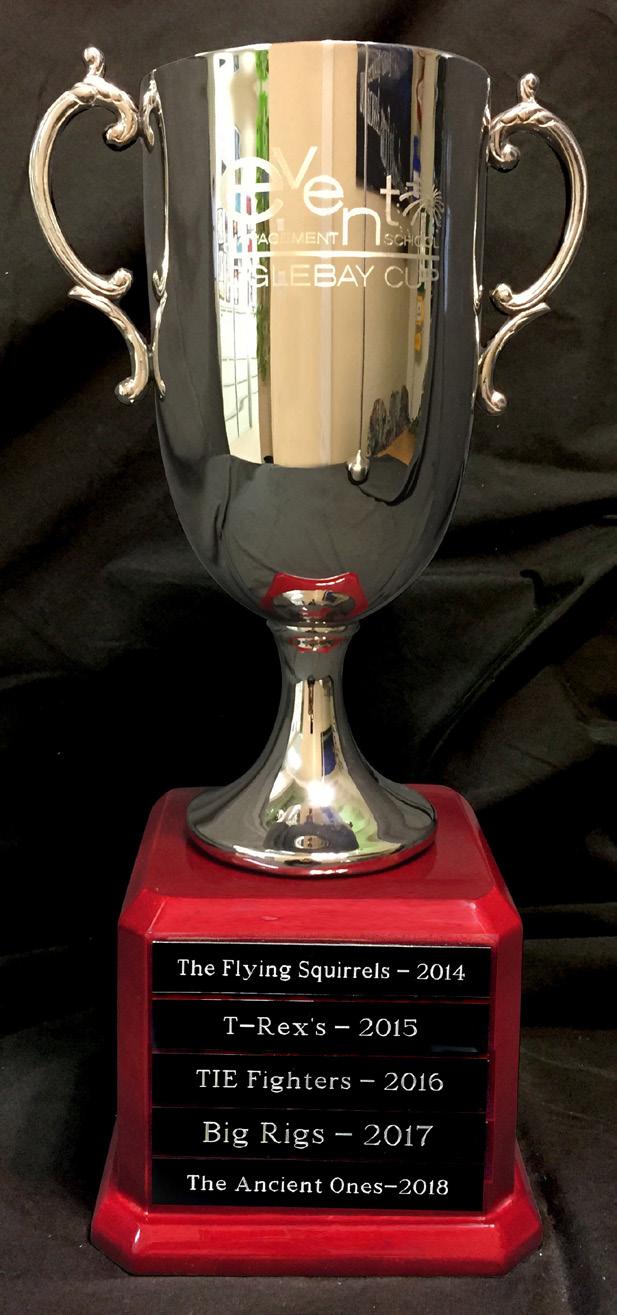
During the week, each team (assigned randomly to reinforce the reality of an event environment) will participate in the following project steps:
• Research and Development of Creative and Innovative Event Concepts to Serve Market Audiences, Event Calendar, Orga nizational Mission, Available Venues, and Unique Capabilities
• Research & Development of an Event Programming / Management / Opera tional Plan and Expense Budget to Meet Defined Goals
• Research and Development of an Event Income Budget with Suggested and Real istic Sources, plus Sales Strategies, to Meet Defined Goals
• Professionally Delivered City Event Concept Presentations (all team members must play a role in the final presentation) in the format of an outside consulting firm presenting concepts to a client
Teams will be assessed on Team Work, Event Proposal / Plan and Presentation.
NOTE: All sessions are subject to change.www.NRPA.org 800.626.NRPA (6772) 7-1-1 for speech and hearing impaired

EMAIL, MAIL OR FAX THIS FORM TO: The National Training Center for Public Facility Managers at Oglebay Resort & Conference Center
465 Lodge Drive, Wheeling, West Virginia 26003

Phone: (304) 243-4126 • Fax: (304) 243-4106 E-mail: ntc@oglebay-resort.com
•
•
•
•
•
•
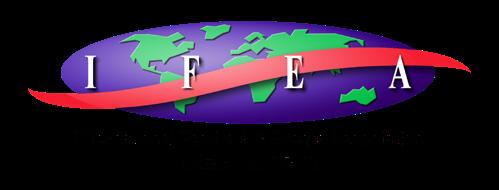
•
www.IFEA.com +1. 208.433.0950
OGLEBAY.com/NTC 800.624.6988, ext. 4126
Now that the world has more or less righted itself and, given the stresses and strains of recent years, perhaps it is time to reflect on our organizations and see what improvements, if any, need to be made to how we run things.
Every organization needs a system of rules, practices and processes, called Corporate Governance, to determine its direction and control. After all, every organization has a number of constituent stakeholders whether internally or outside of it which require attention and satisfaction or the organization may be subject to unwanted change or even eventual dissolution.
But all successful organizations realize that it is imperative to have solid corporate governance because it is the only way to meet any and all challenges that will arise in an organization. And Corporate Governance is just not directed at such areas as bylaws, board makeup, compensation, and all internal policies, but encompasses environmental awareness, ethical behaviour and fair and transparent inclusionary practices.
The benefits of good corporate governance are indisputable:
1. It creates understandable rules and reasonable controls
2. It helps the leadership of the organization
3. It ensures that everyone is “on the same page”
4. It builds trust internally and in the community
5. It can help to prevent problems
6. It promotes long-term success
So, who is responsible for this? The Board of Directors is always the primary force in providing corporate governance, but they must be guided by the mission of the organization and the basic principles of corporate governance: accountability, transparency, fairness, responsibility, and risk management.
A Board of Directors must make many important decisions including officer appointments, staff compensation, organizational planning and growth, succession planning and more. In order to be most effective, a Board should represent its community in terms of diversity, skills, knowledge and experience. Boards need fresh perspectives not only from outside the organization but also from outside the industry.
How can a Board reflect the basic principles of corporate governance to ensure the smooth running of an organization?
1. The Board must ensure that everyone in the organization treats other employees, volunteers, vendors and communities with respect, fairly and with equal consideration.
2. The Board must ensure that guidelines in all areas are trans parent and provide timely, accurate and clear information in all matters. This principle of transparency should be expected at all levels of the organization, from top to bottom.
3. The Board must determine risks of all kinds for everyone involved in the organization and provide information on these risks, how they might be mitigated and how they will be handled to protect personnel and property.
4. A Board is responsible for the oversight of the organization,
especially corporate matters and management activities. It must know when successes are achieved and provide performance rewards where possible and appropriate. It must always act in the best interests of the organization.
5. A Board is accountable for explaining what the organization does and how it does it. It assesses what the organization can do, what it should be striving to achieve, and how well things are going. It must communicate clearly.

How will we know if the ship is running well? You can take a good hard look at your organization to determine whether or not it’s practicing good corporate governance. These areas include:
1. Disclosure practices. Are there activities or policies that are “understood” but never put in written form?
2. Is the compensation structure fairly determined and reasonably applied?
3. Is staff assessment clear and fair?
4. Are there protections that cover risks in the organization for property and personnel?
5. Are there clear policies on conflict of interest situations? Can the organization reconcile practices that conflict with its stated mission?
6. Are the members of the board of the directors or other administrative leadership a diverse and representative group?
7. Are there clear policies for dealing with contracts for services? Is bidding for providing services a transparent process?
8. What are the organization’s policies on current social issues such as climate change, the indigenous community, and other community stakeholders?
9. What is the relationship with vendors like? Is it cordial, respectful and fair?
10. How are complaints addressed, either from employees, contractors or the community?
11. Does the organization utilize outside expertise, such as an audit firm, to advise?
We know who should be running the ship and our goal should be to ensure that our organization has a good captain and staff along with clear sailing.
Robert Baird is President of BAM! Baird Artists Management Consulting in Toronto, Canada and an acknowledged expert in international touring including visas, withholding and taxation. He offers free advice to artists, agents, managers and venues and has an international clientele. He served for many years on the Executive Board of Festivals and Events Ontario (FEO) and is a former Vice-President of that organization. He can be reached at: P: 1-800-867-3281 E: robert@bairdartists.com or for more information go to: www.bairdartists.com
The IFEA would like to thank the above partners for their dedicated support of the association. Association Endorsed Partners have made a commitment to the continued success of our associa tion, our members, and our industry through their umbrella support of all IFEA programs and services. Show your support for these dedicated providers to our industry by getting to know them, and the high quality products and services that they supply, better.
Interested in becoming an Association Endorsed Partner?
Contact Kaye Campbell, Director of Partnerships & Programs (208) 433-0950 x8150 or kaye@ifea.com

“Recognizing the best in community leadership and festival and event partnerships around the world.”

The International Festivals & Events Association announced and rec ognized the 2022 recipients of the “IFEA World Festival & Event City” award during the 65th Annual IFEA Convention, Expo & Retreat in McAl len, Texas, United States on Septem ber 21, 2022. The IFEA would like to congratulate all of our 2022 IFEA World Festival & Event City Award Recipients.
The City of Philadelphia is making a comeback for the ages. The challenges associated with the COVID-19 pandemic impacted every facet of the event and hospitality industry across the globe. As a city that prides itself on major events, tourism and its hospitality sector, Philadelphia was not spared from the pain endured by so many. Our event industry stepped up to the plate in a way that no one could have imagined, repurposing venues for testing and vaccination sites, implementing common sense protocols
to limit the spread of the COVID-19 virus and ensuring that consideration for public safety and public health was at the forefront.
As public health officials began to roll back restrictions and public gatherings were permitted to return, Philadelphia was ready. The second largest city on the east coast came out swinging, and continues to build momentum in 2022 for what comes next. Planning over the next four years will lead to a monumental celebration in 2026, and the work that has been done to establish Philadelphia as a premier destination for event producers will set the stage for success.
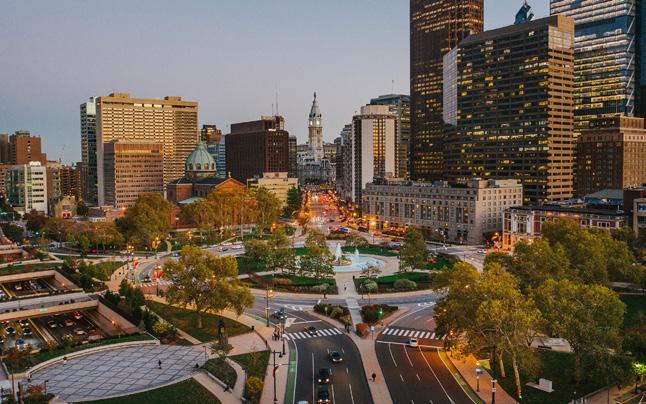
Philadelphia is seeing tourism and hotel occupancy rates that exceed prior year projections, as visitors return to experience the history, culture, dining and overall vibrancy of a world-class city that welcomes all. The comeback is underway, and we can’t wait to see what the future holds.
VIEW VIDEO
The Penghu islands are located at 23° 30’ N and composed of ninety islands and islets. Unique sunshine, blue sky, clear sea, and golden beaches outline the charming and varied scenery of Gaillardia Island. In Penghu, the unique natural environment breeds rich and diverse ecological resources, especially columns of basalt, known as the world-class landscape. In addition to an important place for bird watching, the columns of basalt are acclaimed internationally as the God’s Stone Sculpture Garden. Moreover, Penghu has had more than 700 years of history so far. The historic sites and buildings have been created for the reli
gion and culture formed from the temples as a center in each village. The local custom is reflected from well-preserved historic residences, important traditional settlements, and the cultural landscape of fishing weirs, one of the Potential World Heritage Sites in Taiwan. The festivals and events in Penghu for the whole year start with an exciting turtle-granting contest on the Lantern Festival. After that, there are the most remarkable Penghu International Fireworks Festival in spring and summer, the appealing Penghu Beach Party Carnival in the summertime, and a sporting tour for relaxation in autumn and winter. In the end of a year, an extensive cultural tour of the countryside is undertaken. The government agencies continue to plan and develop a series of splendid festivals and events, and are committed to seeking innovation and transformation. By combining local cultural features and environmental resources, the beautiful and diverse scenery of nature and culture in Penghu is promoted to attract tourists, stimulate industrial development, and create value of the city brand.
VIEW VIDEO
Philadelphia Pennsylvania, United StatesAn economic hub of Northern Thailand, Chiang Mai boasts beautiful culture and abundant natural resources. The city’s offers of international-quality tourism services and priceless arts and cultural experiences have greatly impressed visitors. With long history and the unique Lanna culture, Chiang Mai is packed with traditional festivals that deeply reflect the
residents’ beliefs and ways of life. On the other hand, their creativity has led to the creation of many contemporary festivals and events that invigorate the city and engage visitors in year-round activities with the locals. The city of Chiang Mai is committed to becoming a city of festivals and events, with a keen eye on sustainable development on the grounds of balanced coexistence between humans and nature. Such an ideology lies at the heart of Chiang Mai’s local culture. Stakeholders in the city, including the government, private, public and education sectors, have collaborated in organising festivals and events to welcome and immerse visitors in an experience of this delicate culture while they bask in the exquisite landscape of Chiang Mai among the lush forests and mountains of Northern Thailand.
Jinju is a city in South Gyeongsang Province, South Korea. At just over a third of a million, Jinju is a relatively small city by Korean standards. From old times, Jinju was a fountainhead of national culture and spirit. As a city that has held 1,000-year-old historical heritage of the


ancient city, Jinju has been well renowned as a home of patriotic spirit, education, culture and art. There are cultural events held in Jinju every year. Among these are the Jinju Namgang Lantern Festival which is held in October for approximately ten days. This nationally designated cultural tourism festival, found only in Jinju, features a spectacle of lanterns floating on the Nam River to commemorate the patriotic spirit of the 70,000 militia corps and government troops who died for their country defending Jinju from the Japanese forces during the Imjin War. Other major festivals include: the Nongae Festival, the Korea Drama Festival, the Gaecheon Arts Festival and the Jinju National Bullfighting Contest.
VIEW VIDEO
McAllen is a bicultural community that grew under the Texas sunshine into an event city like no other. McAllen’s roots are woven into every celebration, creating new tradi tions and transforming seasonal events into unforgettable experiences - like the McAllen Holiday Parade. Not only is it the largest illuminated holiday and helium balloon parade in Texas, has been selected as the Best Parade in the World 4x and Best Parade in Texas 5x by the International and Texas Festival & Events Associa tions, respectively.
Designated by the Texas Governor, McAllen is the official South Pole of Texas, Santa’s warm weather winter getaway, and home to holiday events that blend seasonal fun with south Texas personality.
McAllen created original festivals like Fiesta de Palmas and MXLAN where Lati no culture thrives, and a place for special events that celebrate the arts, subcultures, competition, and inclusive outdoor fun. McAllen hosts eight-hundred-and-three events each year that generate over sixtynine million in annual economic impact; with an additional eighteen-point-five million dollars of impact from the McAllen Holiday Parade. Thanks to the work of over twenty-two hundred volunteers and a dedicated special events team.
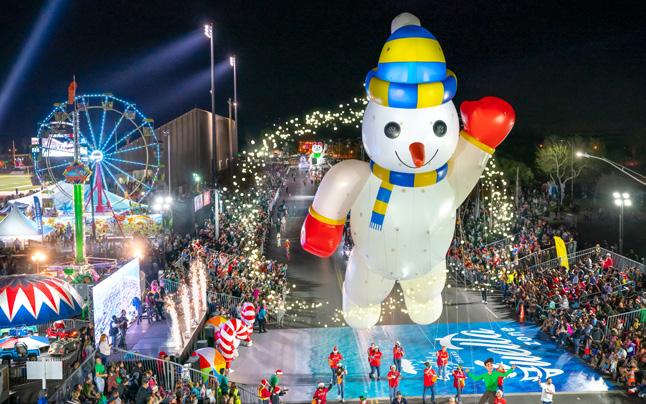
 By Susanne Tedrick
By Susanne Tedrick
No single person, no matter how intelligent or experienced, can understand everything there is to know about a given job. Questions will come up, and when they do, the individual – whether a software developer, project manager, sales engineer – or any other title, needs to have a handle on the specific support that is needed, and how to ask for it.
With more people working remotely than ever before, this topic is emerging as a persistent issue. This is particularly true in fields like tech, in which teams must understand how to quickly resolve network and other systemic breakdowns and problems.
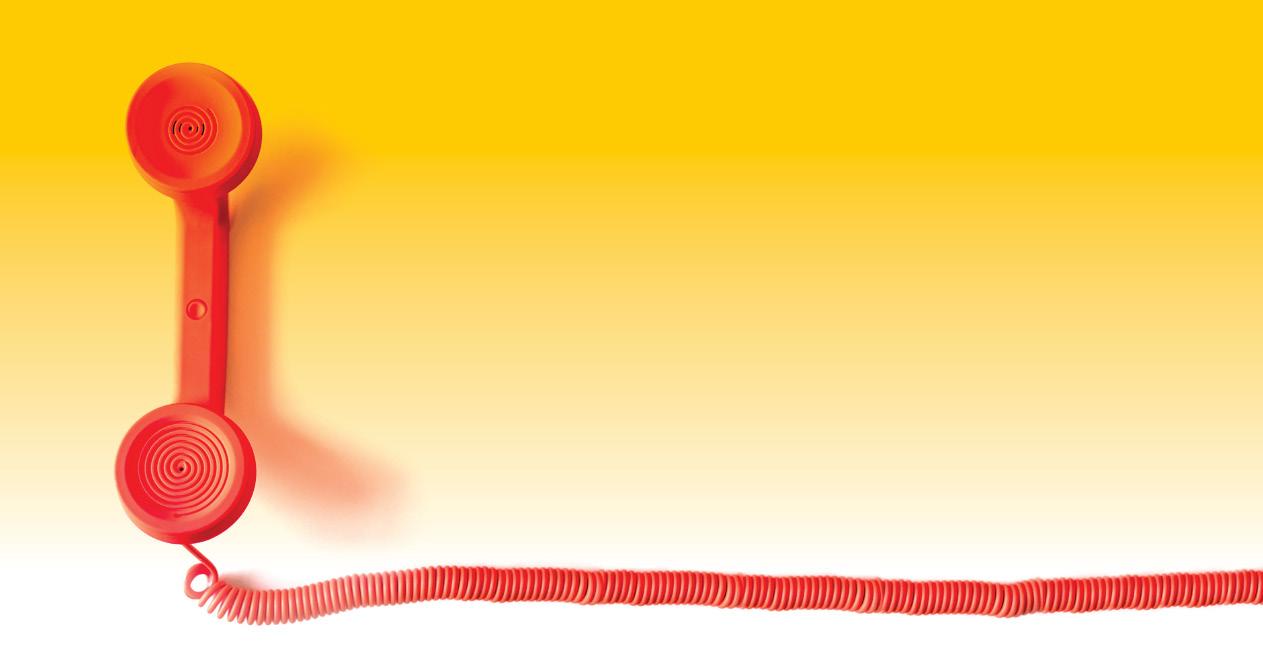
Here are some ideas how to overcome lack of on-the-job support and seek help:
Many times, unhelpful or unsupportive people are acting out of lack of knowledge. Before you text, email, or phone, consider if you are contacting the correct individual. This person may have taken a different position in the company and is no longer current on the issues you need. If you require specific examples of what to do, reach out to someone good at providing practical advice – not someone who offers platitudes like, “You’re smart, you’ll figure it out.”
Make it clear to colleagues and super visors alike where you need help. Do you need support on a particular problem? Do you require assistance to better understand
the project in its entirety? Perhaps you need to just grasp your specific role in it?
Maybe you need greater flexibility to make a deadline. What is it, exactly, that you need? It’s not a good idea to assume that people will automatically know. Tell them
Many times, people are weathering enough challenges of their own to help out. They may not have the time or resources to be as supportive as you’d like them to be. Is it possible you’re asking for too much? This is where realistic expectations come in. Be sure you’re asking for assistance, nothing more. If your requests are excessive, you will need to start giving back before you can expect any support in return.
It can prove difficult to obtain the help you need if there is a big gap in communi cation. An outgoing person may be happy to talk at length about your problem. But if you assimilate information better by watching a video that explains the issue, contact a colleague who will use a platform like this to help. You may not “get” what the other person is saying or the individual you’re asking might not understand your request because of a communication gap.
Network, Network,
that people move away, retire, etc. As noted earlier, no single person knows everything. A network of trusted friends, coworkers, mentors, and the like can help in areas where help and support may be lacking. A change of perspective may be what you need instead of relying on the same person.
We all like to give good advice but we are sometimes awful at accepting the advice of others as it forces us to admit our weaknesses. It’s normal for an individual to think they know more than they actually do. Remember, there is a reason you asked for assistance. Don’t take their suggestion personally. Consider if doing what the person advises will help you professionally. If it will, do it!
In conclusion, never assume a colleague, supervisor or manager under stands what you are asking. Don’t rely on a single coworker for assistance and be sure to reach out to the person who can address your problem best. Good luck.
You can never know too many people! If a trusted colleague quits to take another job with another company and you’ve relied on him exclusively, what then? The plain fact is
Susanne Tedrick is an infrastruc ture specialist for Azure, Microsoft’s cloud computing platform. In her work, Susanne helps her clients address needs and challenges surrounding cloud adoption, cost optimization and migration. Susanne is the author of the critically acclaimed “Women of Color in Tech” and the upcoming “Innovating For Diversity”. For more information, please visit: www.SusanneTedrick.com.


I am an achiever by trade. You can bet if I make a to-do list, it’s going to get to-done. I have high expectations for myself (and others; sorry - friends), and just naturally feel immense disappointment if I don’t hit a goal I set. (Unless of course it’s that goal to lose weight and tone up. WHY is that one SO HARD, am I right?!)
I blame part of this characteristic on my dad. He instilled in me a sense of work ethic like no other. This man worked two jobs most of my childhood. Midnights at a factory, and then drove a school bus during the day. Once he retired from the factory, he then was a custodian at nights, still driving bus during the day. Later in life, he was a tour bus driver, a Brinks armored-security truck driver… this man had more retirement parties than anyone else I know. We started to joke that he started new careers just for those retirement parties.
This work ethic of mine, coupled with my type A personality, makes me a high achiever and hard worker. Oh, I am also a perfectionist as well. You might think this trifecta makes me a bundle of stress. And, it often does. Uncompleted projects or goals put this weight on me that sometimes is only relieved with a good run, good bottle of wine, or good dance party.
In some ways, this is a good problem to have. It makes me an incredibly reliable and valuable employee. It makes me an all-star community citizen volunteer organizations can depend on to help move the needle. It lays a good foundation for being a good friend.
But y’all - this trifecta doesn’t know when to turn off. These high expectations I put on myself, on small goals I make in my “down time.” Goals like, “Sunday I will mow the grass.” Or, “This weekend I will read 150 pages of the book I’m reading.”
“Great,” you say. You lead a very productive life, both inside and outside

of work! And I do. I’ve experienced so much and have become a very well-round ed person.
It is also exhausting. And adds unnecessary stress to my life. And doesn’t always allow time to “just be.”
So let me tell you a little sneaky secret, something I did to flip the script - slyly. This year, I made a goal to fail at achieving. A goal to fail at crossing off my to-do list.
So now, anytime it doesn’t make sense for me to push myself to “finish” something - I can shift my perspective and remind myself I am actually achieving this self-development goal of EASING UP. (I mean really - what difference does it make if I finish a book this weekend, verses next week?)
Special note to some less high achievers out there - this theory/reverse goal plan may not work for you. I have this innate desire to accomplish, and it’s HARD for me to let go of a daily goal I set. Hard like this constant struggle, push and pull to finish what I set out to do or just relax. If you don’t have that inside of you, if your natural go to is to do nothing…well this idea just reinforces nothingness and you may never accomplish anything again.
But for me, I need to push myself to rest. These past three years I’ve needed rest more than any time in my life (includ ing my stint with mono). Emotional trauma is no joke, y’all. Processing a divorce and processing your father’s death at the same time is quite the load. The two men in your life. Leaving you. Your past, and your future. Poof. Gone. At the same time.
You may not notice you need the rest. You do everything right; everything you know to do to cope. You read great books on death and divorce. You exercise. You start watching what you are eating. You practice yoga. You add meditation to your day.
My friends, you do need the rest. You need time, quality time, to recover. Not just
moments scattered throughout the day, but real time to just be. For high-achievers like us, this is hard. “But I could be painting while watching this TV show.” “I should really finish this book instead of napping.”
The high achiever that I am, I decided in 2020 I was going to try to write my first book. Writing a “memoir” style book was something I had been tossing around in my mind for a few years now - I even had a Note in my phone with all the experiences and stories and life lessons I wanted to share. The divorce, my father’s death, the pandemic…wow had life given me lots of additional content for this book just in the last two years alone.
I had heard about the NaNoWriMo November writing challenge, and even had a few friends participate. It’s a novel-writing challenge, where each day in November you had to write 1,600 words a day. The goal is to have 50,000 words by the end of the month, of a brand-new novel.
This sounded HARD, even during a pandemic. I was using November to get back into the book The Magic, which is a daily gratitude challenge, with lots of writing and reflecting. I was trying to work out more. You had Thanksgiving. And my birthday. And it was the first of both of these without my father. I had a friend coming to stay with me, and a quick visit to Savannah.
I decided to give it a try though. I had two friends who were also doing it, so there was strength in numbers and accountability partners. I downloaded a program to help organize my writings. I started a few days early; downloading the program and inputting the story ideas. I made a few modifications. I chose to write my memoir, not a novel like the challenge was intended. And, I was only setting a goal to write 1,000 words a day. Look at me - the underachiever!
Week one - HUGE success. I could already feel myself being lighter. Who knew writing was so therapeutic?! (All writers and psychologists know this.) The first day I focused on editing and re-reading my work…but from day two onward I just wrote. I just wrote to get it out. Editing could come later. And the words flowed.
Week two - still at it! I was loving this! I had a nice little morning routine; writing, doing my Magic gratitude practice, walking or running my dog. I was loving my morning life!
Week three - started fine. Then that weekend and into week four -uh oh. Vacation - days completely filled enjoying and exploring Savannah. My friend staying with me for a few days. Thanksgiving. My birthday weekend. Decorating for the holidays. Yikes. I missed 10 whole days. Ten!! That’s 10,000 words!
I had visions of catching up. I could write 3,000 words a day; I could! I had a long weekend. I didn’t have too many plans. I had to catch up. I couldn’t fail at my goal. I could DO this.
But - I didn’t want to.
That goal, that expectation…it started weighing on me heavily. WHY?! Why did it matter if I wrote exactly in the time frame I had set out to do? What harm would it be to take a short break? It had been Thanksgiving week. It was my birthday. I had a friend in town…didn’t I deserve that break, and need that rest, too?
I slowly have started discovering that what I truly need is grace. Grace for myself as it related to self-productivity. Why was I constantly pushing myself SO HARD?! These unrealistic expectations to always be moving, always completing, always accomplishing…they are only in my life because of ME. I have put this weight on my own shoulders.
I imagine there is a ton to unpack here psychologically, and I am confident I am not qualified to do it. What I do feel is that
it is in my nature, my very being to always be thinking about “what’s next” in my life, my year, my month, my week, my day, my hours. At my core I know there is so much to see and do and experience, and from my project management skills I know time can fly by and escape us. I’ve read count less self-help books and business books about time management. “168 Hours - You Have More Time Than You Think” by Laura Vanderkam is a great source to jump start your productivity.
Y’all. I’m writing right now about giving yourself grace for rest and down time and I literally just quoted a book on increasing productivity. What is wrong with me?! In lieu of an all-out therapy session, let’s just say I like to be productive and accomplished and there’s probably some messed up craziness behind it I’ll need someone licensed to help with.
Now back to grace, and rest, and being. And to put it into words my achieving heart can understand, a goal to fail my to-do list.
I started really thinking about those 10,000 words I had failed to write. There were no immediate threats to my life or my long-term goals if I let these words go. If I gave myself grace for that week and just failed that item on my to-do list. So I told myself, “Let it Go.”
And you know what - I’m still alive! I re-adjusted my sails and decided to take the NaNoWriMo Challenge into December. My goals had served me well in jump-starting a habit of writing; I had successfully re-discovered my love for the craft. And I had also granted myself grace.
A month ago, I reconnected at lunch with a friend - another powerful, spiritual, kind soul who had also had a pretty horrible year. Same sort of circumstances - husband separation, death and illness in the family. She recounted a story in which, prior to her separation, she had been complaining to her husband about some minor business issues. Nothing majormainly slight irritations and desire to make
herself even MORE successful (she was already a rockstar). She became animated when she got to the point of her story… how now, looking back - she screams, “Who cares?!” It was the manner, the forcefulness, the heart of her continuing to scream, “Who cares?!” at me that really was impactful. Indeed. WHO. CARES.
At the end of life, you aren’t going to care if your business was irritating at times. At the end of life, you aren’t going to care if it took you an extra week to write some words on a screen.
Part of me, on a deep psychological level, is still a little bothered with my push for success. Even my *not so sneaky way of setting a goal to fail…well, it’s still setting a goal and I still get to say I succeeded in that goal, even if I let another goal go. A therapist would probably say this is messed up and I have deep success, desire for accomplishment issues. The more I write about this, the more I would agree. I suppose I should work through these issues a little more, and maybe someday I will. But for now? WHO. CARES?!
The International Festivals & Events Association is pleased to announce the induction of one of the festivals and events industry’s finest professionals into its prestigious IFEA Hall of Fame – Gayle Hall, CFEE, former Director of Festivals & Events at the Grapevine Convention & Visitors Bureau in Grapevine, TX, USA


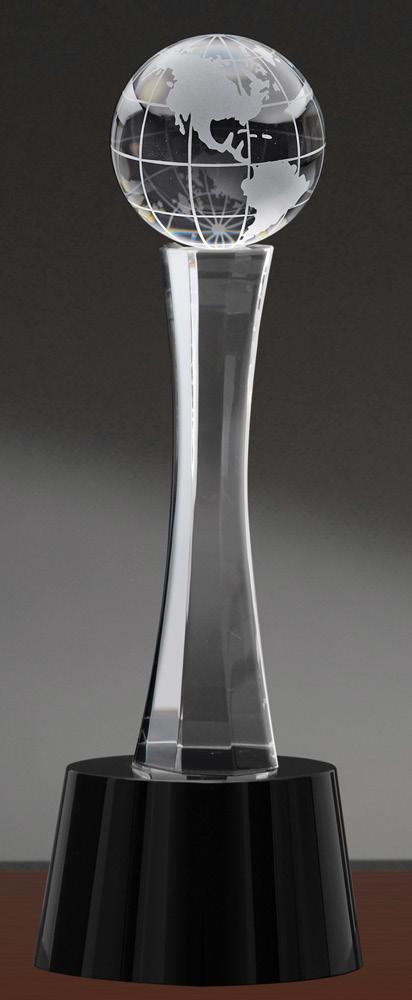
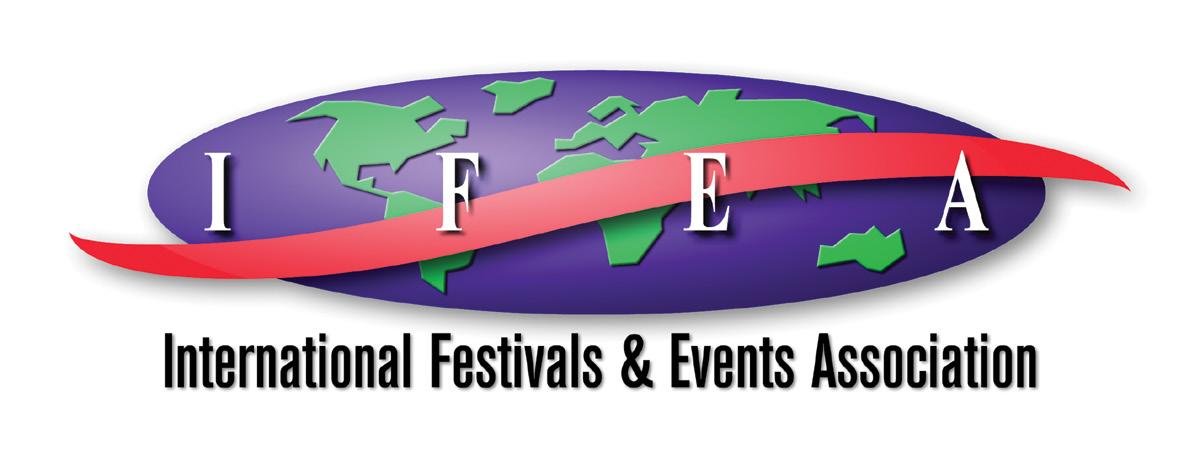
Known as the association’s most prestigious honor, the IFEA Hall of Fame recognizes those outstanding individuals who, through their exceptional work and achievements, have made a significant contribution to the Festivals and Events Industry and a profound difference in the communities they serve. Induction into the Hall of Fame is considered the highest of industry honors. Selected from a group of his industry-peers, Gayle joins the prestigious ranks of 63 others inducted into the hall over the past 32 years.
Gayle was honored and remembered at the 65th Annual IFEA Convention, Expo & Retreat presented by Haas & Wilkerson Insurance, in McAllen, Texas, USA, during the IFEA Awards Luncheon on Wednesday, September 21, 2022.
Long before she was hired by the City of Grapevine as a Festivals and Events Manager in 1989, Gayle Hall was on the Volunteer Steering Committee for Grapevine Festivals. With her leadership, dedication and hard work, the many festivals and events in Grapevine that Gayle helped produce, including Main Street Fest, GrapeFest
and Christmas Capital of Texas, are a major reason that it is now a destination with 2.3 million visitors every year.

“The festivals grew because ... they were produced at such high quality,” Grapevine Mayor, William Tate said. “Gayle was able to produce an environment through her organization and leadership ... where people wanted to come back year after year.”
As a fifth-generation and lifelong resident of Grapevine, Gayle had a unique connection to the community. From being named “Miss Grapevine Lake” as a teenager, to her early years working with the family-owned Midway Camp, Gayle had lived the history of Grapevine and was able to use that insight in her extensive career producing festivals and events, allowing them to maintain their strong emphasis on Historic Preservation, while still being innovative and appealing to multi-generations.
Gayle was a natural leader with a “get it done” attitude that became her moniker. When she saw the extensive amount of work it took to set up festivals and events, Gayle became a charter member and organizer of the ‘Grapevine Dirty Dozen’, a group that specializes in all the behind-thescenes dirty work, to ensure the countless and seamless memories for all those attending. Gayle was also instrumental in the formation of the Grapevine Wine Pouring Society, a group that provides volunteers to showcase and educate the public by serving wine at festivals and events and other community organizations. And when a group of volunteers mentioned that they thought Grapevine needed a group to help educate the public on Craft Brew, she provided them the path to get started and became a Founding member, as well.
“You’ll see a million pictures of [Gayle], having been involved in running festivals, and she’s always got the headset on,” Grapevine Mayor Pro Tem, Darlene Freed said. “If there was anything that you needed to get done during a festival—one call to Gayle, and we knew it was taken care of.”
Gayle strongly believed in giving back to her community. When she saw that the wandering trails of cord covers and hoses on the ground at local festivals
were making it difficult for wheelchairs and strollers to navigate the walkways, Gayle sought approval from the City Council for water and power lines to be run underground in the middle of seven blocks of Main Street, providing attractive pedestals with multiple outlets for vendors to access during events.
And Gayle clearly understood and valued the importance of relationships. Knowing that a number of the festivals in Grapevine caused Main Street to close for several days, Gayle and her team went out of their way to educate businesses on what to expect from the closures and to provide opportunities for them to get actively involved in the festival footprint. To ensure that the equation was always’ win-win’ for everyone, Gayle and the festival team hired local school and civic organizations to be paid volunteers. Utilizing 33 such groups at GrapeFest and 28 groups at Main Street Fest, these funds allowed for multiple organizations to continue their charitable work.
Through hard work, dedication and her ability to make things happen, Gayle was the driving force in the continued improvement of Grapevine’s many festivals and events.
To have an event named to the American Bus Association’s “Top 100 Events of North America” is a huge honor, and Gayle successfully was able to have GrapeFest and the Christmas Capital of Texas, both receive this honor. Understanding the impor tance of industry awards, Gayle, along with the CVB staff and volunteers, completed a winning application to name Grapevine, Texas as an IFEA World Festival and Event City in 2012, in addition to entering and winning many IFEA/Haas & Wilkerson Pinnacle Awards. But while rightfully proud of her events and city, she felt it was important to enter award competitions not just for the awards, but to share best ideas and concepts with others.
Gayle learned the festival and event business on-the-job, by reading industry books, attending other events, and going to as many seminars and conventions as she could, so that she could learn from and network with other festival and event professionals from around the world; even when that meant traveling the world to do so. She recognized early-on that education and certification was utmost in leadership and sought out becoming an IFEA Certified Festival & Event Executive (CFEE) and a Texas Certified Festival Professional.
Gayle placed a high importance on sharing knowledge within the festival
industry, spearheading the first “Texas Event Summit”, a joint conference of the Texas Festivals and Events Association (TFEA) and the Texas Association of Fairs and Events (TAFE). She went on to coordinate the first Festival Exchange with the Heritage Harbor Days in Foley, Alabama and the National Cherry Festival in Traverse City, Michigan, for which she was awarded the CVB Directors Award. Training the next generation of festival managers was important to Gayle and she was very involved with the Grapevine CVB internship program, sharing not only her time, but her extensive knowledge in hospitality and festivals. She made sure each intern spent time with Grapevine Festival Volunteers so they could see all aspects of festival operations in real life.
Her commitment to Grapevine and civic organizations earned Gayle countless accolades and awards, including: Grapevine Woman of the Year; the TFEA/ Dr. Carson Watt Professional of the Year Award; and the TFEA Hall of Honor Lifetime Achievement Award; among many others. She proudly served on the IFEA Foundation Board, in addition to serving as a board member and President of the Texas Festivals and Events Association; Texas Association of Fairs & Events; and the Grapevine Heritage Ambucs.
Sadly, Gayle was taken from us far too soon, in August of 2021. Her ‘Celebration of Life’ was an event for the ages in Grapevine. Named “Gayle’s Taste of Grapevine”, 18 local restaurants provided food and beverage for the occasion as Gayle took one last journey down her beloved Main Street on a horse drawn hearse. 250 of her closest friends, family, and colleagues walked alongside her down the Main Street mile in 90-degree heat, in honor of the remarkable woman they knew and cherished. She would have loved it!
Gayle would have been so honored to receive the IFEA Hall of Fame Award. She had so much respect and admiration for all the industry professionals that helped her along the way. Even in her passing, Gayle continues to impact future generations of festival and event professionals through her ‘Get It Done’ IFEA Foundation Legacy Scholarship, which will continue, as will all that she shared with so many of us, in perpetuity. Hers was a life and career that we can all aspire to.
Please join us in honoring and remembering our 2022 IFEA Hall of Fame inductee, Gayle Hall, CFEE.

Whether you are in-person or remote, build connections that make a difference.
By Jasmine FreemanHow connected are you and your team?
Are you simply getting the job done, or are you getting it done with precision focus, feeling in flow and maximizing the time and talents of your work unit in the process?
We have all been witness to the sweeping changes of our work cultures since the COVID-19 pandemic. In this new world, many of us now have some level of experience with working remotely. In fact, some of us will not be returning to the office as-we-knew-it. COVID-19 flipped everything in our industry on its head and our way of working was one of the many things that completely changed. While some of us have returned to our brick-and-mortar offices, that is not the case for everyone.
Many of our colleagues have been thrust fully into remote working and not only are they navigating how to work efficiently in this environment, they are working through the ‘how’ of staying authentically connected with their teams.
We’ve also seen a shift in how hard our team members are willing to work. Quietly quitting the hustle culture for a more balanced work/home life.
Leadership starts with you. Whether you hold the title, or not. Let’s explore some ways to better engage as teams to offer a more worthwhile and connected work experience, build better communication and create a more engaged workforce.
According to Gallup’s 2022 State of the Global Workplace, only 21 percent of employees are engaged in the workplace. 79% of employees are disengaged, which means they likely have a negative view of their workplace or they only deliver the bare minimum. Layer in the isolation that working from home can bring and we’ve got some completely disconnected folks out there.
Quiet Quitting is the newest trend that everyone is talking about, but it’s not a new practice. According to TikTok user @ zaidleppelin, quiet quitting is not outright quitting your job. It is quitting the idea of going above and beyond. You still perform your duties but you no longer subscribe to the hustle culture mentality that work has to be your life. The popularity of this term shows where we are at as a culture. What if we all had a little bit more connection and feeling of appreciation from the people we worked with, would we still feel the need to disengage?
Working from home creates a whole
new kind of isolation, we lose out on the little things like catching up over coffee, checking in to see how your colleagues spent their weekend, finding those people in the office who share similar interests or taking time out of the day to meet up for lunch. We’re no longer tapping into those resources around us that help us to grow and further develop as professionals. We lose the opportunity to create and build meaningful and authentic connections with one another.
It doesn’t have to be that way. We can and will rise above this hurdle with a tenacious resilience.
Connection with those we work with is much more than simply being able to do your job. This is about staying relevant and impactful in today’s workplace as well as gaining and maintaining your influence.
Let’s take a look at some tips and ideas to help team leaders create authentic connections and increase engagement within their teams.
Several years ago, I worked with a team of five people. A small yet mighty force; we were proud of what we created on a global scale. Our team grew close over the years, like family. We had a practice that we all looked forward to in our office, we called it the ‘daily huddle’. We would come together every morning for a daily five-to-ten-minute meeting.
The daily huddle was a time designated for each of us to talk about something that wasn’t work related. We took turns leading the daily huddle based on five key areas we identified as an area we valued.
We didn’t realize it at the time but consistent focus on these five areas was a holistic approach to employee wellness.
We called this the five pillars, and they are:
1. Career: resources and ideas focused on professional development
2. Family: relationship nurturing with family, significant other, close friends, pets
3. Financial: resources education to strengthen financial health
4. Spiritual: soul-filling whether it is nature, religion, meditation
5. Wellness: resources for your overall well-being
Each day we took turns leading the huddle with a specific focus on one of the above topics. We might have brought an exercise, shared a thoughtful bit of infor mation or a challenge for everyone to try.
The lovely thing about the team huddle
is that it’s completely up to you on how you’d like to design it.
• Determine the frequency of how often you’ll meet. A suggestion would be to try to huddle daily or once a week.
• Communicate the importance of making this huddle a priority. Whatever you decide, it is best if you stick to it consistently, it should be a priority for your team.
• Decide the format and what you’ll discuss.
• Stay away from work, focus on building relationships and rapport
• What’s on your mind this week
• Question of the Week
• Share some love or “high fives”, a way to express gratitude for one another
• 2-minute check-in per person based off the ‘Q’ of the week
• It is okay to share what’s happening in your personal life.
• When your team feels safe and trusting of one another, they may express more vulnerable shares. Is this something you are okay with or will you have ground rules in this area?
• Keep it short! If this meeting takes too much of your team’s time, they are less likely to stick with it.
During lockdown, I found myself again part of a small team. Many of our staff were on furlough or reassignment. Those of us who were tasked with maintaining day-to-day operations met every day with purpose via our preferred video-meeting software. At the end of the week, we changed it up, we focused our meeting exclusively on a “how are you doing” format. We took the time and spoke about how we were coping with the latest developments of the COVID-19 pandemic. There was a lot of ground to cover every week and as we virtually linked arms and had this vulnerable moment with one another we were able to be there, listen, provide support or be supported depending on where we were from week-to-week. I was surprised at how many of us missed the opportunity to do this with our work force during lockdown, but it’s not too late to start checking in and building connections now.
I stumbled across one of my favorites, Simon Sinek, and his long-time
remote-working team during their very own huddle. I was so happy to bear witness to the way they orchestrated this practice and learned some new things to share with you.
Highlights:
• Build trust through establishing relationships with each other
• Accomplish more as a team by taking the time to pause and celebrate one another
• Try using a ‘Question of the Week’ I encourage you to take time to see an example of their team huddle in action at https://youtu.be/tKEtm3HCrsw
It’s a little easier to identify when someone is really present with us when we are in-person, so my focus here will be more on how to ensure you and your team members are fully present in the virtual environment.
Have you noticed that the virtual meeting has quickly modeled after our in-person meetings? Our schedules are packed all over again and we have literally zero minutes in between these back-to-back appointments throughout the day. This has us ‘showing up’ with half our attention on the screen while we try to tackle our inbox in the background.
As you begin to craft your huddle format, consider this, it is important to take a moment to allow everyone to become fully present for this time together.
When I had the opportunity to speak at a virtual learning event, I used an exercise that I found to be a great resource. This is a way to bring your team together and allow them to become fully present before you even get your huddle started.
The source: Chad Littlefield, Co-founder, Speaker, Author and Creator of We! Connect Cards. Chad is an expert at helping people ask better questions to build more authentic connections.
Using these methods can allow us to better show up for one another and ourselves.
When joining your team meeting virtually try these steps together in this order:
1. Silence; observing a moment of silence to allow everyone time to fully arrive at the meeting.
a. One of the great lost arts of conversation is silence, allowing this open time for people to pause and reflect before jumping into your next topic.
b. Ask yourself, “when can I give my group time to take silence and reflect?”
c. Invite your team to be present. d. Guide your team with 60 seconds of silence. Help everyone shift from whatever they have been to doing to being completely present here with the team. Challenge them to resist the urge to pick up their phone, switch tabs to another browser, check email. You can move into step three as you wrap up this step.
2. Podcast Mode, next you ask your participants to enter into “Podcast Mode.” Podcast mode is simply asking everyone to turn off their video function, keeping sound activated. While video is off:
a. Check your state of mind. Are you... i. Feeling Great ii. Exhausted iii. Overwhelmed iv. Low moral
b. Make a physical shift to change that state of mind i. Shift Your State; you will take a brief moment to allow everyone to be aware of ‘shifting their state.’ That can be as simple as changing their position physically, such as sitting up in their chair.
c. Change your last name to the mental state you would LIKE to be in
i. Peaceful, zen, happy, energized ii. Example, my name would then read: Jasmine Energized d. Your team members will then set their intention and motivation following your invitation
3. Show Up
a. Now it is time to turn the video back on and hide self-view if you can find that option.
i. One of the biggest contributions to “zoom fatigue” is that we spend so much energy in conversation with others while simultaneously looking at ourselves while we are talking to someone else.
ii. It takes up an enormous amount of cognitive ability to do this.
iii. Simply “hiding self-view” allows you to be REALLY present with the people you are with.
b. Decreases exhaustion, low motiva tion or lack of drive to engage.
Try this practice next time you are leading a huddle with your team virtually to allow everyone time to become present and show up as the person they intend to be.
By engaging with your colleagues in a way that shows you value your time together, you will build stronger bonds and demonstrate that you have respect for your teammates.
1. Be present, turn off notifications/do not disturb, get your water.
2. Use headphones to protect their privacy and maintain confidentiality.
3. Be prepared, organized and useful.
4. Use visual cues or reactions to quickly communicate, thumbs up, speed/ slow timing.
5. Have a clean, designated work space.
6. Have an order or system in place regarding how to pass the conversa tion around to others.
7. Have clear expectations.
Be aware of how your team members are doing. Take the time to check in with them and ensure they are alright. It’s okay to not be okay, but do your team members know this and feel safe communicating with you when things aren’t going so well?
As you begin to craft your huddle format, consider this, it is important to take a moment to allow everyone to become fully present for this time together.
• Did something seem off with your co-worker today?
• Are you not quite sure how your email was received but it feels like your peer has been acting strangely ever since you had expressed some concerns about a project you are working on together?
• Is someone missing or withdrawn?
Calling someone and having a conversation, person-to-person, real time can make all the difference. Have an honest conversation. Be open with your intentions.
Examples of expressions may be:
• I noticed something feels off, is it me?
• I felt it was worth a call to check in ...
• How are you doing right now?
Be understanding and respectful if your colleague doesn’t want to talk about it. Reaching out will let them know you value them enough to notice and care enough to reach out and ensure they are alright. Establishing trust and stronger bonds takes time, you won’t see success overnight.
As our environments shift and our staff learns how to set new boundaries around work for themselves, leadership has a great opportunity here to help their teams stay connected and thrive.
You can also put trust into your team to experiment with ways that they feel most authentically connected with others. Open an invitation for them to choose what they would like to do. Need some help getting started? Explore these methods to create better connections:
• Schedule in-person or virtual lunch dates
• Create a space to post photos of pets
• Host an organization-wide book club
• Have a monthly online ‘lunch and learn’ featuring speakers and topics that are of interest to your team
• Have a post-work cooking competition or experience amongst the team using a service like ChefTorial
• Volunteer together
• Plan an organization-wide virtual talent show
Creating connection and engagement with your team can and should be fun. Search for ways to engage with one another that works for your team environ ment. I’ve shared some examples below to get you started. Of course, as with all of the other ideas shared in this article, you
can tailor these ideas to fit your own team. In fact, I encourage you to do so!
1.
a. Ask each member of your team this question, ‘What is something YOU know really well?’
b. Then ask! ‘How did you get to know a lot about X?’
c. This activity is more about being intentional and engaging in conversation. You’ll be surprised what you learn about each other.
a. One of the festivals I work with hosted a concert and happy hour zoom for their team. Even a simple happy hour to hang out and chat would be beneficial. If you prefer to keep it alcohol free, a virtual coffee/ tea chat could be just as much fun for your team.
a. Surprise your team with a quick scavenger hunt during your meet ing. Have them engage by coming back with specific items. Tie those items into the meeting purpose if you’re feeling extra creative or just do this for fun and an excuse to get up from our desks and race around for a few minutes.
I’ve been encouraging you to take the time to get to know and engage with your team. Doing this will take a certain amount of effort and conversation with them. Asking powerful questions, at the right time, can help you to begin forming those bonds.
The gift of conversation doesn’t come naturally to all of us. Having a few prompts ready to dive into deeper communication can ensure you facilitate more meaningful connections. Pick something from the list below or come up with your own to try and see what works.
• What is something that made you smile?
• What is something kind someone has done for you?
• What is something that amazes you?
• What is something that you know really well?
• What is something you miss from the past?
• What is the most adventurous thing you have ever done?
• What is one of the most meaningful affirmations you have ever received?
• Focus less on yourself and more on the other person
As members of the International Festival and Events Association (IFEA), we witnessed firsthand how to begin using virtual platforms to create bonds with people we barely know.
Take the IFEA Affinity Groups for exam ple. We assembled during the pandemic and are still meeting monthly with one another, sharing our experiences, trying to understand it all, collectively wishing we had a crystal ball.
How many of us have stayed in touch with connections that were made with people you may never see in-person? What made the difference for you in building that connection?
I encourage you to give a few of these ideas a try and create conversations that matter among your team members. The benefits of successfully achieving connection will continue to provide rewards to you and your colleagues. You will have gained a piece of knowledge and appreciation for one another - rather than just a face in a box on the screen.
I’m not asking you to expect that your staff will become best friends, but you can give them the opportunity to build authentic connections and relationships with one another within their own comfort level.
Organizations achieve greater retention through relationships.
Inspire your people to stay at a place they feel respected and heard. Even if they don’t physically see you every day, they can feel like a valued and connected part of your team.
‘n’ Roll Race Series, Chinese New Year, PRIDE, the High land Games-Celtic Festival and the Mint 400 Off-road Racing Festival.
Networking is important for our personal and professional growth. We may forgo an event, conference, or meeting, offering a myriad of excuses: “Another networking event, I did not meet anyone the last time.” “I can skip this one – there will be more.” “It’s raining, too cold, too hot.” “I’ve had a long day..I won’t know anyone.” Excuses, excuses!
Networking is an opportunity to meet new people, spend time with colleagues, reinforce current relationships and learn new things.
In the spirit of the Girls Scouts, “Make new friends, but keep the old; one is silver and the other’s gold.”
Your networking toolkit is amplified by GRACE (Gratitude, Relationships, Attitude, Communication, Enthusiasm).
Be grateful for the opportunity to network. Whether you are a student or a seasoned employee, networking is crucial. Your network is comprised of friends, friends of friends, classmates, alumni, career services, organizations, community, non-profit organizations and professionals in both your field of business and other corporations. If you are new to a community, offer to volunteer. Everyone has an expertise and an extra set of hands is always welcome. Smile, be pleasant, introduce yourself to others. Attend industry and community events. Share your ideas, advice and knowledge.
How extensive is your network? Relationships expand beyond “knowing” a person. Do you reach out solely when you need something? What do you do to keep in touch with and potentially assist your network?
“Collect” people you want in your life. Stay in touch in a meaningful way which will assist you in forming, maintaining and expanding a strong contact base and circle of influence. Take time to listen and learn more about the people in your life. Comment on their business social media posts, send an interesting article via email or post, reach out during holidays and birthdays with a thoughtful email, text and handwritten card. Plan a weekly, monthly, quarterly coffee meeting, lunch or “walk and talk” with the people in your life.
Reset your attitude to “give” versus “gain.” By “giving” in networking, your gain will be exponential. As we listen to others, we learn about their goals and aspirations. How can we assist them? As your network grows, how can you help others enhance their career or achieve their goals through your contacts?
Everything Communicates! From your “grand entrance,” to your handshake, attire and body language; your message is conveyed. My mother always counsels us: “to be interesting, be interested.” Ask questions that focus on the other person, listen thoroughly and do your best not to interrupt. When you concentrate more on listening than talking, it is a sign of respect. A few questions that you might ask include: “What an interesting job you have, how did you get started?” “What are current trends in your industry?” “What do you enjoy doing when you are not working?” “Have you attended this networking event in the past?” Stay current in regard to news, movies and books. Become an expert in your respective field of study or interest.
When you are passionate about other people, networking “to give versus gain,” follow up on promises made and stay in touch in a meaningful way, you will be branded as an caring professional and person people enjoy spending time with. This positive energy becomes an extension of your personal and professional brand.
Are you ready to network? Pack your networking toolkit with a smile, positive attitude and neat attire. Bring plenty of business cards and breath mints. Enjoy!
 Gail Lowney Alofsin is the Director of Corporate Partner ship & Community Relations for the Newport International Boat Show, a division of Newport Restaurant Group. An ad junct professor at the University of RI and Salve Regina Uni versity, author, speaker and volunteer, Gail lives in Newport, Rhode Island. Gail can be reached: gail@gailspeaks.com or 401-640-4418. For more information: gailspeaks.com
Gail Lowney Alofsin is the Director of Corporate Partner ship & Community Relations for the Newport International Boat Show, a division of Newport Restaurant Group. An ad junct professor at the University of RI and Salve Regina Uni versity, author, speaker and volunteer, Gail lives in Newport, Rhode Island. Gail can be reached: gail@gailspeaks.com or 401-640-4418. For more information: gailspeaks.com


As a professional in the Festivals & Events Industry, you know the difference be tween Good and Great. You’ve dedicat ed yourself to the “whatever it takes” approach that has become your hall mark. You understand the importance and value of continuing to hone your skills, growing your knowledge base, expanding your professional network, and surrounding yourself with others who have reached the top levels of their careers as well.
CFEE (Certified Festival & Event Execu tive), the IFEA’s professional certification program, provides the essential difference between good and great among profes sionals in our industry. It signifies the highest level of achievement. Attainment of your CFEE certification provides recog nition of your commitment to excellence, experience, and to your career, placing you in an elite group of the top festival and event professionals in your field. It’s a state ment of quality that you bring to the table.
For more information about the IFEA’s professional certification program and our CFEE FastTrack® Program, contact Cindy Lerick at cindy@ifea.com or call +1-314-614-7152.
The CFEE Professional Certification Program is Sponsored byThe International Festivals & Events Association is pleased to announce the induction of one of the festivals and events industry’s finest professionals into its prestigious IFEA Hall of Fame – Janet Landey, CFEE, CSEP, Founder of Skills Village 2030 and President of IFEA Africa in Johannesburg, South Africa.
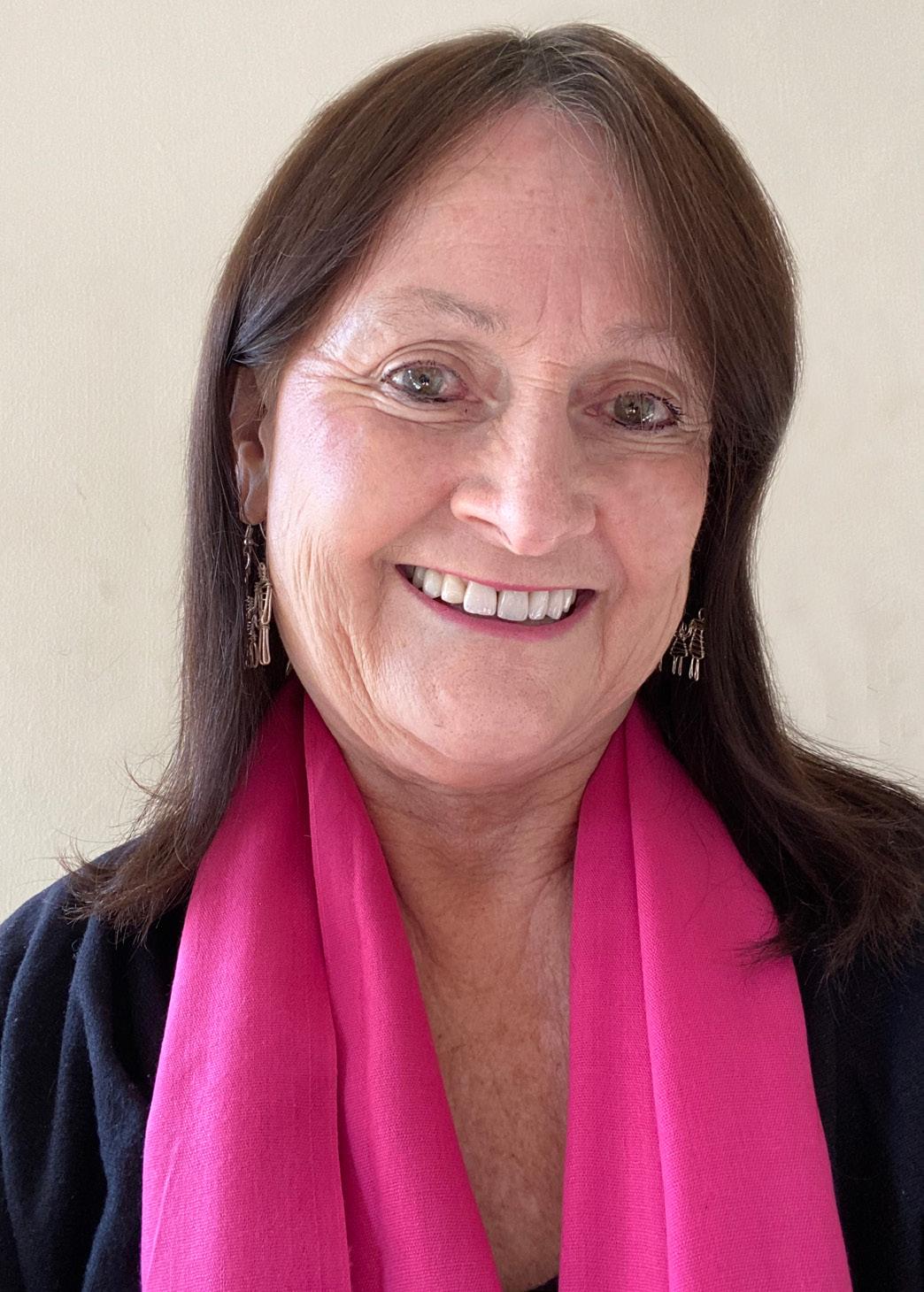



Known as the association’s most prestigious honor, the IFEA Hall of Fame recognizes those outstanding individuals who, through their exceptional work and achievements, have made a significant contribution to the Festivals and Events Industry and a profound difference in the communities they serve. Induction into the Hall of Fame is considered the highest of industry honors. Selected from a group of his industry-peers, Janet joins the prestigious ranks of 63 others inducted into the hall over the past 32 years.
Janet was celebrated and recognized at the 65th Annual IFEA Convention, Expo & Retreat presented by Haas & Wilkerson Insurance, in McAllen, Texas, USA, during the IFEA Awards Luncheon on Wednesday, September 21, 2022.
Janet Landey has lived a life of big visions…visions that have changed the realities of countless thousands of individual lives and organizations, both close to home and around the world.
With husband, Crispin, by her side and cheering her on since their marriage nearly 50 years ago, their multi-generation family now numbers 82 and counting! A family that, with her eight brothers and sisters and their families added in, learned quickly that life was going to be about special events…lots of them, and welcomed everyone to join the celebrations.
Janet ‘officially’ started her career in the 1970’s with a toy company –Tri-Ang Pedigree - and motivated by the birth of their first child, she started making Cabbage Patch Kids clothing for a licensed toy company in South Africa. With over 50 sewing machinists and a creative artist, the business soon expanded into making licensed character costumes for Smurfs, Care Bears and Womble merchandise. Perhaps it was a desire to celebrate the success of that early endeavor that led her to create her next role as the Founder, Event Architect and Chief Experience Officer of PartyDesign, a Johannesburg-based event design and décor company, whose expertise and visons were equally at home providing the joy of small (but life-changing) birthday parties for underprivileged children (something that she continues to provide today), to celebrations honoring the birthdays and release from prison of South African President and global icon Nelson Mandela.
Janet’s hand extended into global-focus events like the 2010 FIFA World Cup; the training of 2500 volunteers for the ICC Cricket World Cup; and the on-field entertainment for the 2005 World Cup Rugby match, including an unforgettable moment for everyone when she arranged for a Boeing 747 to fly over the stadium, with messages of ‘Good Luck’ stenciled on the underside. A moment captured forever through a painting signed by Mandela, the pilot and even the 747 itself making it’s mark by taxiing over the bottom right corner with a paint-splattered nose wheel. While at the same time she was growing the success of her children’s events, recruiting the involvement of such world voices as Dr. Jane Goodall to launch a new ‘Roots and Shoots’ program for local children, with a larger, long-range goal of creating jobs for youth through the implementation of Sustainable Development Goal (SDG) events, activities and memorabilia.
It didn’t take long for Janet’s focus to move from the excitement of events to the power of events and her BIG dream and vision of using events as a positive platform for social inclusion, environmental health, and the sustainability of communi ties by maximizing the multiplier effect of

The long history of planned events was given a major acceleration through the phenomenal leadership skills of Janet Landy. From the cradle of civilisation in South Africa, two decades ago Janet joined the embryonic discussions that resulted in the creation of the Event Management Body of Knowledge (EMBOK) which became the first ever codified body of knowl edge in the field of planned events. Along with others, she helped give birth to a new and globally respected profession that creatively and safely brings people together through festivals and events for mutual benefit and results in producing greater knowledge, peace and harmony for all. Her contribution will be historically recorded as one of the major milestones in the positive development of this noble profession.
Dr. Joe Goldblatt Emeritus Professor of Planned Events Queen Margaret University Edinburgh, Scotlandwhat we all produce and do.
Her global journey toward that vison led her to cross paths with many other passionate industry leaders, peers and mentors (Joe Goldblatt, Bill O’Toole, Glenn Bowdin, Don Getz, Julia Rutherford-Silvers, Philip Mondor and others among them) who – together – created a foundation and roadmap of event knowledge (the Event Management Body of Knowledge – EMBOK - the first ever codified body of knowledge in the field of planned events) – that has led to much of the formal university-level training and governmental support that our industry enjoys today.
After having met years earlier, in 2007 Janet invited IFEA President & CEO Steve Schmader to join the conversation at a South African EMBOK symposium, which resulted in the beginnings of IFEA Africa and Janet’s role as the President of that new global affiliate, helping to build the global IFEA brand, while further positioning the organization as a leader in education, professional certification, sustainability and life-changing empower ment through festivals and events.
A path that led to her roles on the IFEA World Board from 2013-2021, including service as the IFEA World Board Chair in 2019 and the coming together of her IFEA family with her own in South Africa. An opportunity to share one of her greatest achievements…the creation and visionary management of Skills Village 2030 in Bez Valley, Johannesburg. Skills Village 2030 is a cooperative village, providing a workplace experience for hundreds of South African youth that uses festivals and events to bring to market commodities, goods, services and
experiences unique to the local community. Believing that events build ‘communitas’, competency, capacity and personal capa bilities that matter to everyone they touch –internally and externally – Janet designed the Skills Village 2030 platform to use practical event activities to raise workspace experien tial learning opportunities that can prepare young participants with single-occupation training, to learning that can be translated to a cluster of other related occupations, based upon common knowledge and skills; a desire for lifelong learning; and cross-training and alternative pathways for progression and growth, through the end result of producing a Community Market Day. All skills of which can contribute to solving the global challenge of unemployed youth.
Janet’s impact on our global festivals and events industry is perhaps most humbly obvious in the multitude of proud, empowered, well-trained, confident and secure graduates of the Skills Village 2030 program. An impact best summedup by a small, local South African event director at one of the early international EMBOK gatherings in Johannesburg. When asked by IFEA President & CEO, Steve Schmader, what resources they needed more of to be successful, their quick, sincere and thoughtful response was, “We need more Janet’s.”
There are very few people in our global industry who have touched and impacted so many – close to home and around the world; individually and collectively; personally and professionally – than Janet Landey.
Please join us in congratulating our 2022 IFEA Hall of Fame inductee, Janet Landey!
I hate to make your next eight weeks a bit crazy, but NOW is the time to reach out to sponsors for your 2023 event. It’s not about your timetable. It’s about theirs!
Approximately 65% of publicly traded companies operate on a calendar-based fiscal year that runs from January until December. Even more smaller and privately-owned businesses start their fiscal year in January.
That means that they have already started their planning and budgeting for Fiscal 2023. If you want to be included in their 2023 budget, you need to in front of them by early December! Even if their sponsorship decisions are not made until early 2023, you want to be in their consideration pipeline before the end of the year.
Start with your renewals. These folks already know you, and hopefully love you. They have likely allocated a budget line for you based upon their 2022 investment. Use your post event report as the opportunity to review their 2022 experience and for you to put the 2023 renewal package in front of them.
Next, I’d approach any declines from 2022. Reconnect with brands that expressed initial interest in your event, but for one reason or another declined. They already have a sense of your event and the sponsorship opportunities you provide so these leads are going to be your warmest.
Then you approach new prospects with your sponsorship opportunities deck and begin the conversation.
Time is either your friend or your foe…make it your friend. Traditionally, I have looked at the sales timeline in three phases:
• Strategic Sales (14-10 months out from your event) When you have the benefit of lead time, anything is possible. Think big! Go after those “whales” that could be your Title or Present ing Sponsor. Invite prospects to see your event this year to experience it for themselves and envision their participation. Put together comprehensive proposals and schedule presentations.
• Tactical Sales (10-4 months before your event) This is the time frame in which we sell 80% of our sponsor deals. During this phase, you should be “making hay.” Get your pitches out
there to as many prospects as possible. Provide reasonable decision deadlines of a couple weeks to a month. But don’t wait on yeses prior to approaching another prospect in the same category.
• Combat Sales (4 months or fewer prior to your event) I call this Combat Sales, as you take a lot of casualties this close to your event. Time is no longer on your side. Deadlines are already upon you for promotional materials, signage and more. I generally don’t initiate many new leads, other than small deals during this time frame. Rather, I spend most of my time following-up on leads generated during the Tactical Sales phase. You are better off to cut your losses and start inviting prospects to this year’s event to prospect for next year. (See Strategic Sales)
S.C., I hope my response doesn’t keep you awake at night. But if it does, spend those hours getting proposals out the door.

With more than three decades in sponsorship sales and consul tation, Bruce L. Erley is the President and CEO of the Creative Strategies Group, a full-service sponsorship and event marketing agency based in Denver, Colorado he founded


Through the generosity of our partners below, we are able to strengthen our support of the festivals and events industry and continue to provide high quality, educational programs, products and services to our members.
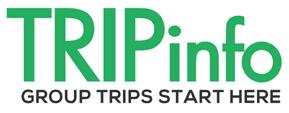


Help us thank them for their support, by first turning to those on this list for the opportunity to earn your business, whenever the need arises.


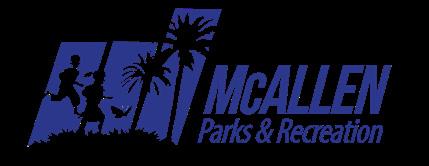




Interested in sponsoring? Contact Kaye Campbell, Director of Partnerships & Programs at (208) 433-0950 ext. 1 or kaye@ifea.com
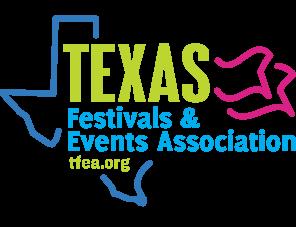
 By Susanne Tedrick
By Susanne Tedrick
For businesses across industries, cloud computing has become a necessary tool to stay operational, agile and competitive. Cloud computing works on a shared service model, which means that both the user – in this case, businesses – and cloud service providers share a certain level of responsibility to one another. Because of this shared responsibility, there are inherent advantages and potential disadvantages that need to be considered before committing to one (or several) providers.
It is important to point out that cloud computing is not an actual technology. It is more of a business concept that utilizes existing internet technologies. Also, because organizations define cloud computing differently, this article will use the National Institute of Standards and Technologies’ definition of cloud computing; the reason is that NIST is a US government agency that manages measurement standards in several areas, including technology. The NIST definition provides a unified, common understanding regardless of the provider.
Here are the factors that organizations need to consider before selecting a cloud services provider:
How will the provider charge your business for their services? Will they offer the flexibility to charge by the hour, or is a monthly commitment necessary?
• Will you be able to monitor your costs in a clear and understandable fashion?
• If you need to contest charges, do they have a clear process you can follow?
Does the provider support newer cloud service models that can minimize costs, such as serverless computing or Functions as a Service (FaaS), which only charge for what you consume?
• Effective scalability: Does the provider allow you to quickly and easily scale up and down resources when you need to? Does the provider provide the tools for you to do this on your own? Or is it
necessary to speak to a third party to spin cloud services up?
What type of reputation does the provider have? Are they known to be reliable and available? Crowd sourced review sites like G2.com can offer unbi ased opinions on cloud-based platforms and services.
Availability is crucial. Vital questions to ask include:
• How much downtime should you expect?
• In what ways does the provider try to minimize outages?
• Most important, when downtime occurs, how will they compensate you for lost time and resources?
Consider Compatibility with Your Business (Openness)
Does the provider utilize open source technologies? Would you be able to use the platform with existing applica tions, infrastructures, or technologies that you currently have?
• Conversely, would you need to perform some type of reconfiguration or…
• Start over from scratch to make what you currently have work on their platform?
• Consider whether the provider can interact with other platforms, as you may find there may be a service that you’d like to use on one platform, but not on another.
Because cloud services are largely deployed in a self-service manner, most of the major cloud service providers provide various options, from free to paid – with each comes a different level of support in terms of response time and technical assistance.
• What level of service will you need? Under free support plans, support may only be available under a “best efforts” basis, which generally means that its as technical support resources are available and have time. Paid support plans allow for guaranteed assistance within a certain time frame.
• Will it fit your price point? – Advanced and premium support plans, while
offering speedier assistance, can come with a higher price.
• Does the service provider’s customer service reps have a reputation for getting back to customers in a timely manner? Again, crowd-sourced reviews can offer some guidance on how effective and efficient a provider’s customer service reps are.
This point cannot be stressed enough –what type of security standards does the provider employ? Have they had any major data breaches in the recent past and if so, how were they addressed?
• What safeguards does the provider have to ensure your data remains safe and does not get into someone else’s hands?
• Does the service provider heavily document all the protocols, security certifications received and methods they use to keep your cloud infrastructures, applications, and data safe?
In the early days of cloud computing, certain providers claimed to own any data or intellectual property that they put on their networks, storage as theirs – and without consent and at any time. While data ownership and access usually are not problems today, it is prudent to check all specifications.
In conclusion, there are numerous factors to consider when choosing a cloud provider. Doing your homework before making a purchase is imperative for any business owner or manager.
Susanne Tedrick is a Microsoft Technical Trainer for Azure, Micro soft’s cloud computing platform. In her work, Susanne delivers skills-based, outcome driven cloud computing training to some of Microsoft’s leading enterprise clients and partners.
Susanne is the author of the critically acclaimed “Women of Color in Tech” and the upcoming “Innovating For Diversity”. For more information, please visit: www.SusanneTedrick.com
The importance of volunteers to our industry cannot be overestimated. Whether the individual acts as a volunteer administrator of an event or contributes his or her time and resources in support of a larger, multi-event organization with a paid staff, the efforts that are put forth deserve our heartiest congratulations and recognition.


It is for that reason that the IFEA Volunteer of the Year Award was created to recognize those outstanding event volunteers whose unselfish and dedicated service to a member festival or event has made a significant difference in their community and mirrors the commitment to success in our professional ranks.

The International Festivals & Events Association is pleased to announce David Williams from the City of Lago Vista / Lago Fest in Lago Vista, TX as the recipient of the 2022 IFEA Volunteer of the Year Award.

As this year’s winner, David was be the guest of the IFEA at the IFEA’s 65th Annual Convention, Expo & Retreat, presented by Haas & Wilkerson Insurance, in McAllen, Texas, USA. He was recognized and presented with his award during the IFEA Awards Luncheon on Wednesday, September 21, 2021.
David Williams has been with Lago Fest since the very first festival in 2016. That first year it was a small local event but has since grown to become the largest live music, art, and food festi val on the north shore of Lake Travis, outside of Austin, TX. Each year Dave has been a key player in the planning, development, and production of Lago Fest, and is, in fact, the only person who has worked with Lago Fest every single year.
In late 2016 after the first Lago Fest, a new City staffer was hired and given the additional role of Lago Fest Director with the mission to develop Lago Fest into a sustainable, annual event. Planning the second annual Lago Fest turned to revamping the event from a local party to a larger, branded festival with a clear mission and plan for how to restructure the festival style and format. David is well versed in the importance of brands, professionalism, sponsorships, customer experience, and most importantly, relationships! His business experience as a retired Senior Sales Executive with Coca-Cola North America has brought invaluable insight and management into our sponsorship sales and food and beverage areas of the festival.
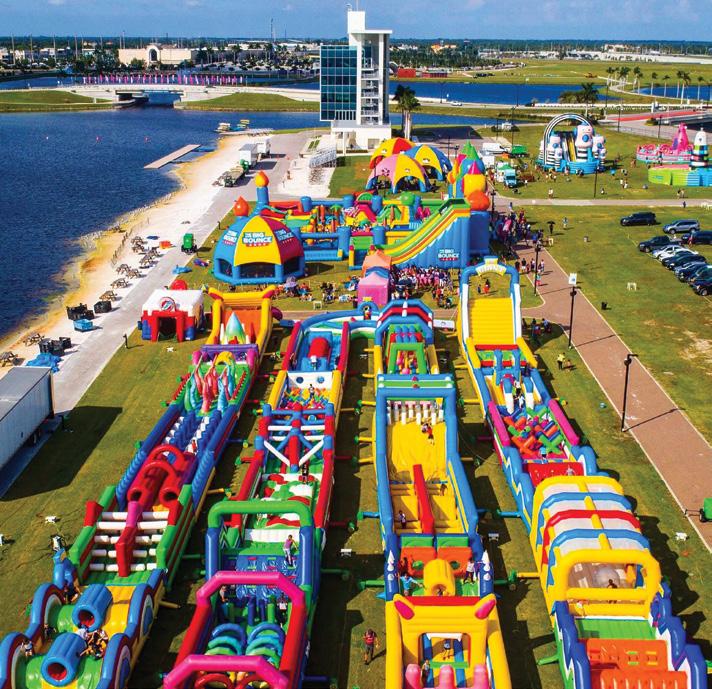
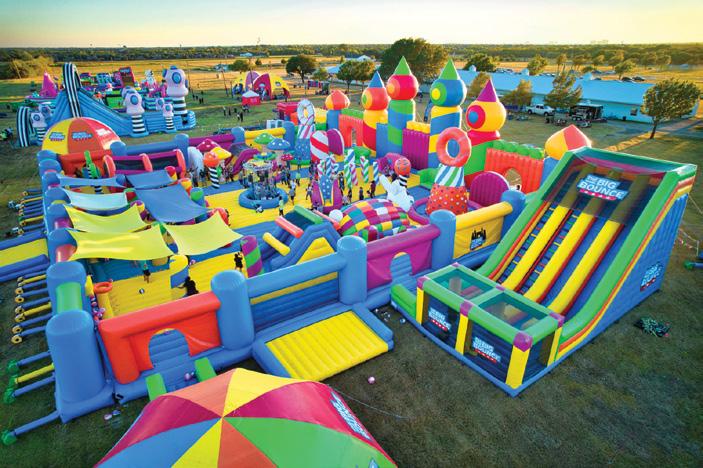


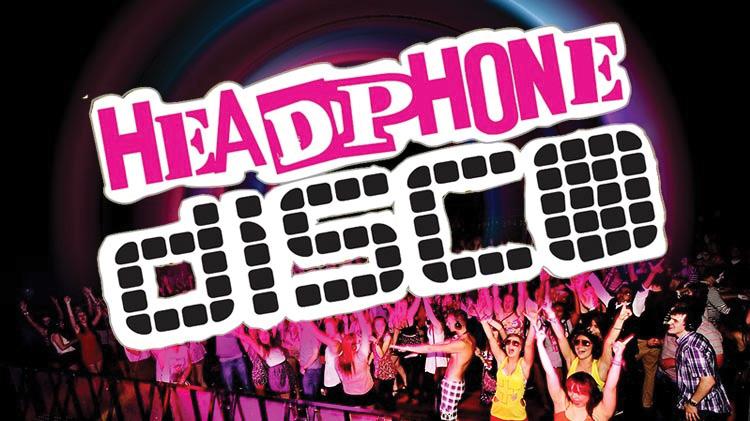
The new Lago Fest EATS concept was developed and is now managed by David. Lago Fest EATS has the best selection of local and area food trucks that David lovingly curates. He spends months personally visiting potential applicants. Not all trucks cut the mustard. But for those that show promise, David will work with them and give them tips on how to improve and encourage them to apply again. Lago Fest EATS food trucks have experienced increasing sales each year. And in 2022, despite preparing for a bigger turnout than in previous years, even sold out!

David has been instrumental in managing our Lago Fest VIP Lounge which was part of the 2017 rebranding. It allows for sponsorship perks and non-sponsorship revenue. He has worked to secure in-kind sponsorships to host the lounge with an open bar, finger foods, and even hearty meals. One of the first VIP Lounge in-kind sponsors, credits Lago Fest with their
own business success – going from a small local start-up to a nationally distributed alcohol brand.
David manages festival sponsorship sales with a level of success that has enabled the festival to grow bigger each year. And this, like everything else, he does with aplomb and personal attention. David much prefers to drive an hour to a sponsor’s place of work to give them their VIP tickets than to pop them in the mail. This is what keeps our sponsors coming back – their relationship with David!
David Williams must have more than the average person’s 24 hours in a day, because never has there been a volunteer more devoted with his time and energy to making a difference in our community. He served two terms on City Council, is on the City’s Economic Development Advisory Committee and is an active member and volunteer for countless other groups including the Lions Club, Chamber of Commerce, St. Mary’s Church, and Men’s Golf Association.
He has a proven track record of solving challenging problems, producing results, and functioning as a team leader AND player. As a self-motivated and innovative thinker, he is an absolute keystone to the operations of Lago Fest. Lago Fest and the City of Lago Vista are forever grateful to him for his enormous amount of hard work and heart. He keeps us moving, motivated, and constantly slapping our knees in laughter. He is truly one of a kind – a volunteer for all time!
Please help us congratulate our 2022 IFEA Volunteer of the Year Award Winner, David Williams.
The IFEA Volunteer of the Year Program rewards our member’s supporters who give so unselfishly of their time. Although, annually, one individual must ultimately be named Volunteer of the Year, hundreds are recognized by our member organi zations and affiliated associations as the backbone of our industry. Whether small or large, special events and festivals throughout the world consistently bring to our attention the talents of their most committed volunteers. To select one is a daunting task; to learn the stories behind their contributions has been an honor. The following outstanding volunteers were selected as Semi-Finalists in the 2022 IFEA Volunteer of the Year Awards Competition.
Phillip Ferguson is a valued spokesperson for the City of Celina, Texas and has made a positive impact on the community by volunteering at all of their events. From working many of their information booths; promoting the City of Celina’s events on his social media page, to joining the newly created Special Events Advisory Committee so he can assist with the planning and creation of events throughout the year to share his expertise and ideas, Phillip is a tremendous asset to the team.
Philip’s enthusiasm and positive attitude for promoting the City of Celina is most prominent through his extensive social media campaigns for Movie Nights on the Square. In 2021, Philip reached out to the State of Texas House of Representatives to get Celina the status of Halloween Capital of Texas. Despite many obstacles, he successfully reached this goal and the City of Celina was granted the designation Halloween Capital of North Texas from the Collin County Judge! This was added to their marketing verbiage and helped them solidify Beware! Of the Square as a Halloween destination in Texas--all thanks to Philip!
Philip has made a huge impact on many of their annual events. Having a solid volunteer like Philip is irreplaceable. Knowing they could count on him to manage their information booth or set up the movie screen makes their lives so much easier. With a small events team, volunteers really make a huge difference. With his involvement with Beware! of the Square last year they were able to make the local news with their designation and have a much bigger marketing reach. Not only does this help market their event, it also helps promote the City of Celina.
Phillip Ferguson is an essential part of the City of Celina and they would not be where they are today without him!

2021 was the 10th year anni versary of The Great India Festival (TGIF), making it a significant milestone. TGIF achievements in this challenging year would have not been possible without our volunteers both local and abroad, as they are the backbone of the festival. Ms. Roopa Sree Tungaturthi was the Vice President of Marketing at TGIF for the year 2021. Many times, one person or a small group can make a big difference, so is the case with Ms. Roopa, a one-woman army managing corporate work, family, and COVID situations, magnan imously contributed to planning, strategizing, implementation, and marketing of the festival programs.
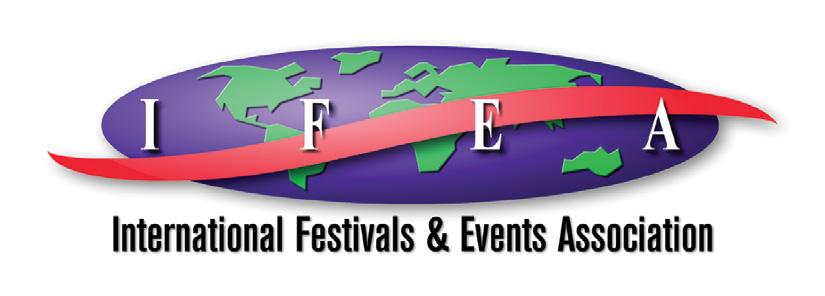
As the Vice President of Marketing, Ms. Roopa had the responsibilities to strategies, implement, promote, and bring new sponsors to the festival. 2021 was the 10th year of the festival, and Ms. Roopa voluntarily took the responsibility to plan, source, market and implement 10 different events of the festival.
Ms. Roopa’s work and dedication to the TGIF festival itself is an inspiration to the team. She motivated the team to contribute more and beyond. As a team head, she was always available to support, conduct meetings, understand roadblocks and resolve issues. She brought about digital initiatives for widespread awareness of the Ottawa festival through Facebook and Instagram networks. An outcome seen in the participation of 1500 schools world-wide in the Bharatotsav Competition.

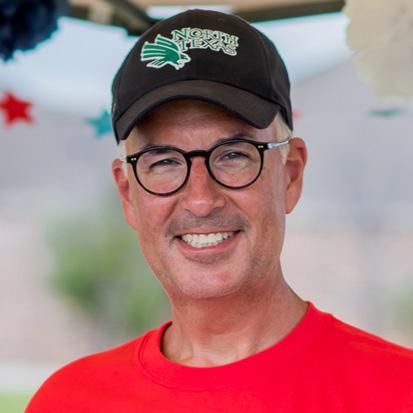
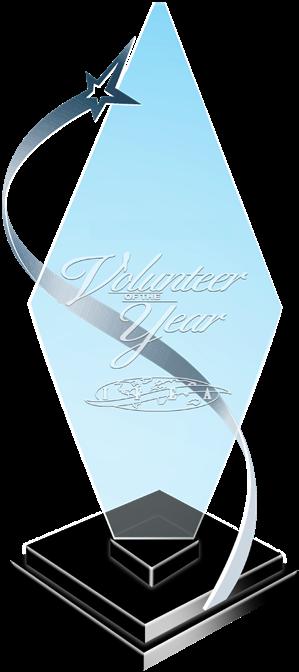
Ms. Roopa’s strong commitment and passion for her work, irre spective of time zones, ensured that students in rural India were able to submit their dance, music, paintings and cultural videos to the festival. Her tireless effort, brought belief in the team that, Pandemic or otherwise, the reach of The Great India Festival in Ottawa, Ontario, Canada, could achieve new benchmarks.
To view information on this year’s winner and past Volunteer of the Year winners, Click Here. For more information about the IFEA Volunteer of the Year Award, Click Here.
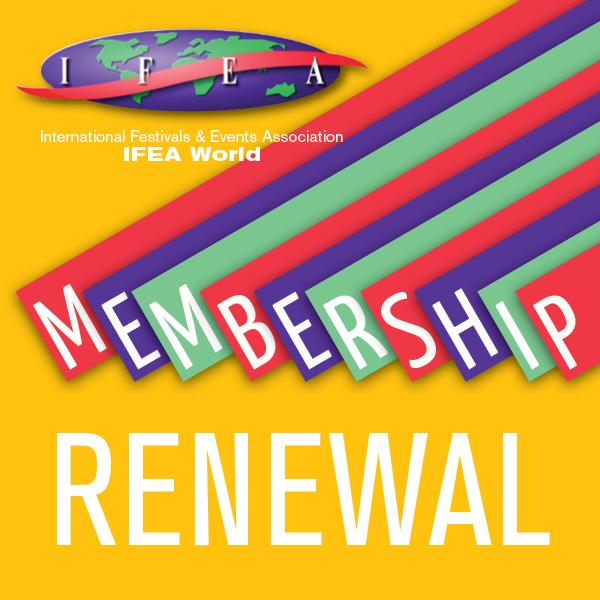


As busy leaders and business owners, you are faced with a seemingly endless list of things to do to keep your business oper ating and an ever-increasing list of ideas on how to improve your business. However, you are encouraged to throw out the hundred plus to-do items and ideas; instead, focus on the experience you deliver and start with these three fundamental steps.
The three fundamental steps are: 1 - Define the Promise; 2 - Measure the Gap(s); and 3 - Share the Stories
But before unpacking the steps to improving the experience to transform your business, let’s clarify a couple of important elements.
Firstly, the term experience, in this context means the customer experiences, the employee experiences, the experi ences that you promise, and ultimately, the ones you deliver. You may even make experience promises about your brand and products but for now, focus on Customer and Employee experiences. Also, as you will quickly understand, the singular expe rience, the transaction, is just as important as the plural, collectively experiences.
Finally, before you get to the three crucial steps to focus on, let’s be clear the customer and employee experience, does not mean hugging your haters, nor does it mean surprising your customers/ employees with champagne and caviar.
Each of these steps applies to customers and employees equally. If you don’t know where to start, start with your employees’ experiences. Investing in improving your employees’ experience will undoubtedly result in increased productivi ty and improved customer experiences.
Ok, step 1 actually comes in 2 parts and starts with defining what you mean by
the words customer/employee experience. Defining what you mean by the term(s) and ensuring every Team Member understands it, is crucial. Part 2 of step 1 is to define what you promise to deliver for your customers/employees.
Every day people check in to 2-star hotels, and fly low-cost airlines, while at the same time people are checking-in to 5-star hotels and flying first class. In both instances, there are companies that make a profit and those that don’t; the difference is clear. Some companies compete on price, and others, who win, win by delivering consistently on the experience that their ideal customers are drawn to and are willing to pay for.
So don’t be afraid of defining your promise and sharing it broadly, there are customers who will choose your company, and your promise over your competitors if you deliver on your promise consistently
But beyond prospects and customers being drawn to your promise, the superpower of defining your promise is that every Team Member will understand that above all else their priority is to deliver on the promise.
So, you’ve defined what you promise to deliver to your customers; there may be multiple promises, and now is the time to measure the gap between the promise(s) and the reality. To get started, just measure the gap between one of your promises. Your main promise.
For example, if you promise to deliver your product within 24 hours, start measuring how often you actually deliver within 24 hours. If you 100% of the time deliver within the promise, then start measuring the gap of the next promise.
However, if you aren’t delivering on your main promise, then your mission is to focus on closing the gap, every day being 1% closer to delivering on your promise.
If you are wondering where to start to measure, it is as simple as asking your customer/employee “Did we deliver on (insert your promise)?”. Then follow up by asking what was the impact of us delivering/not delivering as expected?
Companies worldwide send out surveys, and you probably will too, as you measure the gap. But don’t be one of those companies that send out surveys and then keep all the data locked up.
The power of step 3, Share the Stories, is in sharing with your team and celebrating the impact of delivering on your promise. The celebration of delivering on your promise reinforces what great looks like and the behaviours required to achieve success.
However, it is also important to share, just as broadly, the stories and the impact on customers when you fail to deliver on your promise. This not only reinforces the value of delivering on the promise, it provides a clear coaching point. An opportunity to identify, and fix, what processes, systems or tasks create the break in delivering on your promise.
By following these three steps you will build a business that has loyal raving fans, a business that continues to evolve, stays relevant and grows.
Jason S Bradshaw started his first business at the age of 14, differentiat ing himself by the service he provid ed. For the last 3 decades, he has worked with some of the world’s most recognizable brands, improving the experience to transform the business. Jason is a best-selling author and is considered a global guru on custom er experience and a leading authority on experience management. www. jasonsbradshaw.com

In a previous column (Why Innovate? To Make Money, of Course!), I wrote that in order to make money from innovation, you need to find a good problem to solve. I suggested that a good way to find such a problem is to look at some of your daily tasks and identify the ones you detest. I then suggested that if you hate doing it, then there are probably countless other people who hate it as well, which means that you have identified a problem that needs solving. And, your solution might become a million-dollar idea.
Another way to discover a million-dollar idea is when you’ve been frustrated as a customer. But, don’t take my word for it. Thomas Stemberg started several successful businesses after he was frustrated as a customer. When he couldn’t find shoes that properly fit his children’s feet, he started the Olly Shoes Fit for a Kid! company. When a dry cleaner lost one of his expensive shirts, he created the Zoots dry cleaning chain. And, when he couldn’t find a printer ribbon on a holiday weekend, he founded the STAPLES office supply store chain. Those are just three of the many business ideas Stemberg had. He once said, “I get my best ideas for starting a new business from having been frustrated as a customer.”
That quote by Stemberg is like a roadmap for finding money-making opportunities. Where have you been frustrated as a customer? Perhaps you already have a million-dollar idea lurking in the back of your mind, because you know you can do it better. Don’t just complain about it, and walk away. Go deeper, think about it, explore the possibilities, and see if you have what it takes to create a new business.
Here’s another scenario to ponder: How is your competition frustrating their customers? If you can find that out, and improve upon it, then you can take their customers away.
While you’re at it ask yourself: How am I frustrating my customers? Ask them, they’ll happily tell you. Then you can fix it; keep your current customers satisfied; and earn some new ones with your improved product or service. That’s why so many companies run customer-satisfaction surveys, so they can solve problems that might be costing them money.
A great example of someone who was frustrated as a customer and started a business because of it is Rico Elmore. Rico is a
big guy: he is six foot, three inches tall, and weighs 300 pounds. When he got married, he and his wife went to Las Vegas for their honeymoon. While there, he misplaced his sunglasses. No problem, he thought, I’ll just buy a new pair. But, when he went shopping he couldn’t find a single pair that fit his large head. He went to several stores before giving up. There simply were no sunglasses available in his size.
Frustrated, Elmore decided that when he got back home to Indiana, he would have several pairs of sunglasses custom made to fit his head. He was determined to never have this problem again. He’d keep several pairs on hand, so he’d always have a backup if one pair were broken or lost. Then while he was doing his research on getting custom sunglasses manufactured, it occurred to him that he couldn’t be the only person with this problem. So, instead of only making a few pairs for himself, Rico decided to start a company that specialized in making sunglasses for people with big heads.
It took him a couple of years to figure it all out, but in late 2005 he launched his new company Fatheadz eyewear. By 2010 he had landed Walmart as an account and hit $2 million in sales. The company has been growing ever since.
As you go through your life’s activities keep your eyes open, or better yet your feelings. When you find yourself feeling irritated, annoyed, or frustrated, look a little closer and ask, “Can I do this better? Can I improve this situation? Is there a business opportunity here?” Then maybe you can make the world a better place, by coming up with a million-dollar idea!
Robert Evans Wilson, Jr. is an innovation/change speaker, author, and consultant.He works with companies that want to be more competitive through innovation and with people who want to think more creatively. Robert is the author of ...and Never Coming Back, a psychological thriller-novel about a motion picture director; The Annoying Ghost Kid, a humorous children’s book about dealing with a bully; and the inspirational book: Wisdom in the Weirdest Places. For more information on Robert, please visit www.jumpstartyourmeeting.com.
Let frustration be your guide for finding money-making ideas.

There are people in this industry who will tell you that sponsorship is all about relationships, and that building personal relationships with sponsors is the key to sales, renewals, and fruitful partnerships. While I’m not averse to developing friendships with sponsors, I’m not a fan of this take at all.
First off, it creates the false impression that well-connected industry pros and networking animals are the only ones who are successful, when nothing could be further from the truth. It also de-emphasis es the most important facets of developing and extending a sponsorship.
I’m not for a second saying that you shouldn’t do everything you can to develop a relationship with your sponsors, but it’s not about being pals and having beers together; it’s about demonstrating that yours is exactly the smart, insightful, trust worthy, responsive, and creative type of organisation they want to be working with.
So, here’s my advice for developing a real sponsor relationship – one that transcends the individuals involved – and why that’s absolutely key, whether you’re a long-time pro or not.
This is absolutely the starting point for sponsor relationships. If you don’t have this understanding, you can be as chummy as you like, but the relationship isn’t working. It’s like marrying someone
without knowing their middle name or birthday. It’s that basic.
Before you ever reach out to a potential sponsor, you need to do the legwork. Review their social, their website, and their ads to pinpoint how they’re marketing the brand, what aspects of the brand are focal points, and who they’re targeting – what kinds of people.
Bring this understanding into any discussions with them, and if you need clarification, just ask. If you can demon strate you’ve done your homework, they’ll usually be happy to fill in any gaps.
If you’ve got existing sponsors, ask your self how much do you really know about what they’re trying to accomplish and with whom? You may think they’re trying to align with your property or get exposure, but things like that are mechanisms, not objectives. Objectives are about changing or reinforcing people’s perceptions, changing or reinforcing their behaviours, and aligning with target markets.

For those existing sponsors, you need to do the homework, then have a meeting with them to understand exactly what they’re trying to achieve, and you need to do it now.
In addition to their objectives, there may be environmental or industry factors that they’re dealing with. You can literally do a search on [industry] challenges, and start to get a pretty good idea. You can then
include that in your discussions around objectives, saying something like, “With a shift to digital-first in banking, and some digital-only banks, is your focal point shifting at all? Or is the high quality of your locally-based customer service experience something you’re leaning into?”
If you ask something like that, you sound smart. You sound like you’re really trying to understand their business in the context of their industry and competition, and you’re likely to get a thoughtful answer that could play a part in your offer or renewal.
Sponsorship is a powerful and critically important tool for brands. It gives them a degree of personal relevance and meaning that no other marketing media has. Your property could be the perfect conduit through which they can demonstrate who they are and what they’re about, add value to their target markets, align with those markets, and imbue all of their marketing channels with passion and relevance.
You’re not looking for a handout. You’re a sophisticated peer with a valuable, meaningful platform from which they can achieve their objectives. This assumes, of course, that you’re not just sending out proposals willy-nilly, and you’re actually targeting well-matched brands. But if you’re selective in who you approach, and can make a strategic business case, then you’re a peer. Act like it.
If
don’t under-
a hero. You can even ask them about their KPIs, their challenges. You never know, you may be able to supply some data or insights or something else that will assist.
Following on from making your contacts the heroes is this extremely important point…
You may be a dead-set legend at festivals or professional associations or concert tours, but if you want to position your organisation as a brand ally and resource, you also need to speak the language of brand marketing.
You need to be across at least the basics, such as…
• Cost of acquisition
• Churn
• Customer lifetime value
• Incremental sales
• Upselling, cross-selling
• Share of wallet
• Call-to-action (CTA)
• Brand tracking
• Brand positioning, brand architecture
• Purpose
• ESG
• Personas/flagbearers
• Net Promoter Score
• Qualified prospect
• Conversion
• Sales funnel
That’s really just the tip of the iceberg, and different categories of business have many of their own terms, but if you at least under stand these, you’ll look like you’ve gone through some effort to speak their language, which is more than most rightsholders do.
If you’re speaking with a sponsor, and they throw out a term you don’t understand, just ask for clarification. If you’re hit with a term in an email or other report, google it. And if you’re pitching to a major sponsor, one of the smartest things you can do is dive into a couple of industry association or media websites, just to get a handle on some of the key industry issues, trends, and terms.
Make Their Internal Sell Easy
Smart sponsors integrate sponsorships across many departments and channels. As such, your contact may need to socialise the proposal and get buy-in across many departments. They may even work with those stakeholders on a draft leverage plan – which is always my recommendation – before they start negotiations with you.
What they need from you is to make that process easy. They need a well-structured proposal that lays out a comprehensive business case for why the sponsorship makes sense for them, including creative ideas for how they can leverage it to meet multiple brand and company objectives. They need all of the information in that proposal to assess the opportunity, ideally do a draft leverage plan, and get internal agreement to negotiate.
The thing is, that’s not a deck. You can present a deck to your contact, but they need more detail than you can fit into a deck for their internal sale to people who weren’t in the room. Just get over that boo-hoo-MS-word-isn’t-pretty thing right now. They’d much rather have a complete proposal than a super-pretty one.
For more on proposals, and making the internal sell easy, here are some resources:
• Sponsorship Proposal Basics in About 15 Minutes
• The Sponsorship Seeker’s Toolkit 4th Edition (includes a proposal template)
• Getting to “Yes” – Comprehensive online training, with a lot of instructions and advice for offer development, proposals, and more
• You can find information on all of these at PowerSponsorship.com.
As with any kind of sale, you want to be dealing with the financial decision-maker. As noted above, however, there are prob ably a lot of decision influencers, as well. And if you do sell the sponsorship, there’s every chance you’ll be working with some one more junior on the actual delivery.
Don’t disrespect these people. Don’t ignore them. Don’t go over their heads. If there’s an issue that needs sorting, discuss it with them and take the issue up the chain together, if required. There are very few exceptions to this.
Instead, do your very best to make everyone you work with – from the decision-maker to the implementer – into
The marketing function has by far the highest annual turnover of any corporate job category, at around 17% per annum. This means that for your average threeyear contract, the person who signed off the first time, and the people you worked with to deliver the sponsorship, may very well not be there at renewal time.
My very strong advice is that, rather than adding value to your personal relationships, you spend your time, effort, and servicing budget on adding value to the sponsorship. Provide some added-value benefits, do sponsor education or networking events, do a slate of research that incorporates your key sponsors, facilitate sponsor cross-promotions. All of those things add value. All of them help the sponsor get a better result from the sponsorship. And all of these value-adds are relevant and defensible no matter who’s making or influencing decisions at renewal time.
Through all of this, I’m not saying you can’t be friends with a sponsor – that you can’t have lunch or invite them to a skybox or whatever. That’s absolutely fine.
What I am saying is that building a sustainable relationship between your organ isation and theirs goes way, way beyond that. Do the things on this list, and watch those relationships change for the better.
Kim Skildum-Reid, is one of the sponsorship industry’s most influential thought leaders. She has a blue-chip list of consulting and training clients spanning six continents, is author of global industry bestsellers, The Sponsorship Seeker’s Toolkit and The Corporate Sponsorship Toolkit, and commentates to major business media around the world. She is the brains be hind industry hub, PowerSponsorship. com, and offers sponsorship consult ing, training, speaking, and coaching.
|

This does not work for those who are carrying medication, syringes, adult diapers, and other private medical supplies. To protect privacy, events must allow patrons with medical conditions to bring in an opaque bag of whatever size is needed to hold their medically necessary supplies. Insulin must be kept at a stable temperature so patrons must be allowed to bring a small soft-sided cooler, thermos, or other way to keep meds safe.
I asked Jaime if we could have a conversation about what attend ing an event is like for her, as a person with diabetes, and share it with you, the reader. Although Jaime is a private person, she agreed.
Why is this an important and relevant topic to event staff and producers? According to the National Institute of Diabetes and Digestive and Kidney Diseases (a department within the U.S. Department of Health and Human Services), 26.9 million people have been diagnosed with diabetes (8.2 percent of the US population). That is a lot of people! Festival producers must assume that many of the people attending their event have diabetes. I think you will find Jaime’s experiences very helpful.
Laura: Hi Jaime, thank you for being willing to be so open about a very personal part of your life.
I recently had the pleasure of reconnecting with Jaime Smilowitz when she called me to discuss an event accessibility issue she was dealing with. We first met 10 years ago when Jaime volunteered to serve on the Access Team for an event I was working. She reached out to me because she knows that my company, Everyone’s Invited, works with producers to help make their events more accessible to people with disabilities.
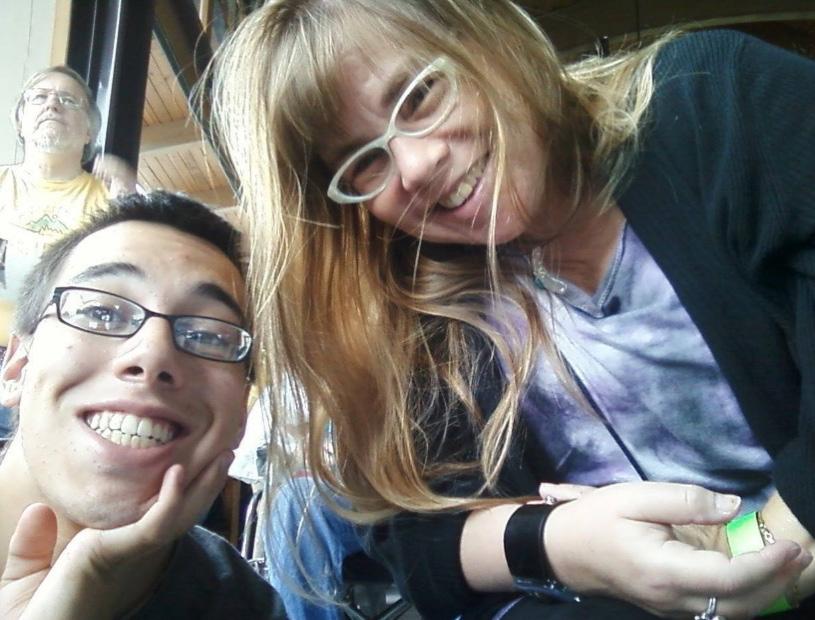
Jaime has insulin-dependent diabetes, otherwise known as type 1, and she wanted to know more about her legal rights under the Americans with Disabilities Act (ADA). She had contacted event staff in advance of attending an event to let them know she would be bringing medically necessary supplies, food, and beverages into the venue. At first, they said no, she could not bring in most of the items she listed.
After putting on her self-advocate warrior hat, Jaime demanded that the event management allow her to bring the life-saving medical supplies she needed. It was an upsetting experience and she wanted to be better prepared for next time.
The ADA requires that events, and other places open to the public, modify their policies and procedures so they do not discriminate against persons with disabilities. I advised Jaime that she should be allowed to bring whatever she needs to manage her medical condition. I also explained that security teams have become more exacting with their restrictions in recent years as they are trying to protect patrons and staff from illicit drugs and weapons. Bag policies often specify clear, plastic backpacks and very small opaque bags inside the backpacks.
Jaime: You’re welcome. If my experience can help others, I am happy to share.
Laura: Tell us a little about your daily life and how you manage your diabetes.
Jaime: It’s a complicated answer. It is a minute by minute, hour by hour, day by day, every single day of my life, disease. No two days are the same. I must keep my blood sugars in a certain range (the desired range fluctuates during the day), and I monitor my blood sugars through my continuous glucose monitor (CGM). I wear it on one arm or the other. The CGM tests my blood sugar through a thin metal filament inserted under my skin that is testing the interstitial fluid in my body. I get a reading every five minutes. That, in combination with my insulin pump (also attached to my body), dietary adjustments, and activity considerations assists me in managing my diabetes throughout the day. My CGM sounds an alarm when my blood sugar is changing out of the acceptable range.
Diabetes effects each person differently. No two persons with the disease will be experiencing or treating their disease in the same way. It is a complex disease with needs that change constantly and change under different circumstances. There is no broad brush to explain what people with diabetes need.
If someone reaches out to you to say what they need, believe them.
Laura: What are some of the symptoms when a person is experiencing a diabetic issue?
Jaime Smilowitz with her son, Alexzander Ellenbogen, in 2013 at the Richie Ha vens Memorial Celebration in Bethel Woods, NY (site of the original Woodstock). Photo by Alexzander Ellenbogen.Jaime: There is no standard answer. Each person’s symptoms are different and may vary from high blood sugar issues to low sugar issues. It is a constant juggle to get the balance right to keep in range. Literature states these symptoms include confusion, irritability, shakiness, sweating, double vision, slurred speech, seizures, loss of consciousness, and death. I experience ocular changes, tingling and numbness in my legs, confusion, spaciness, giddiness, difficulty regulating body temperature, and garbled speech. Because symptoms can imitate a drunk person’s behavior, I used to carry a card issued by the American Diabetes Association (ADA), that said “I have diabetes I am not drunk.”

Laura: Let’s talk about how having diabetes makes it difficult to attend festivals and other events. What is the first thing you do when you are considering attending an event?
Jaime: I go online and find out how much it costs, where the venue is, and determine whether I have been there before. If I have, I will know what department or person to call. If not, I begin the process of figuring out who to contact.
I reach out to the venue to find out what the procedure is to come in with the things I need. If it is an all-day event I need to prepare more and bring more. I need to consider the location and proximity to my home and that may add to the list of things I need to bring.
Laura: Please share some of the responses you have gotten when you have reached out to events.
Jaime: In my most recent encounter I was met with tremendous resistance to assist me. I was very clear with my needs down to the type of drink and the number of drinks I needed to bring in because I would rather be prepared then have a medical emergency.
I was told I couldn’t bring anything in and “Don’t argue about the rules with me.” I was asked, “What is your disability that you
need accommodations for?” I told her she needed sensitivity training when dealing with patrons with accessibility needs and I asked to speak to a supervisor.
The supervisor got back to me and told me what I was allowed to bring in. I was allowed to bring in one 16-ounce container of juice. “If your blood sugar goes high or low you can have the juice.”
I cannot drink juice! You are not a medical professional, and you can’t tell me what I’m allowed to bring in. I’m telling you what I need!
Laura: How did you resolve this issue?
Jaime: We went back and forth. They said you can have one drink. I said “No, I need to bring in more than one drink.” That same person said to me “We have EMTs there should you have a medical emergency.” As if that was supposed to comfort me. You want me to have a medical emergency in order to have my needs met?! I am trying to prevent having a medical emergency!
I was also told I could buy food. This is an unacceptable answer because I need to treat myself immediately and not have to walk a distance and then stand in line to get the food. Speedy intervention is key to averting a medical emergency.
In a past experience, I was not able to get food in a timely fashion. This is why I now prepare so well. It is absolutely frighten ing when I know that I cannot easily assist myself.
Laura: That sounds like a distressing experience. Please help educate us. What kinds of things do you need to bring, assuming this is a day-long event? Let’s begin with the food and beverage items you would need to bring.
Jaime: Multiple bottles of water, multiple bottles of sweetened iced tea, food that is easy to transport, has carbs, and is small. For example, peanut butter and jelly sandwiches, granola bars, cheese crackers, saltines, hard candies; things that won’t melt
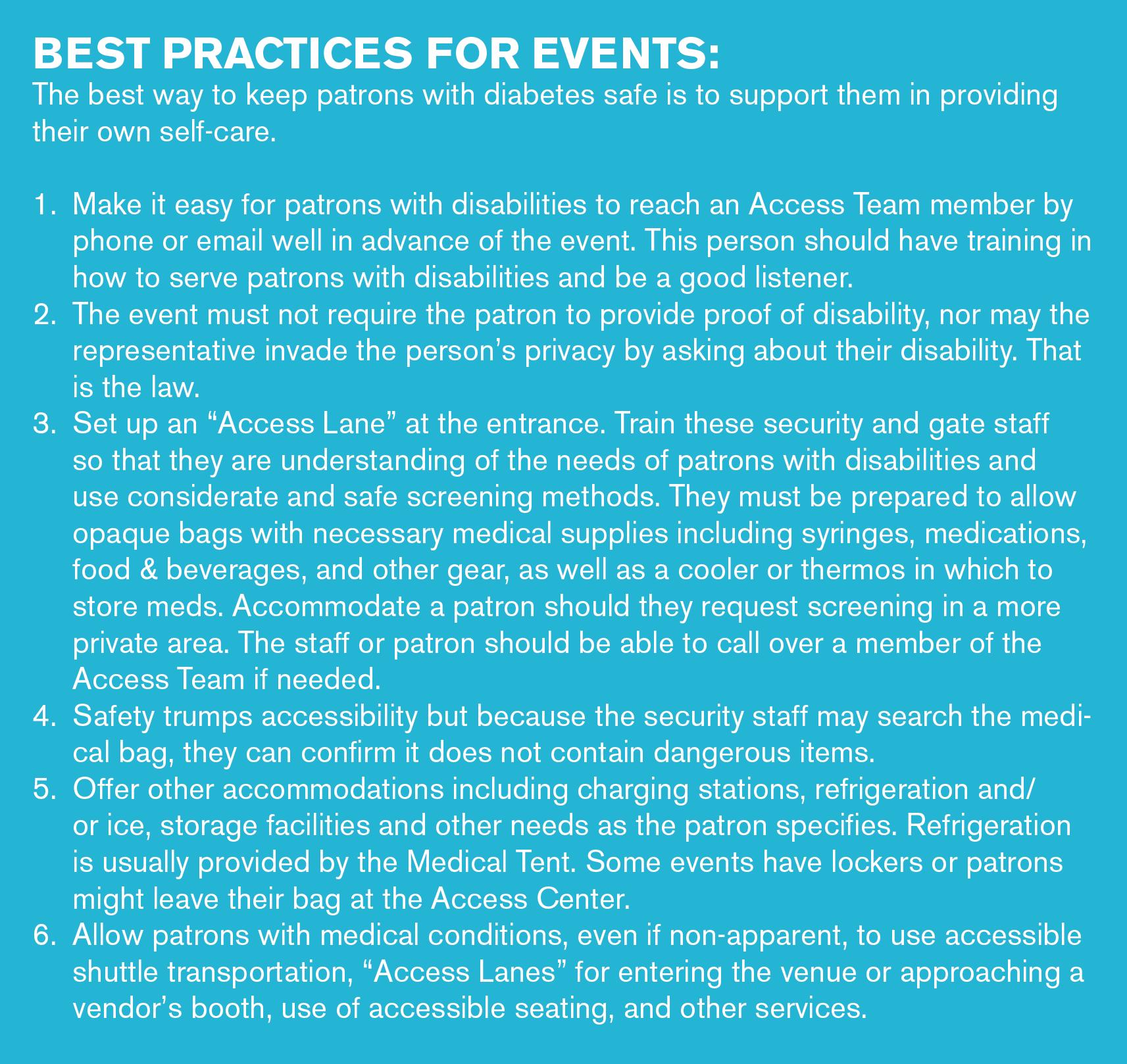
The best way to keep patrons with diabetes safe is to support them in providing their own self-care.
1. Make it easy for patrons with disabilities to reach an Access Team member by phone or email well in advance of the event. This person should have training in how to serve patrons with disabilities and be a good listener.
2. The event must not require the patron to provide proof of disability, nor may the representative invade the person’s privacy by asking about their disability. That is the law.
3. Set up an “Access Lane” at the entrance. Train these security and gate staff so that they are understanding of the needs of patrons with disabilities and use considerate and safe screening methods. They must be prepared to allow opaque bags with necessary medical supplies including syringes, medications, food & beverages, and other gear, as well as a cooler or thermos in which to store meds. Accommodate a patron should they request screening in a more private area. The staff or patron should be able to call over a member of the Access Team if needed.
4. Safety trumps accessibility but because the security staff may search the medi cal bag, they can confirm it does not contain dangerous items.
5. Offer other accommodations including charging stations, refrigeration and/ or ice, storage facilities and other needs as the patron specifies. Refrigeration is usually provided by the Medical Tent. Some events have lockers or patrons might leave their bag at the Access Center.
6. Allow patrons with medical conditions, even if non-apparent, to use accessible shuttle transportation, “Access Lanes” for entering the venue or approaching a vendor’s booth, use of accessible seating, and other services.
and will survive temperature extremes. I have side-effects from my diabetes so it has to be food that I can tolerate. Other people will have other food requirements.
Laura: What types of medical supplies do you need to bring?
Jaime: I assume everything that I have is going to fail so I bring back-up pump supplies which includes tubing, insertion device, alcohol swabs, insulin, reservoirs, needles and syringes. I bring additional CGM supplies. I also have to assume my pump is going to fail. If my pump fails, I have to go old school and I have to go back to syringes and glucose testing. If I don’t administer insulin very quickly, the sh*t can hit the fan.
Laura: When you say “the sh*t can hit the fan,” what do you mean? How serious is this?
Jaime: Blood sugar can go high very quickly. It is different for different individuals but for some it can go dangerously high in as little as half an hour. When blood sugar is dangerously high one can have a stroke and one can die. One can go into keto acidosis which can lead to death. The opposite situation can also occur, where blood sugar is dangerously low. One could experience unconsciousness, seizures, and death.
Laura: What is it like for you when you go through securi ty screening?
Jaime: Because the insulin pump is a small computer, it cannot go through x-ray or magnetic forces. When asked to pass through metal detectors, I will refuse and ask for alternate screening methods like a pat down or hand wand.
The more experiences I have in different screening situations the more I learn. I get screened at airports, state and federal
buildings, and events. What I have noticed is the way in which they search my carefully thought and packed belongings. Sometimes it is searched by hand, either roughly or carefully, and sometimes there is a wand of some sort used to move the items around. The wand method has begun to bother me. I want to be in control of my things. I don’t know where those wands have been and what they have been in contact with. My medical supplies and ingestible items keep me alive. I don’t want to risk my supplies being damaged, or my food being contaminated. I am not a germaphobe, but I am aware.
Here is an example of a screening process gone awry. I was flying and had a special TSA screening scheduled. I told the person, “Do not stroke up my arm. Instead, pat gently”. She did not listen and ripped the CGM out of my arm. I was very angry for multiple reasons. First, she didn’t listen, second, I wasn’t even an hour into my trip, and I already had to resort to my backup supplies and test my blood sugar manually. It takes 2 hours for the CGM to warm up, so it was a minimum of that long to be up and running again.
Laura: What an upsetting experience! While most Security Team members do an excellent job, I’ve heard stories of security taking away medications or medical devices or making the patron talk about their medical condition in front of other people. It can be a frightening experience to go through the search process and interact with security unless they are well-trained and understanding.
Tell us more about other accommodations you might need when attending an event.
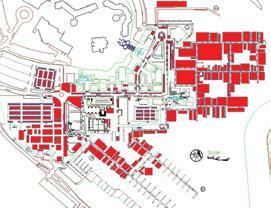
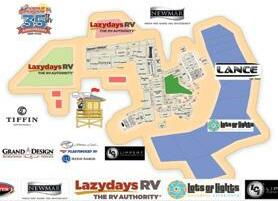



Jaime: Here is a list of things I have used and need for my care (it is not an exhaustive list):




1. Because over-exertion can affect my blood sugar levels, it is risky to walk long distances or stand for a long time. I’ll need close parking or transportation to the entrance, expedited entry, a place to sit for viewing the performance, and access to food vendors without standing in a long line should I want to purchase food.
2. Permission to bring my supplies in an opaque bag that works for me. This might be a rolling suitcase, backpack, or multi-compartment bag. Of course, security may carefully search my bag. I would feel more comfortable if I could handle the medical gear myself during the screening, rather than Security touching my supplies.
3. Access to power to charge my phone and my insulin pump.
4. Use of space in a refrigerator or ice for my cooler so I can keep my medication cool.
5. Secure and easily accessible place to store my items so I do not have to carry them around.

6. A clean, private, place to administer medication and change medical devices.

7. The option to get under a tent and be out of direct sunlight.
8. Information about the emergency protocol so I know what to do in an emergency.
Laura: Jaime, thank you for taking the time to speak with me and give such detailed and excellent advice. Many event producers will learn a lot from you.
Jaime: It is my pleasure, Laura. I believe that knowledge is power. I am happy to speak of my private challenges if it can help another person, but also help those that are helping them. I get that producers are concerned with firearms, drugs, and alcohol
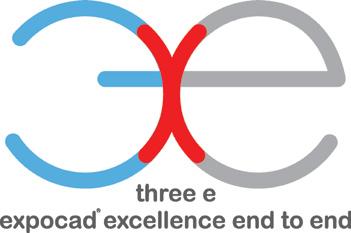
coming into their event, but think about it - would I bring attention to myself if I was bringing in any of that?
I have had this disease for almost 50 years and a lesson I learned early on is how to advocate for myself. I know what I need, please listen to those needs, and don’t dictate rules that impede my ability to enjoy an event. Make the process as easy as possible for me, not difficult and stressful. It is challenging enough to deal with the daily decisions and adjustments I need to make to live a long healthy life. I don’t need to be harassed when advocating for myself.
Thanks for talking to me. I am hopeful that this will give a little insight to all festival producers. If you would like to talk further, let Laura know and she will make the connection. CARPE DIEM!
National Institute of Diabetes and Digestive and Kidney Diseases: https://www.niddk.nih.gov/health-information/health-statistics/ diabetes-statistics
Everyone’s Invited, LLC, founded by Laura Grunfeld, is winner of the gold level “Best Accessibility Program,” for the 2018, 2019, and 2022 IFEA/Haas & Wilkerson Pinnacle Awards. Laura writes a regular column helping producers make their events accessible to people with disabilities. She has worked many festivals across the nation and readers can learn more about her event accessibility consulting, training, and production company att www.EveryonesInvited.com and www.linkedin.com/in/lauragrunfeld. Suggest topics or ask questions by writing to Laura@EveryonesInvited.com © Laura Grunfeld, Everyone’s Invited, LLC, October 2022.

It’s no secret that the staffing shortages facing most businesses today are extremely challenging. It is also highly unlikely that these challenges are going to resolve in the near term. So, what do you do now when you just cannot find the talent you need? It is time to rethink all of your staffing options. The key is to make the most of the staff you have and to augment them with outside resources and technology.
The foundation of business success is based upon your revenue and the stability of your revenue streams. Customer loyalty and retention depends on their satis faction. Prospects rely on their ability to access the information they need to make informed decisions and gain a comfort level with their options. Organizations with a history of sales success often rely on operational delivery to keep them going when they are short staffed. Yet it is your customer facing staff who are the most valuable to sustaining enterprise revenue.
Identify staff who interact with your customers along the entire range of their customer journey. Their success in meeting customer needs, satisfaction and prospect demands determine if you can satisfy and keep them. If they have the bandwidth to provide exceptional service, they can keep your customers and expand your prospect pool.
Today’s consumers are looking for faster information. Many prefer to get information via video or audio. Adjust to how they want to consume information. Streamline your team’s workload by creating tools and resources to quickly get them the answers they want and need. Ensure they have the tools and resources they need to be more efficient. Clarify what can help them deliver a better customer experience. Remove the roadblocks to their success.
The gig economy is here to stay. Leveraging external relationships with outsourced resources can help you flex your staffing and can be a valuable way to get the work done. While not as optimal as building your own team, the pressure relief you experience when critical work is being completed can give you the breathing room needed to determine if this role really needs a full-time hire or if it can be permanently outsourced.
For small projects, online resources like Fiverr and Upwork provide you with worldwide access to Gig Workers with
specific skills that are needed for short duration work. Most of these online sites have filters allowing you to; clarify what service you need; review pricing informa tion; control where your talent comes from and what languages they speak.
Staffing Agencies can bring in talent to your organization for a project that is going to take a bit longer. While it will be more expensive, keep in mind, you are not paying any benefits and you will not get hit with an unemployment claim when you no longer need them. Agencies vet the staff who work with you and will help you find the right talent you need.
Trusted Outside Vendors can provide key services for you and do bookkeeping, administrative work, sales support, social media, website management, etc. Longterm vendors have deep insight about your history, your team, and your culture. They know your preferred communication methods and how you like to work. Outside vendors are an exceptionally valuable safety valve when you cannot find the right permanent talent.
Do not try to manage too many different outside resources. Focus on the most critical work they can provide for you and engage in short-duration tests to see if you have chemistry and if they provide you with value.
3. Consider the Potential of Technology Technology and automation use is exploding as companies are seeking opportunities to invest in devices and software to provide options to leverage the staff they already have and enhance their productivity. Autonomous devices include robots, drones, vehicles, floor cleaners and more. These devices can sense the environment around them and operate without human involvement. Other devices such as exoskeletons are able to support a worker’s body and provide augmented biological capabilities such as safely lifting heavy objects.
While robotics as a field is advancing, they are not truly autonomous of human interaction. They still need people involved in the process to use them. This includes programming, monitoring them and changing batteries as they perform their service. At best this is now “co-botics” and people will never be fully eliminated from the equation and they will work in tandem. As these options expand, you can take advantage of them too, even if you are a small business.
There is growing interest in how data and analytics can be used to manage staff
productivity and service delivery. Most technology devices are already collecting data. When combined in the future with artificial intelligence, the possibilities for data analytics appear to be endless. When the data is combined with AI interpretation, this can provide valuable insight to help streamline your processes and maximize staff efficiency.
Evaluate how you are using the software and technology currently deployed in your business to see how you can maximize their value. The return on the investment (ROI) should be very carefully evaluated to identify any efficiencies achieved or productivity enhancements. Get your team any needed training so they can effectively work with advanced technologies. You might need a different skillset in your workforce to work with the technology and this may expand your workforce to pull from a broader pool of potential talent.
It is clear that the staffing shortages are not going away. We have to find opportunities to gain increased produc tivity from our existing workforce and alternatives for completing the work we need done. Focusing on the needs of our customer-facing team members, making smart use of outside resources and maximizing technology use provides viable options for addressing the issue. When you expand your potential for getting the job done, you are more likely to find the resources you need.
Jill J. Johnson, MBA, President and Founder of Johnson Consulting Ser vices, is a management consultant, accomplished speaker, award-winning author, and Business Hall of Fame inductee. She helps clients make crit ical business decisions and develop plans for turnarounds or growth. Her consulting work has impacted over $4 billion worth of decisions. She has a proven track record of dealing with complex business issues and getting results. For more information, visit www.jcs-usa.com
Social Media Links:
LinkedIn: www.linkedin.com/in/JillJohn sonUSA/
Facebook: www.facebook.com/Johnson ConsultingServices
Instagram: https:/www.instagram.com/ JillJohnsonUSA
Twitter: twitter.com/JillJohnsonUSA
Clubhouse: @JillJohnsonUSA
This topic is heavily on my mind. How to best recruit the next generation of volunteers for several big events and venue development?
The future of our events and community vitality are dependent on engaging the energy and imaginations of our youth. While pondering my situation, I looked for definitions that might motivate better results.

NextGen means “The step forward that perpetually propels us into our impending destiny.”
We all need the next generation to engage in our community. We would like to find promising young high school students, college co-eds and recent graduates to join our corps of volunteers.
But … there are always buts.
• Experienced and responsible adult oversight is needed.
• Parental permission and waivers may be required.
• Developing appropriate projects and assignments.
• Tasks often must be specially created and managed.

• Encouraging multiple participation points beyond the first experience.
• And of course, the challenges of communicating with younger generations.
We are aware of the challenges but we want youth involve ments. Our organization has a new garden venue for an Earth Day event and want to ensure our youth feel ownership in the event and new site. Our staff recently did a needs assessment and then asked my events team how we could engage youth with each component. We didn’t want to be dependent on youth but need to ensure there are opportunities for participation every step of the way. Here is what happened:
1. Need to Gather Community Input and Develop a Garden Concept

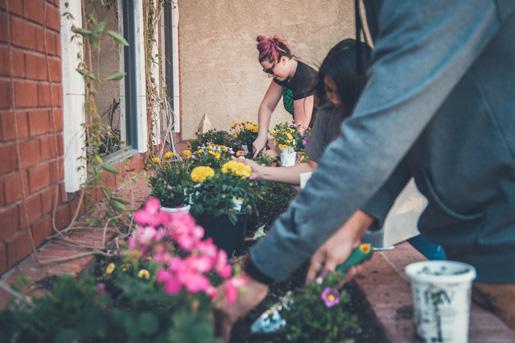
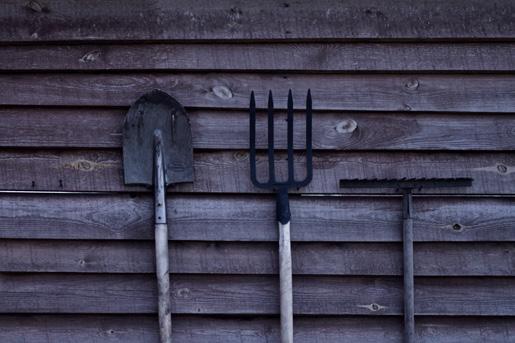
Our commitment to engaging youth started with the Landscaping Department at Ball State University. They helped gather input from the community on the garden and public gathering infrastructure. Then one class of 5 student teams developed potential concepts for public reaction and recommendations. A final concept was submitted to garden committee this summer and it has now gone to the professional engineering team. I should note the concepts were so well done that our board thought they had been created by seasoned professionals.
2.
We identified a good-sized brick enclosure on the ground that had previously been the garbage collection site. The doors are falling off and there is no roof. It is an eye sore right at the venue entrance. Could this be an Eagle Scout project? We reached out to three local scout troops in the spring. And fortunately, an Eagle Scout candidate with a knowledgeable troop leader stepped up with a garden shed design and a GoFund me page. Construction starts next weekend on this reuse project!
The local high school has an Honors Art Club and they stepped forward with a beautiful design concept to be painted on the brick siding of the garden shed. The shed location is right on the edge of the parking lot. Painting will commence with warm weather in the spring. We also got a bonus option. The High School Craft Shop is interested in creating metal leaves and accent pieces for the mural.
We are often looking for student volunteers for project, event and ongoing partici pation. The National Honor Society, Community Service, 4H and FFA high school clubs have all provided volunteers for a variety of activities. We work with the club teacher sponsors to ensure proper communication and supervision. Over the summer we found a teacher who was truly engaged. He helped expand the number of students participating by reaching out to other teachers to grow the program. We even got a joint grant working with our local community foundation.
Start with someone you know. A teacher. A student. Coaches. Club Mentors. Scout Leaders. Get their ideas and feedback on ideas. And start early. Our most successful partnerships started with 8+ months of lead time. A few ideas:
• High School National Honor Society
• National Junior Honor Society
• Key Clubs (and other service clubs)
• Art Clubs
• Performance Groups
• Sports Boosters
• Scouts (don’t forget Eagle Scouts!)
• Student Council
• Local University Programs
Each of our student engage ments took a different approach. The projects were all successful because they were well defined and engaged students through their passions. However, at some points we had to adjust expectations and supplement skills and experience.
Consider these elements:
• Will the project be Youth-led, Youth-Adult Partnership or Adult-led?
• Are youth included on event committees?
• Have you explained the goals and talk about how the outcomes can impact in the community? Are expecta tions clear?
• Do you have a plan to make the activity fun? Will there be music, food and an entertaining environment?
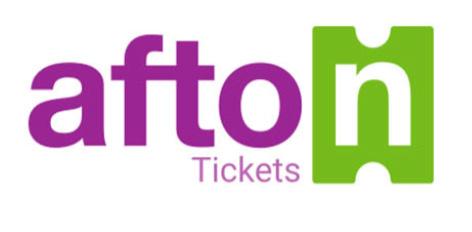



• Will your event team encourage and recognize the accom plishments of the youth?
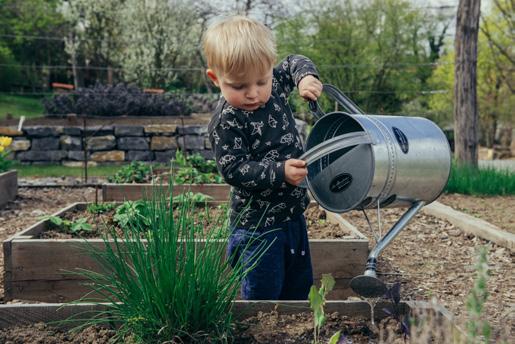
If possible, link the activity to a passion the person already has developed. Try showing young people how something they love can be turned into a valuable volunteer opportunity.
One of our high school volunteers, an agriculture enthusiast, started with us two years ago during COVID. She worked incredibly hard to help start and ultimately managed our Community Garden. She took a six month break but when she saw all the new projects, told me she felt renewed excitement for the program and excited to see people her age fully engaged.
Even routine tasks like stuffing envelopes or directing traffic can be rewarding when you know it’s helping further something you care deeply about. Young people often don’t understand what opportunities exist and where they can go to find something that piques their interest.
Our job is to help open those doors.
Florence May is the Founder and President of TRS Volun teer Solutions. Her company provides myTRS Software for hundreds of Festivals, Conventions, Non-Profits, corporations and Sports Commissions. Among these support for 26 Final Fours, 5 Super Bowls, 2 Republican National Conventions, 2 Democratic National Conventions, 18 F1 Races, 12 Special Olympic Organizations, Indy 500 Events and so many others. Flory is a national Speaker, Author and Workshop Leader on Volunteer Management Trends. You may contact Flory with volunteer management questions at fmay@my-trs.com or 317.966.6919. And there is a library of volunteer manage ment resources at www.my-trs.com/articles
Has this ever happened to you? You arrive at your scheduled conference; you can’t wait to share your amazing presentation with all the great information you’ve worked on for the past few weeks. You’ve worked on it really hard, getting those amazing transitions on your slides, added video and/or sound clips, the perfect (funny) pictures, it’s just an amazing presentation! You are confident, caffeinated, and ready to roll… and when it’s your moment to shine, you can’t connect to the projector. Then you struggle for the next few minutes trying to find the right adapter or cable (that you know you have in your bag) and you treat the audience to several minutes of fiddling around in your bag talking to yourself and asking your invisible assistant, “where is that cable?”. Luckily, the IT guy comes to the rescue! He tells you, “Oh! You have a Mac laptop, the projector only has VGA input so you need a USB-C to VGA adapter”, which neither you or him have on hand. You desperately make a phone call trying to see if one of your colleagues has the adapter, but they are not answering. You turn around and the IT guy is nowhere to be seen. It’s already fifteen minutes past the scheduled beginning of your session, pop quiz hot shot, what do you do?
You are not alone. Every presenter has probably been in that awkward and frustrating situation. Don’t you wish that someone could help you avoid those connection conundrums? We got you covered. We’re going to share several tips that will prepare you to tackle any tech obstacle that stands in the way of you sharing your amazing presentation. This article will cover the easiest ways to connect your computer, Mac or Windows, to a projector using a cable, an adapter (or both), and what settings you’ll need to adjust.
Example 1
HDMI Port - HDMI stands for High-Definition Multimedia Interface. This is the most common port on newer models of computers or laptops.
Mini HDMI Port - Also known as HDMI Type-C, these are similar to HDMI but smaller. You usually find this port on tablet computers like a Microsoft Surface Tablet.
Display Port - These are more commonly found on your desktop pc (home or office), but some powerful, newer laptops may include one of these ports.
USB-C Port - The USB-C is a newer version of video output, but smaller, that is available in newer models of computers, cell phones, tablets and laptops.
Thunderbolt Port - Usually found on Apple devices. This is the most common port on your Mac laptops, iPads, and iPhones. In recent years, the Thunderbolt port and the USB-C port have become universally compatible, which means that you can use the same cable or adapter on your devices.
VGA Port - This is an older video connector that is limited to a lower resolution (image quality). The downside of a VGA port is that no sound is transmitted, hence you will need another cable for audio connectivity. Most newer laptops do not support this port anymore.
First, let’s get familiar with your laptop Depending on the ports available on your laptop, you may or may not need any adapters. Just one cable, and that’s it! We’ll get to that shortly. The best way you can help yourself and quickly solve any technical difficulties, is to know and understand your laptop’s capabilities.
It’s highly recommended for you to know your equipment specifications.x In this case, take a look at your laptop, see what kind of video output ports it has. Depending on your budget, or your company’s budget, you could be using a laptop that has multiple video ports or just the bare essentials. Example 1 above shows the most common types of video/
Example 2 - This laptop has several ports to choose from. Notice that newer models of Windows laptops will include an HDMI port. This is important to notice as it will be the best option to connect to any projector.

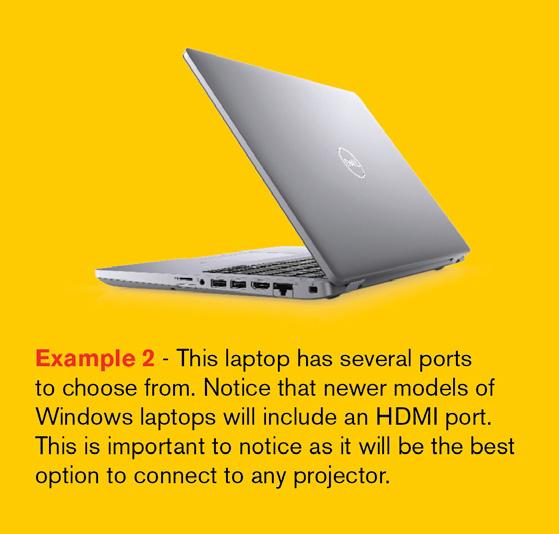


Example 3 - Newer models of Mac laptops will only have USB-C/Thunderbolt port. The technology allows this port to be used not only as an output for video and audio, but also as a data transferring and charging port.
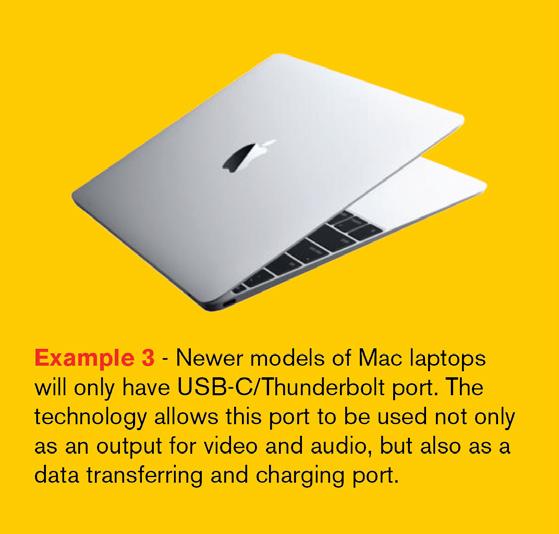
data ports a laptop is likely to have.
As mentioned before, try to get familiar with your equipment specifications. Example 1 on the previous page is an example of a Windows computer.
If you use a Mac laptop (Example 3), you will notice that the video output ports vary from model to model. If your Mac laptop is a few years old, you may be in luck and have an HDMI port. Newer models have adopted the USB-C/Thun derbolt port. Remember! Don’t assume that all laptops are the same just because they are Windows or Mac. Specifications and components change very frequently.
Second, know your opponent, the projector (Example 4). Depending on the type of projector available, it can be a tricky process connecting it to your computer, especially if you don’t know what cable or adapter to use. A projector supports quite a few different types of connections, but to make our lives easier, let’s focus on the two most common connection types that most projectors have, VGA and HDMI.
The HDMI connection is currently the most common. Nearly all modern monitors and projectors feature HDMI ports. Most laptop computers support HDMI, and it’s becoming more prevalent on desktop computers. If your Windows laptop has an HDMI port, you can connect directly to the projector using only an HDMI cable. If you are using a Mac laptop on the other hand, you will likely need an USB-C or Thunderbolt to HDMI adapter. The same is true if the projector has a VGA input and your computer has a VGA port. In most other cases, you will need an adapter. Bear with us! It’s a lot less complicated than what it sounds.


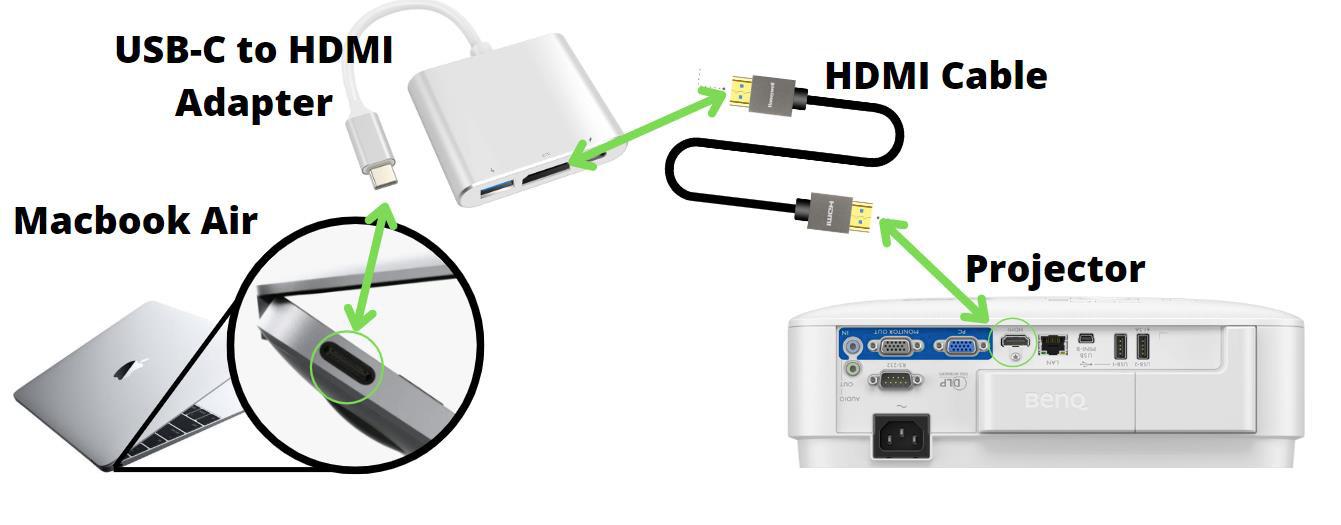
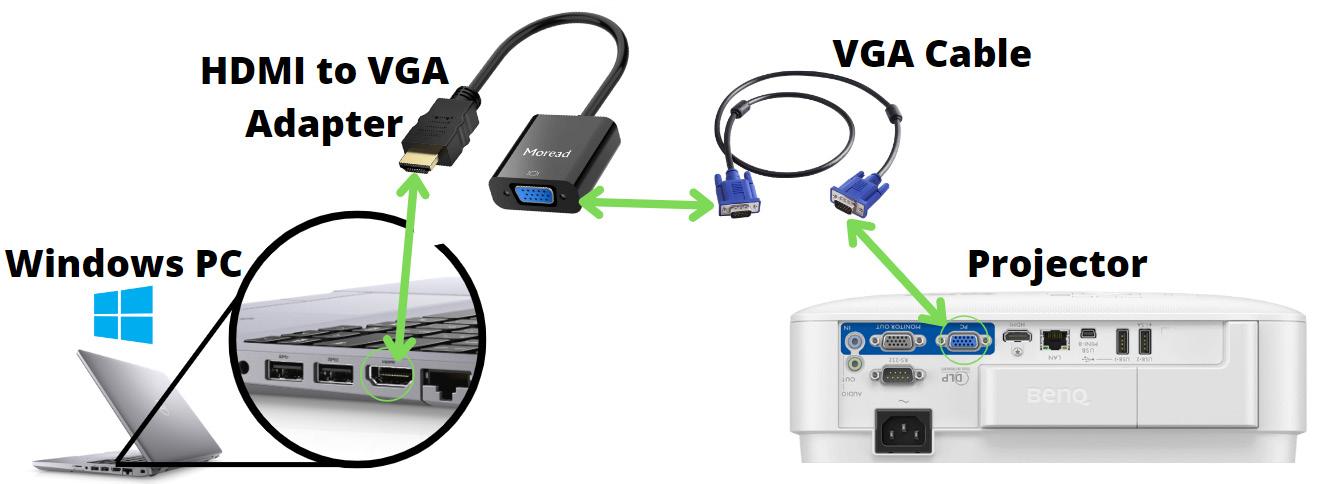

Now let’s get to the main reason why we’re here, connecting the projector. The projectors available at most venues support VGA and/or HDMI. The adapter and cables you’ll need will depend on YOUR laptop. First, identify the connec tion ports on your laptop and the projector. Once you identify the ports it will be easier for you to know if you will need just a cable, an adapter, or both.
See Example 5 on the left of the page. Both the Windows computer and the projector have an HDMI port. The connection can be done using only an HDMI cable.
Older models of projectors will only have a VGA Port. To successfully connect your computer, you will need an adapter. See Example 6 on the left of the page.
The setup for a Mac laptop is similar depending on the model. Some Mac laptops feature that HDMI port. Let’s see an example of a Mac laptop with an HDMI port setup on the previous page Example 7.
You probably noticed that the setup is exactly the same for both Windows and Mac when the laptop and projector have an HDMI port. All that is needed is just one cable.
Newer Mac laptops (Air Models) don’t have an HDMI port. Instead, they use a USB-C/Thunderbolt port. For this setup, you will need a USB-C/Thunderbolt to HDMI adapter. See Example 8 pn the previous page.



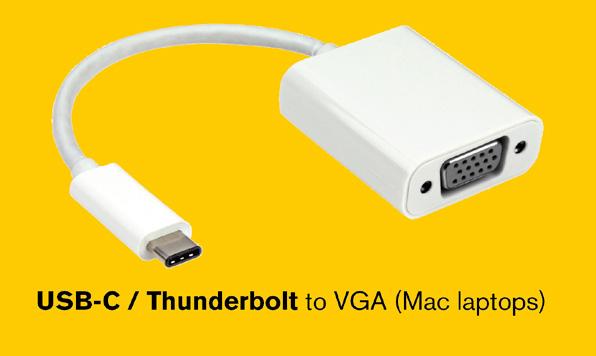
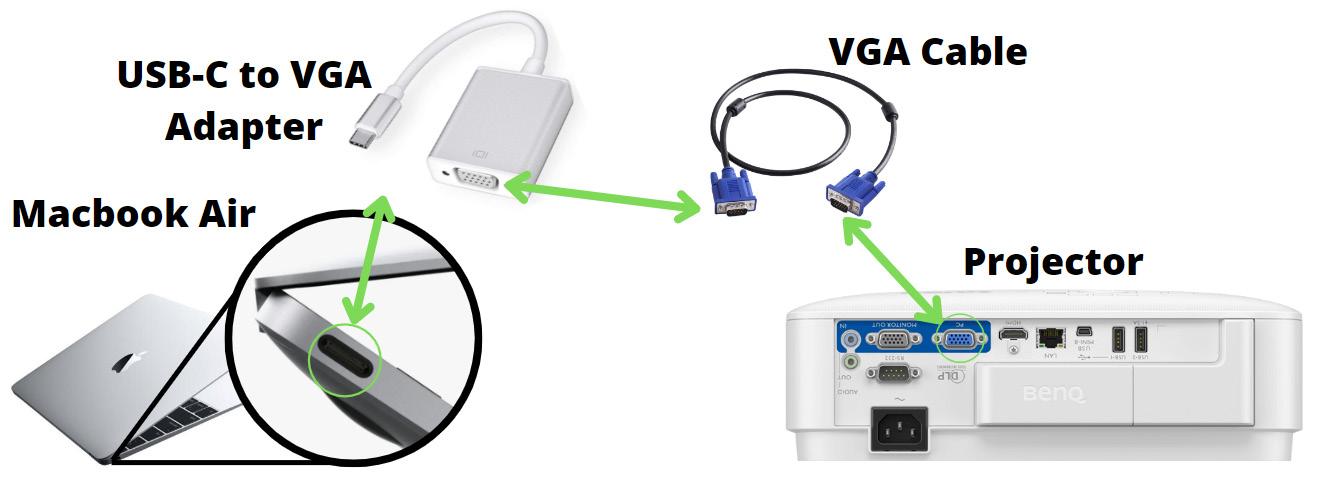


When you’re dealing with an older model of projector, you will have a VGA port only. For this type of connection, you will need a VGA adapter. See Example 9 above.
That wasn’t that complicated, right? Think of it this way, you will need one of two types of cables, an HDMI or VGA cable. Depending on your laptop you might need an adapter. Overall, there’s only 3 components that you should always account for, your laptop, your adapter and your HDMI or VGA cable. A great idea is for you to create your own travel kit with all the components you will use. Adapters and cables are very affordable, so having a couple of each is highly recommended. Just in case a colleague calls you at the last minute asking you for an adapter…
On the right are the recommended adapters and cables that you should have on your travel kit.
Troubleshooting Tips -
Even when you know you’re prepared to deal with every cable conundrum, other things can go wrong. No worries, we got that covered too. It may sound trivial and somewhat comical, but typically the most common issues with projectors are the simplest to fix. The following are some of the most frequent
issues that create havoc when trying to connect your laptop to a projector. Following these tips and tricks will ensure that your presentation gets back on track quickly and easily.
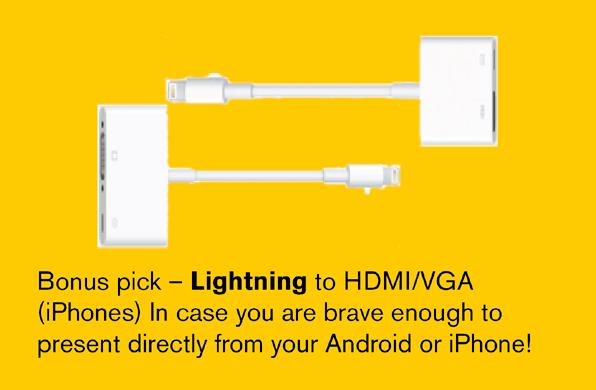

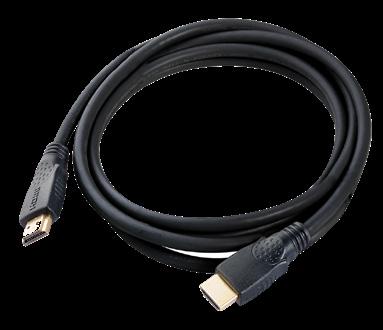
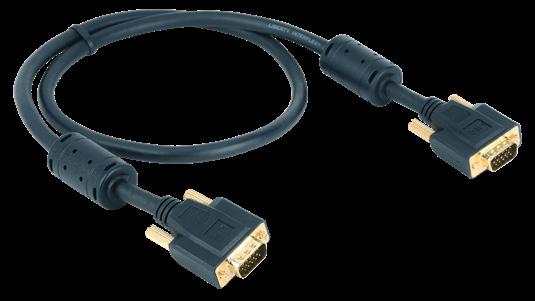
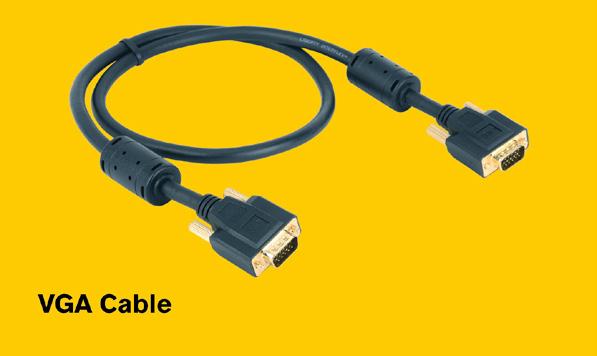
• Check for loose cables. This is the most common reason why things don’t work!
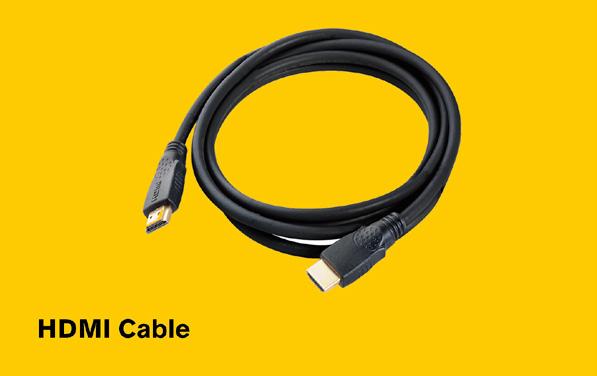
• Check that the projector is connected to a power source.
• Check that the projector doesn’t have the lens cap on! (You’ll be surprised how many times this is the issue).
• Check that the cables are connected on the correct port.
• Check that the correct input is selected on the projector - most projectors have multiple inputs for VGA, HDMI, HDMI2, Computer 1, Computer 2, etc. Make sure that the selected input is the one connected to your computer.
• Try a different cable or adapter (this is where having two of everything really comes in handy).
• As a last resort, power cycle your equipment. A simple restart of your computer will work wonders.
Having had the opportunity to be involved in the world of festivals and events for the past 22 years, I can sincere ly say that I have probably seen every type of technical issue known to presenters. Trying to keep up with the ever-evolving technology trends and innovations has always been challenging but extremely fun. When attending a conference, whether as a presenter or attendee, I always keep my tech travel kit with me. It has saved the day for several colleagues and the best part is it has given me the opportunity to meet amazing people.
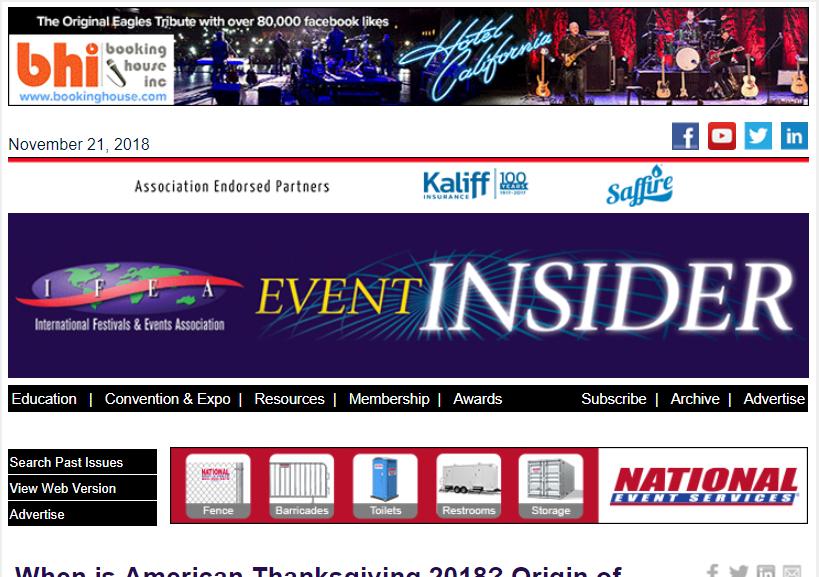
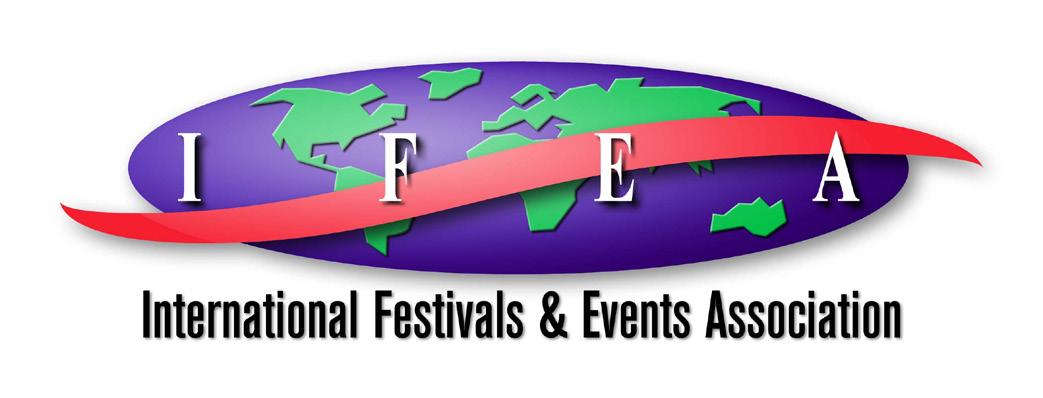
In an industry with an annual spend of 1 trillion in the United States, you need to reach industry buyers everyday wherever they go online. With these digital opportunities, you’ll be able to reach top-tier festival and event professionals through the IFEA Event Insider, Event Resource Marketplace, and IFEA website box ads, as they explore ways to improve their business.
Reaching over 6,500 festival and event professionals, these premier placements will give your company the attention it deserves. The newsletter will focus on news and information that professionals need to run a successful business. That means your message will reach the decision-makers you’re looking to target.
Digitally distributed each week
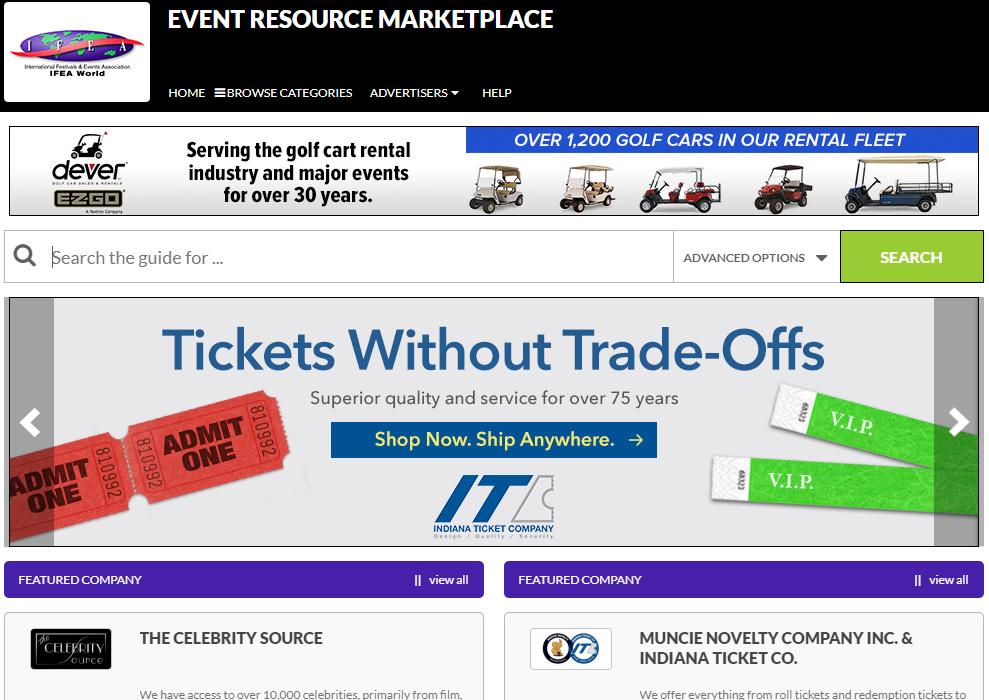
More advertising opportunities designed to fit any marketing budget are within the Event Resource Marketplace. Festival and event professional buyers count on the guide to put them in touch with suppliers for all their project needs, and the ads help lead them to you.
Viewable online, 24/7
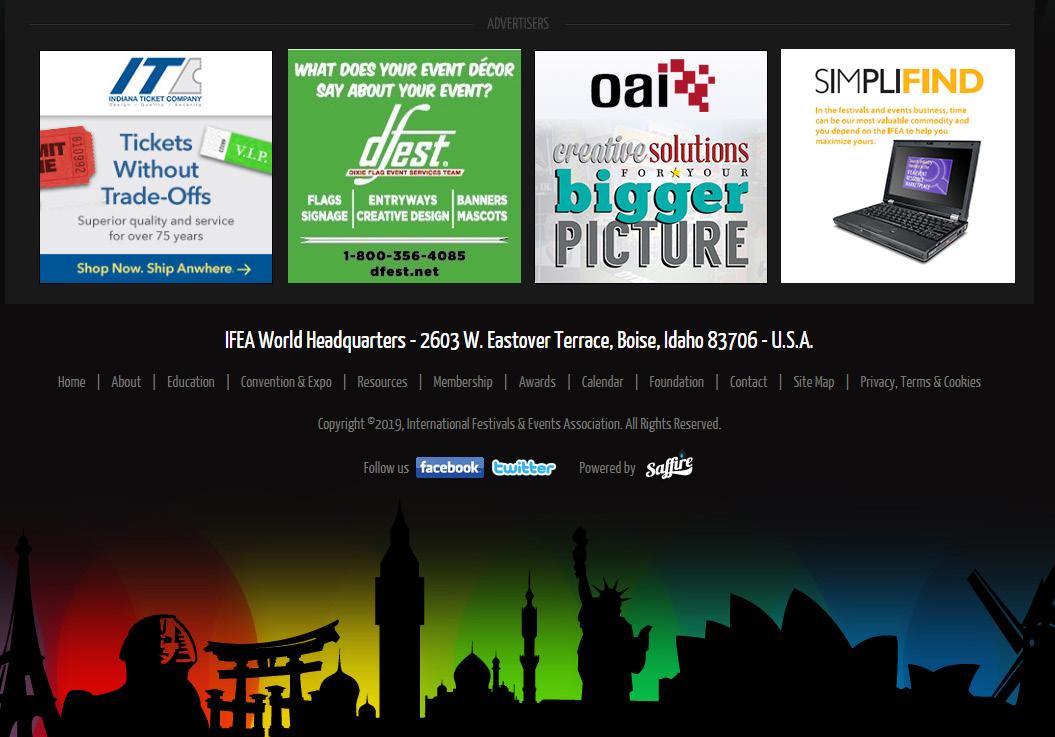
Highlight your core message and drive traffic to your website with exlusive positions on the IFEA website. These box ads will occupy prime real estate to help sell your products and services to industry decision-makers. Retargeting opportunities are available as well, allowing your ad to be seen AFTER the festival and event professionals leave the association website.
Viewable online, 24/7
IFEA has partnered with MultiView to provide these advertising opportunities. For more information about them, contact salesinquiries@multiview.com or call 972-402-7000. For more information about IFEA, email kaye@ifea.com or call 208-433-0950 ext: 1

Does it feel like no matter how hard you try to please your customer, it isn’t enough? Are you in charge of leading others and the faster you train teams and build energy, the quicker it seems to fade? Are you a business owner feeling hopeless about the never-ending needs of staff AND custom ers while trying to achieve a profitable bottom line? You’re exhausted, right?
This exhaustion is what’s called service fatigue, defined as that feeling that keeps you from delivering the excellent customer service your staff and patrons have come to expect. Left unchecked, this weariness can impact your business in many negative ways, from short tempers to lost business.
Let’s unpack the what, where, why, and how of service fatigue and get on the path to busting out of it.
You know what customer service deliv ery should look like. Attentive. Proactive. Genuine. Service fatigue is “less than,” and it presents in many forms. It’s when your customer experience is less than you—or they—expect. It’s a lack of energy, elevated stress, constant ambivalence, difficulty concentrating, missed deadlines, frequent mistakes, or safety compliance issues. The trickiest kind of service fatigue to spot is the kind the team thinks they can hide from guests. It’s still there, lurking beneath the surface, threatening to bring everyone down in its undertow.
After a stressful few years, various challenges have caused service fatigue levels to skyrocket. But the truth is, service fatigue can strike at any time, and much of it is really nothing new. It’s short-tempered customers who escalate to anger quickly. It’s trying (and usually failing) to juggle multiple priorities at a time. It’s navigating ever-changing business policies. It’s responsibilities that outnumber hours in the day. It’s one bad attitude draining a team’s morale. Service fatigue can come from anywhere and knowing how to identify it is half the battle.
The short answer: It matters because it impacts your bottom line. When service fatigue takes over at your business, everything is at risk. You can play a huge part in lessening that burden for your team and your customers. If it’s possible, make work a welcoming, encouraging environment for your staff so they can give your customers a reason to crow about the great experience they had. By recognizing service fatigue and equipping your team with the tools to bust out of its grip before it’s too late, you’ll ensure that everyone’s experience is that much better.
There are countless ways to bust out of service fatigue, and no two businesses will adopt exactly the same solution. Decades of experience in the customer service industry prove that there’s no silver bullet to finally overcoming exhaustion. Instead, it takes a combination of strategy, patience, and commitment to bolster your team and get them back on track to deliver the kind of remarkable customer service you and your customers expect.
To get you started, here are a few ways to start busting out of service fatigue as soon as today:
Professional boundaries can be the single best tool to help bust out of service fatigue, whether you need to put them in place with your boss or you need to ensure your team knows that work/life separation is a good thing. Unless it’s imperative to your industry, do you really need to reply to emails at 8 p.m.? Is that gap or hiccup in a process at work really yours to lose sleep over?
We all can and should go above and beyond to deliver customer service excellence. But when you’re doing far more than is expected, you may be bringing service fatigue on yourself. Be honest: Are you guilty of your own boundary breakdowns? Are there honest conversations you can have to get those
boundaries—and your energy levels—back on track?
Re-evaluate your boundaries today and find where you can firm them up. You’ll soon see what a difference they make in boosting your energy and positive attitude.
Grant Yourself Rest!
Who doesn’t love rest? While some have mastered the art of taking breaks, Americans tend to do things fast—and often multitasking. We like the concept of rest, but the demands on our time often get in the way of our ability to truly take a break.
There are as many as seven types of rest, from physical and emotional to creative and spiritual. The truth is, they’re all important, and giving ourselves the space to breathe when things get stressful is imperative. Rest can mean putting down your phone an hour early and reading a book instead, or using your shift break to do a brief silent meditation so you’re prepared to head back to work.
When we prioritize rest and start to see it as doing good for ourselves, we are more energized to deliver customer service excellence.
Bonus: When Do I Need to Address Service Fatigue?
No surprises here: If you recognize the signs of service fatigue, now is the time to bust out of it! Start by identifying what’s causing the fatigue, then set aside time to plan for change, including both big and small steps to reinvigorate your team and return to delivering customer service excellence. When you commit to the change, the hardest part is already over. All it takes from there is digging in to bust out of service fatigue once and for all!
A Hall of Fame keynote speaker and author, Laurie Guest, CSP, CPAE, is an authority on customer service excel lence. Laurie blends real-life examples and proven action steps for improve ment. She is the author of two books and is writing a third on the topic of ser vice fatigue. To learn more or connect with Laurie, visit www.LaurieGuest.com
The IFEA Foundation “Fund for the Future” provides critical funding to ensure that the IFEA has reserves in place to protect against future economic shifts and realities in a constantly changing world! It allows the orga nization to keep pace with new and changing
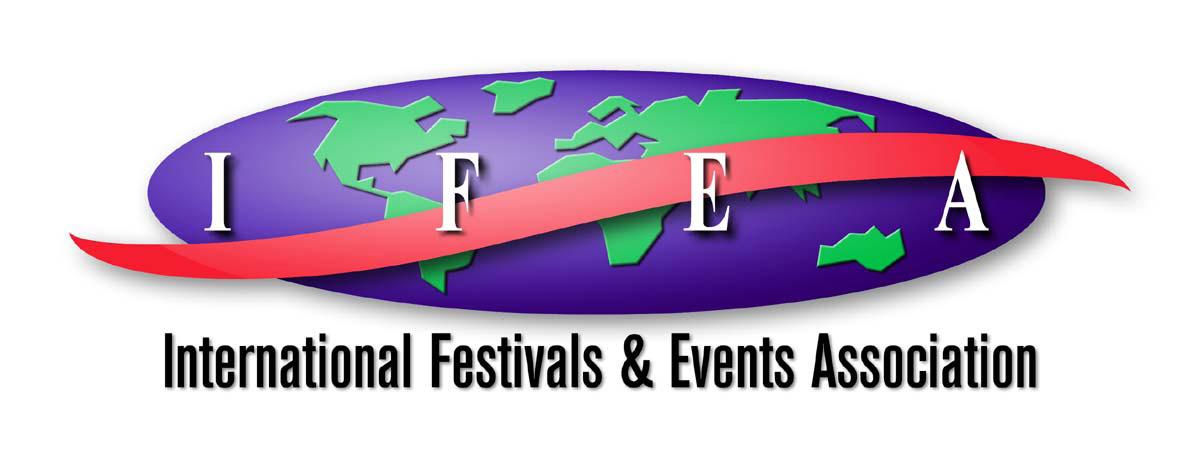
technologies necessary to communicate with and serve our global industry and it supports a continued expansion of our services, resources, programming and outreach around the world. In a nutshell… it enables those who power celebration.

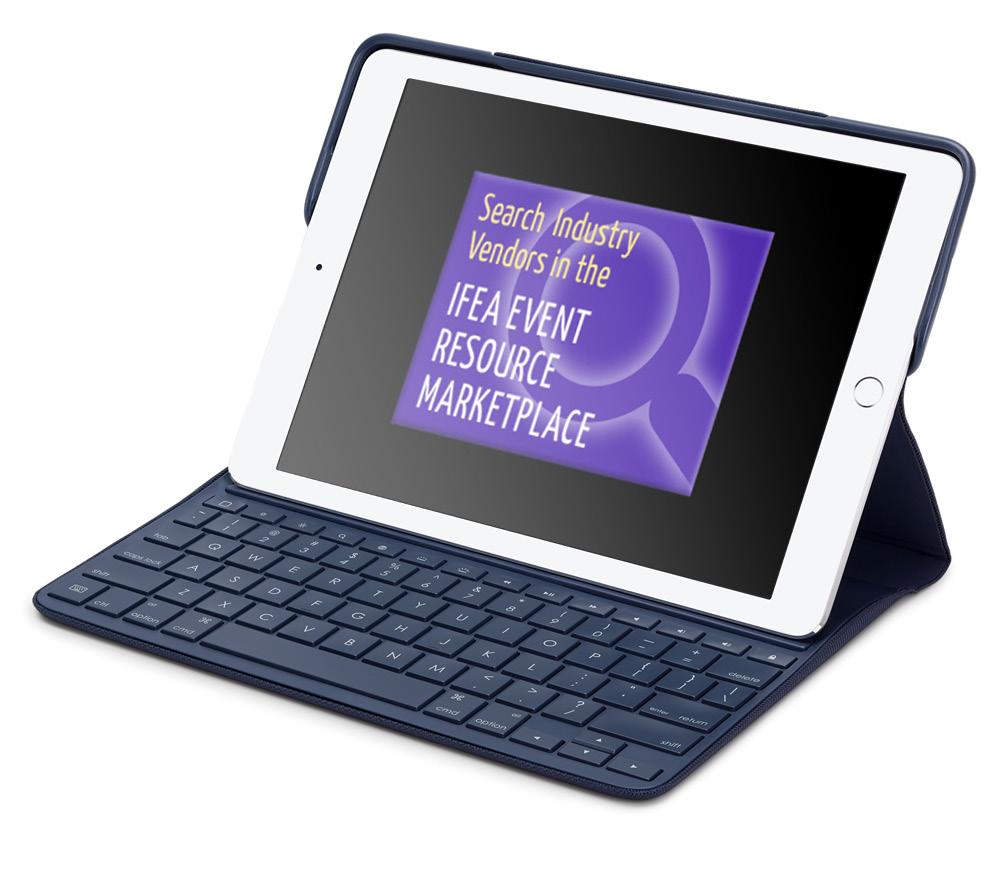
ARTIFICIAL ICE EVENTS / FALL FEST EVENTS - Unique Winter and Fall attractions for rent nationwide. Available for short-term or long-term needs. Synthetic ice rinks to haunted houses! Contact: Michael Lawton | Peabody, MA USA | 800-275-0185 | m.lawton@ppentertainmentgroup.com | www.artificialiceevents.com
DFEST ® – Designs and manufactures creative decor solutions for festivals and events. We specialize in custom flags, banners, directional signage, entryways, street banners, installation and hardware. Contact: Rudy Martinez | San Antonio, TX USA | (800) 356-4085 | rudy@dixieflag.com | www.dixieflag.com
FIRST DATA / CLOVER – Cloud-based point of sale and full business solutions for cash or cashless events. Clover is uniquely designed to be customized to fit your business needs. Clover accepts all payment types - EMV/ Chip, Card Swiped, Keyed and Apple Pay/Google Pay. Clover’s product line is available with WIFI, ethernet, or 4G/LTE data connectivity and can be leased, purchased or rented month-to-month. First Data has exclusive pricing for hardware and card processing for the festivals and events industry. Contact: Tina Hollis | Riverview, FL USA | 239-287-8221 | tina.hollis@firstdata.com | www.firstdata.com
HISTORICAL EMPORIUM – Historical Emporium specializes in authentic, durable, high quality historical clothing and accessories. Victorian, Edwardian, Old West and Steampunk for men and women. Since 2003. Contact: Noel Matyas | San Jose, CA USA | (800) 997-4311 | amusement@historicalemporium.com | www.historicalemporium.com
ATOMIC – Set construction, backdrops, rental solutions, lighting and design. Packs small, plays BIG! Address: Lititz, PA 17543 USA | Phone: 717-626-8301 | Email: info@atomicdesign.tv | Website: www.atomicdesign.tv

DEGY BOOKING INTERNATIONAL – Degy Entertainment is a worldwide talent buying agency specializing in customer service and professionalism. Contact: Evan Schaefer, CSEP, CFEE | Delray Beach, FL 33446 USA | 732-818-9600 | evan@degy.com | www.degy.com
EVENTENY – Eventeny was built to help festival & event organizers manage their vendors, artists, exhibitors, volunteers, and sponsors, all in one platform. You can create team workflows,
applications, maps, schedules, surveys and so much more. From small community festivals to managing multi-day sci-fi conventions, to virtual events, we’ve got it all!
Contact: Greg Wright | Address: Peachtree Corners, GA 30092-2936 USA | Phone: 314-471-6079 | Email: greg@eventeny.com | Website: www.eventeny.com
EXPOCAD - EXPOCAD® professionally manages the map and placement of vendors and exhibitors for festivals and events. Process payments, contracts, sponsorships and promote exhibitors via customized listings on the directory and interactive map available on desktop and mobile devices. Ask us about ELI, an event location interactive tool that will pinpoint locations of incidents for operations or security concerns to stay ahead of growing threats domestic and abroad. Contact: Jason Puetz | Aurora, IL USA | 630-405-2081 | jason@expocad.com | www.expocad.com
POINTSMAP® – PointsMap® has proven to be an effective and useful software for Festivals and Events. Create custom points at their exact location on your PointsMap with photos, descriptions, website links, multi-media, PDF’s and even “inside maps”. Your visitors can “PLAN” before the festival using their desktop computer, and then “NAVIGATE” the festival using their Smartphone. Visit www.PointsMap.com/SLAF and http://www.PointsMap. com/WichitaRiverFest/ to see how PointsMap is being used. It’s easy to use and extremely affordable. Contact: Jerry Waddell | Chattanooga, TN USA | 423-894-2677 | jerryw@videoideas.com | www.pointsmap.com
SPONSORCX – Streamline your sponsorship management workflow into one simplified, easy-to-use platform that can be fully customized to fit your festival and event needs and offers end-to-end control of your program. Access substantially discounted rates through your IFEA membership! Contact: Jeff Hicks | American Fork, UT USA | 801-867-5215 | jeff@sponsorcx.com | www.sponsorcx.com

DYNAMIC DISPLAYS / FABULOUS INFLATABLES – Designs, manufacturers, for rent or purchase – costumes, props, floats, helium balloons, event entry ways and décor. Offers complete and flexible service packages for small towns and large international events. 50+ years of parade/event experience. Contact: Steve Thomson | Dearborn, MI USA | 800-411-6200 | steve@fabulousinflatables.com | www.fabulousinflatables.com
HAAS & WILKERSON INSURANCE – Celebrating over 80 years in the entertainment industry, providing insurance programs designed to meet the specific needs of your event. Clients throughout the US include festivals, parades, carnivals and more. Contact: Andrew Vandepopulier | Fairway, KS USA | 800-821-7703 | andrew.vandepopulier@hwins.com | www.hwins.com
KALIFF INSURANCE – Founded in 1917, Kaliff Insurance provides specialty insurance for festivals, fairs, parades, rodeos, carnivals and more. We insure the serious side of fun! Contact: David Olivares | San Antonio, TX USA | 210-829-7634 | david@kaliff.com | www.kaliff.com
K & K INSURANCE – For 60 years, K & K insurance has been recognized as the leading provider of SPORTS-LEISURE & ENTERTAINMENT insurance products. Contact: Mark Herberger | Fort Wayne, IN USA | 1-866-554-4636 | mark.herberger@kandkinsurance.com | www.kandkinsurance.com
VORTEX INSURANCE AGENCY - Vortex Insurance provides weather index insurance to help minimize revenue loss due to rain, heat, cold, snow or a combination of weather elements. Contact: Andrew Klaus | Overland Park, KS 66213 USA | 913-253-1215 | aklaus@guaranteedweather.com | www. vortexinsurance.com
WEVOW – Build a culture that elevates thinking above sexual misconduct. Year-round and seasonal programs available for both staff and volunteers. Contact: Matt Pipkin | Boise, ID 83702 USA | 208-830-3885 | matt@wevow.com | www.wevow.com


– Afton Tickets has set out to change the ticketing industry. We provide more features and better service to our clients and have simplified the entire ticketing process. We offer low and honest services fees to the customer, provide on-site Afton staff at events, 24/7 client support, state of the art scanners
and box office equipment, and thermal ticket printing. Contact: Ryan Kintz | OR 97214 USA | 503-559-6183 | ryan.k@aftontickets.com | www.aftontickets.com
SAFFIRE – Saffire empowers clients with beautiful, unique and engaging websites that are easy to manage, with integrated SaffireTix ticketing and unlimited help when you need it. Contact: Cassie Dispenza | Austin TX USA | 512-430-1123 sales@saffire.com | www.saffire.com
TRIP Info com – Since 1996, first online reference for all segments of group travel planners – website and weekly newsletter and subject-specific digital magazines – including festivals. IFEA Member organizations included online. Contact: Mark Browning | Johns Creek, GA USA | 770-825-0220 | mark@tripinfo.com | www.tripinfo.com

SAFFIRE – Saffire empowers clients with beautiful, unique and engaging websites that are easy to manage, with integrated SaffireTix ticketing and unlimited help when you need it. Contact: Cassie Dispenza | Austin TX USA | 512-430-1123 | sales@saffire.com | www.saffire.com Streamline your sponsorship

The IFEA Foundation provides an all-important source of support that allows the IFEA to confidently provide convention scholarships, host top-quality industry presenters, speakers and programming, and help raise the bar for everyone in our global industry. A very special thanks to all those who have contributed along the way, and we look forward to working with you towards the success of our industry for many years to come.
www.ifea.com/p/foundation
